Wabash

MAGAZINE THE JOURNAL OF WABASH COLLEGE | FALL 2022 HOME

In southwest Ireland, the Burren in County Clare is a 100 square-mile region of flatland covered in crags, cracks known as “grikes,” and stand-alone rocks known as “clints.” The rocky land creates dramatic cliffs that drop into the Atlantic Ocean.
Members of the seventh cohort of the Wabash Pastoral Leadership Program visited the Burren as part of its study tour of “The Troubles” in Ireland and Northern Ireland. Read more about the study tour on page 48.
photo by Kim Johnson

DIRECTOR OF COMMUNICATIONS AND EDITOR, WABASH MAGAZINE
Kim Johnson | 765-361-6209 | johnsonk@wabash.edu
DIRECTOR OF MARKETING AND MEDIA RELATIONS
Richard Paige | 765-361-6377 | paiger@wabash.edu
ART DIRECTOR
Becky Wendt | 765-361-6026 | wendtb@wabash.edu
CLASS NOTES EDITOR
Karen Handley | 765-361-6396 | handleyk@wabash.edu
COMMUNICATIONS SPECIALIST
Allie Northcutt | 765-361-6067 | northcua@wabash.edu
CONTENT PRODUCER AND SOCIAL MEDIA SPECIALIST
Anna Tiplick | 765-361-6087 | tiplicka@wabash.edu
ATHLETIC COMMUNICATION DIRECTOR

Brent Harris H’03 | 765-361-6165 | harrisb@wabash.edu
DIRECTOR OF CINEMATOGRAPHY AND DIGITAL VIDEO
Andrew Day | 765-361-6390 | daya@wabash.edu
WEBSITE EDITOR AND BROADCAST ENGINEER
Adam Phipps ’11 | 765-361-6251 | phippsa@wabash.edu
DEAN FOR COLLEGE ADVANCEMENT
Michelle Janssen | 765-361-6152 | janssenm@wabash.edu
DIRECTOR OF ALUMNI AND PARENT PROGRAMS
Steve Hoffman ’85 | 765-361-6371 | hoffmans@wabash.edu
CHIEF OF STAFF AND DIRECTOR OF STRATEGIC COMMUNICATIONS
Jim Amidon ’87 | 765-361-6364 | amidonj@wabash.edu
CONTRIBUTING PHOTOGRAPHERS Jim Amidon ’87, Elijah Greene ’24, Kim Johnson, Allie Northcutt, Jacob Paige ’23, Richard Paige, Tom Runge ’71, Anna Tiplick, Becky Wendt , John Zimmerman H’67
ADMISSIONS INFORMATION 765-361-6405 / 800-345-5385
WABASH ALUMNI CLUBS 765-361-6369
EDITORIAL ADVISORY BOARD Greg Britton ’84, Editorial Director, Johns Hopkins University Press; Tim Padgett ’84, America’s Correspondent, WLRN-Miami Herald; Eric Freeze, Associate Professor of English; Richard Elson ’69, filmmaker; Mark Shreve ’04, Client Development Executive, Educator Advisory Board
Wabash Magazine is published by the Communications and Marketing Office, Hovey Cottage, P.O. Box 352, Crawfordsville, IN 47933-0352. We welcome your comments, criticisms, and suggestions. Contact the editor at 765-361-6209 or johnsonk@wabash.edu.
Wabash College educates men to think critically, act responsibly, lead effectively, and live humanely.
wabash.edu/magazine
4 WABASH MAGAZINE
 photo by Becky Wendt
photo by Becky Wendt
5
Members of Purdue University’s ROTC program presented the colors at the October 29 football game. Wabash ROTC students were on the field for the presentation. Wabash became Purdue’s first partner institution in 2020.

CONTENTS FEATURES 34 Homecoming 38 Framing House and Home by Derek Nelson ’99 42 Little Place Farm by Fred Wampler ’57 44 Finding Home in the Backyard by Kim Johnson 46 Reimagining Home by Kim Johnson 48 (Peace) Walls by Kim Johnson 54 Advocating for Afghanistan by Allie Northcutt 57 On the Move by Allie Northcutt
ABOUT THE COVER
Alex Ngaba ’24 fled the Central African Republic with his family when he was a child. After several years living in a refugee camp in Cameroon, the family relocated to the United States. He went on to graduate as valedictorian at George Washington High School in Indianapolis in 2020. The Wabash junior is thriving in his new home at Wabash.
Read more about Ngaba on page 20.

DEPARTMENTS 8 Behind the Stories | Karen Handley 10 From the Editor 11 From Our Readers 12 From Center Hall 14 Moments 20 Works in Progress | Alex Ngaba ’24 23 Speaking of Sports | Ben Netting ’25, Will Netting ’25, Connor Thompson ’25, Liam Thompson ’24 26 Season in Sports | Justin Kopp ’21 30 Big Question 58 Class Notes | Hovey Cottage by Nolan Eller ’11 | Home by M. Kip Chase ’03 | Home Away From Home by Steve Hoffman ’85 Remembrances | Arthur R. Baxter ’56 | John B. Goodrich ’68 | John Louis Ryder ’71 | James L. Engledow ’78 | Jay Newman Rice ’86 | Brian Scott Dillman ’95 | Marion Powell H’55 76 Voices | The Tallgrass’s Last Few Shadows | A Love Affair | On Love, from the Heart of a Little Giant 81 Faculty Notes | John Zimmerman H’67 | Quick Notes 84 Bookshelves | Yao Li 88 Last Glance
photo by Anna Tiplick
photo by Jacob Paige’23
WABASH.EDU 7
AJ Miller ’23 soaks up Prague’s art scene at the Prague National Gallery. Miller and his classmates in Costume Designer Andrea Bear ’s Theater 303 Study in Czech Puppetry course spent a week in the Czech Republic with a master carver in November.
Home is Where Your Heart Is.
i interviewed for a position as secretary in the Public Affairs office in October 1978. I was a naïve 19-year-old. I had attended Ivy Tech College in Lafayette and was returning to Crawfordsville where I grew up and graduated from high school.
I met with Don Sperry ’59, Don Dake, and William Stout H’37. Wow! They were impressive to a young girl, but they made me feel welcomed and at home. I received a call the next day from Mr. Dake and was offered the job. I was so excited. I never dreamed I would be at Wabash 44 years.
Lewis Salter H’57 had just been inaugurated as president. I started on one of the last Elmore Days—a tradition where the president would randomly choose a day each year to close the College and cancel classes. But, I had to be there anyway and so did secretary Guyanna “Guy” Fairchild Spurway.
I had to get a press release out and was using an automatic typewriter for the first time. I got it all typed and then lost everything! Guy heard me crying upstairs in Kane House and came to my rescue. It is people like her who make Wabash so special.
In the mid-80s I worked with Brad Boyd ’75 and John Kerezy ’77. At that time, Wabash Magazine was known as Wabash Quarterly. They would write the articles and I would type them. I had guidelines the width of each column that I would put behind the paper on the typewriter to make sure I stayed within the column. We then cut them out, hotglued them to the magazine form, and sent it off to the printer.

We have come a long way!
In 1987, Director of Development Richard Ristine ’41, hired a young new graduate, Jim Amidon ’87. It was the best thing he could have done for the College. Jim has worked so hard for Wabash. We worked alongside another wonderful person, Susan Cantrell. Susan and Jim helped me better myself and gave me wonderful advice through the years.

8 WABASH MAGAZINE
Behind the Stories | FALL 2022
I served several presidents during my years at the College: Salter, F. Sheldon Wettack, Andrew Ford H’03, Patrick White H’10, Gregory Hess H’19, and Scott Feller. They are great men who have all loved this place.
A special shoutout to Steve Charles H’70, former editor of the Wabash Magazine, who encouraged and believed in me to write the Class Notes for WM

My husband, Randy, and our daughter, Sarah, also became part of the Wabash family and attended several memorable events at the College. Some of my most special memories were the campaign reception with confetti cannons (ask Brent Harris H’03); the 1982 basketball national championship season with Mac Petty H’82; many Monon Bell games— both the wins and losses; and fireworks over the Chapel.
When Sarah was young, she loved dressing up as a cheerleader in red and white to cheer at the basketball games. She had to get popcorn from Rob Johnson H’77 at every game. He always took the time to speak to her and make her feel important. She got married in Pioneer Chapel in 2013, and had her reception at Sparks Center. Wabash has become home to her also.
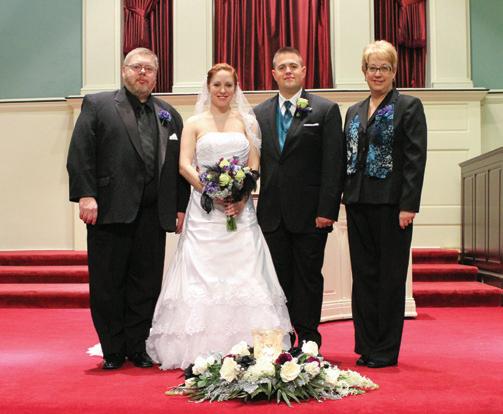
So many people, in addition to those already mentioned, have been exceptional to me and my family during my tenure at the College: Don Herring ’84, Nancy Doemel H’91, Joe Emmick ’92, Robert Mitchum H’59, Gail Pebworth H’91, Vic Powell H’55, Judy Schmitt H’95, Horace Turner H’76, Carolyn Harshbarger, and Rhonda Maynor.

I have mixed feelings about retiring from the College. I’m ready for the next chapter in life, but I also know I’m going to miss Wabash and the wonderful people I have met and worked with here.
Lastly, I will miss my co-workers in communications and marketing (previously public affairs): Kim Johnson, Richard Paige, Andrew Day, Allie Northcutt, Adam Phipps ’11, Anna Tiplick, and Becky Wendt. They each love this place as I have. They work hard to promote Wabash. I hope they are making wonderful memories of this special place and its people as I have through the years. I hope they make this their home, too.
Karen Linn Handley | Retired Senior Administrative Assistant Communications and Marketing Class Notes Editor, Wabash Magazine
Karen Handley retired at the end of 2022 after 44 years of service to Wabash College. WM and everyone at Wabash are thankful for her decades of dedication and attention to detail. Join us in thanking her by sending an email to handleyk@wabash.edu. She is Some Little Giant!

WABASH.EDU 9
background photo by Emmanuel Ikwuegbu on Unsplash
Silence in the Croí
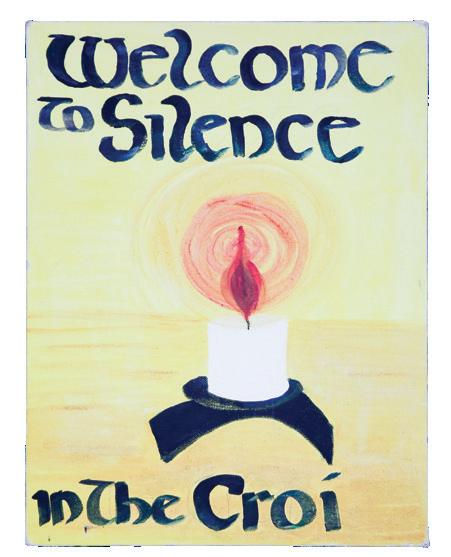
in october, I traveled alongside a group of pastors in the Wabash Pastoral Leadership Program (WPLP) to Ireland and Northern Ireland. Funded by Lilly Endowment Inc., WPLP brings together small cohorts of early-career pastors in Indiana to meet regularly for two years. The pastors engage in conversations and learning with influential state and community leaders.
At the conclusion of the two years, each cohort takes an international study tour. The 10-day trip for this group was studying “The Troubles,” three decades of violence in Northern Ireland and Ireland that led to more than 3,500 deaths. We visited Dublin, Belfast, and Derry and spent several days at Corrymeela, a residential retreat center focused on peace and reconciliation on the coast of Northern Ireland near Ballycastle.
Every day at Corrymeela begins with silence in the Croí (pronounced kree). Croí is Irish for “heart” but at Corrymeela it is also a small, rotund space lined with chairs and pillows. For 20 minutes after breakfast, there is silence. People may come and go, pray, write, read, meditate.
The first day, as I sat with my eyes closed, I noticed there was nothing quiet about the silence. There was coughing and fidgeting, heavy sighs, shuffling, squeaky shoes, sniffles. The second day, I kept my eyes open. I watched as others around me shifted in their seats, struggled with what to do with their hands, peeked at a watch, or came in near the end.
What was supposed to be a quiet time of reflection and restoration was instead yelling at me to hear something else—the dichotomy of silence.
One of the pre-readings for the pastors’ study tour was “Say Nothing: A True Story of Murder and Memory in Northern Ireland” by Patrick Radden Keefe. In it, the unfolding of The Troubles is laid out through the stories of many whose lives were deeply entrenched in the violence and uncertainty of the time. The geopolitical and religious uprising pitted Catholics and Protestants against each other in a struggle for civil rights and freedom from British rule.
So, silence became safety, but it also let terror reign.
Corrymeela is a gathering place with open tables and honest conversation focused on peace and reconciliation. The idea is, “Together is better.” It was not uncommon during The Troubles for the Protestants and Catholics to sit around the tables at Corrymeela and become friends, or at least come to realize they weren’t all that different from one another and could find common ground to live in shared space.
Alex Wimberly ’99, the leader of the Corrymeela community, appreciates the home he has found in Ireland and the genuine nature of the Irish to want to connect with each other.
“I joke that my first pastorate was in Pennsylvania, but I felt more at home in my second calling in the church in Ireland, than I did in my first, even though I was thousands of miles away.
Much of the rhetoric of The Troubles described at the beginning of the book frighteningly mirrors the rhetoric and lack of civil discourse in the United States today. For many Protestants and Catholics of Northern Ireland, the goal was to say nothing—to let no one know who they were or where they came from. Knowing could mean connection, if they disclosed their identity to the right person. It could mean death otherwise.
“My experience living in Ireland is that the people I interact with have a natural curiosity and a desire to figure out what our connection to one another is,” he says. “There was a benevolence about wanting to know how I can find my connection with you. I found that very welcoming instead of being intrusive.”
Throughout the time abroad we were challenged by the stories others shared and explored how the silence of the community and the church contributed to The Troubles and how that translates into our own communities in Indiana.
“What does our own silence say in the face of deep divisions in our communities?” challenges Libby Manning, director of the Wabash Pastoral Leadership Program.
From the Editor | FALL 2022 10 WABASH MAGAZINE
when we first started working on this issue of Wabash Magazine, I thought it was going to be easy to pull together. Stories of home are uplifting—my editor’s note was writing itself: The smells and warmth of the holidays, my dog greeting me with kisses when I get home each evening, and my daughter’s latest middle school production of “Wizard of Oz” complete with the closing line, “There’s no place like home.”
I’ll be honest, I’ve struggled with this one. I had a wonderful childhood. I am the middle child, so that means I had an older sibling AND a younger sibling to hang out with so I was never bored; in trouble sometimes, but never bored. We needed for nothing. Even when money was tight, we had lots of laughter and extended family around our table. I never doubted that I would be fed, safe, and unconditionally loved.
I know that’s not the case for everyone. But working on this issue, I have been particularly aware that the idea of home for some is not always positive. And it’s never always positive for anyone.
Life is messy and complicated. Conflict, misunderstanding, politics, and systems get in the way. Illness and disasters upend lives in a flash.
As you begin this new year, my hope is that you find a quiet space to read these stories and think about the people and places that have made you feel the most at home. Don’t be silent, reach out to them and tell them so.
Be well.
Kim Johnson | Editor johnsonk@wabash.edu
Chick Clements ’77
Issue after issue you produce wonderful combinations of great stories, writing, and amazing photographs—both current as well as from the Wabash archives. So many memories and experiences come to mind seeing the pictures.
One clarification in the piece by Mike Perkins ’80, a very special and personal story. I don't remember Mike, but I enjoyed reading his recollections of shagging balls for place kicker Billy Gardner ’74 who was a pledge brother and roommate of my brother, Jeff ’74. Billy was a senior in the Beta House my freshman year.

The legendary Chick Clements was mentioned as an honorary member of the Class of 1970, but I can assure you that Chick is a proud member of the great Class of ’77!
 Greg Birk ’77
Greg Birk ’77
Gaisser Valley
It was moving to read the many tributes to faculty and others in WM Summer 2022 issue. I was touched to read the obituary of my dear college roommate, Tom Gaisser ’62 Tom had so many professional honors and accomplishments that you couldn’t possibly mention them all, but I want to point out that Gaisser Valley in Antarctica was named in his honor of his research. A unique claim to fame! Some Little Giant!
 Jim Daniel ’62
Jim Daniel ’62
Gratitude
I have been thinking about gratitude—particularly to those people I am thankful for. Two of those people are Steve Charles H’70 and Beth Swift H’06. Both of them spent a good portion of their careers at Wabash, and have recently retired. My own personal quality of life has been absolutely better because of the time, devotion, care, and excellence both of them displayed in their respective rolls.
Phil Nonneman ’75
Editor’s Note
One more tribute we would like to add to our long list from the last issue is this one: Honoring legendary English Professor Bert Stern H’62, whose advanced poetry writing class my senior year was my favorite educational experience of all time. The words we learned and shared continue to influence and guide me.

 Mark Scott ’89
Mark Scott ’89
WABASH.EDU 11 From Our Readers | FALL 2022
Home Is Where the Relationships Are I
have anxiously awaited this edition of Wabash Magazine to read people’s feelings and ideas on “home.” I choose to define home by activities, relationships, and memories—far more than a particular building or place.
I have called many places home—on both coasts and in the Midwest—and have considered two places to be my home at the same time.
A consequence of defining home in this way is that I lack any sentimental feelings for the houses where Wendy and I have lived. This is considered pathological by many here in Crawfordsville where houses are identified more by the name of the owner than by the street address! Just around our campus we have the “Bill and Ginny Hays House” (413 Crawford Street), the “Manker House” (418 South Grant Avenue), and the “Ristine House” (606 West Wabash Avenue).
I believe the most important things about a home—the time spent with family and friends—are transferable from place to place. The stories I tell about the kitchen in my childhood home, including the one about the monkey who lived there for two years (ask me about it sometime), aren’t affected by the fact that someone else lives there now.

My approach to defining home is especially out of synch with most people’s concept of the “family farm.” This includes Wendy, whose view is shaped by her family’s experience with five generations continuously living in the same house and farming the same land.
Our son, Jake, is the fourth generation of our family to live on farms in Oregon’s Willamette Valley, though every generation has called a different piece of land the “family farm.”

The common thread that binds these separate pieces of land into the family farm is a common set of activities—raising livestock, grass seed, and hay—and experiences shared with family across generations. For example, by tinkering with a tractor purchased by my father 50 years ago, Jake has the old workhorse humming along on its third Feller farm.
Last summer Jake and I began working on a new barn. One of my oldest memories is of my father, grandfather, and cousin working together to build a barn on my parents’ land. It was the home for a flock of sheep that my dad, sister, and I have maintained for more than 50 years.
My dad and I built a second barn on that farm when I was a teenager. I was surprised last summer how much of that experience I was able to bring to our latest barn project.
This is the spirit in which I welcome people home to Wabash. When the Class of 1973 returns for Big Bash in June, they will see that many of the buildings have changed and sprawling new student housing has grown along Crawford Street. The doctors and scientists may wonder what happened to Waugh Hall. The Malcolm X Institute of Black Studies has moved from the north side of Wabash Avenue to the heart of campus. Independents will be blown away when they see an all-new Martindale Hall. Fraternity men will be looking for Sigma Chi and Tau Kappa Epsilon in all the wrong places.
This is, of course, a natural evolution of any college—of any home, for that matter.
But I hope it is obvious to everyone that the classroom experiences, the studentfaculty relationships, and the brotherhood among our young men are the components of Wabash that will always endure. These are things that generation after generation of Wabash men and their families remember when they return. These are the things that make Wabash home to so many.
Scott Feller | President fellers@wabash.edu
12 WABASH MAGAZINE From Center Hall | FALL 2022
Photo right: Family friend Dean Smoll, Scott Feller, and Jake Feller as they begin building a barn in Oregon last summer.
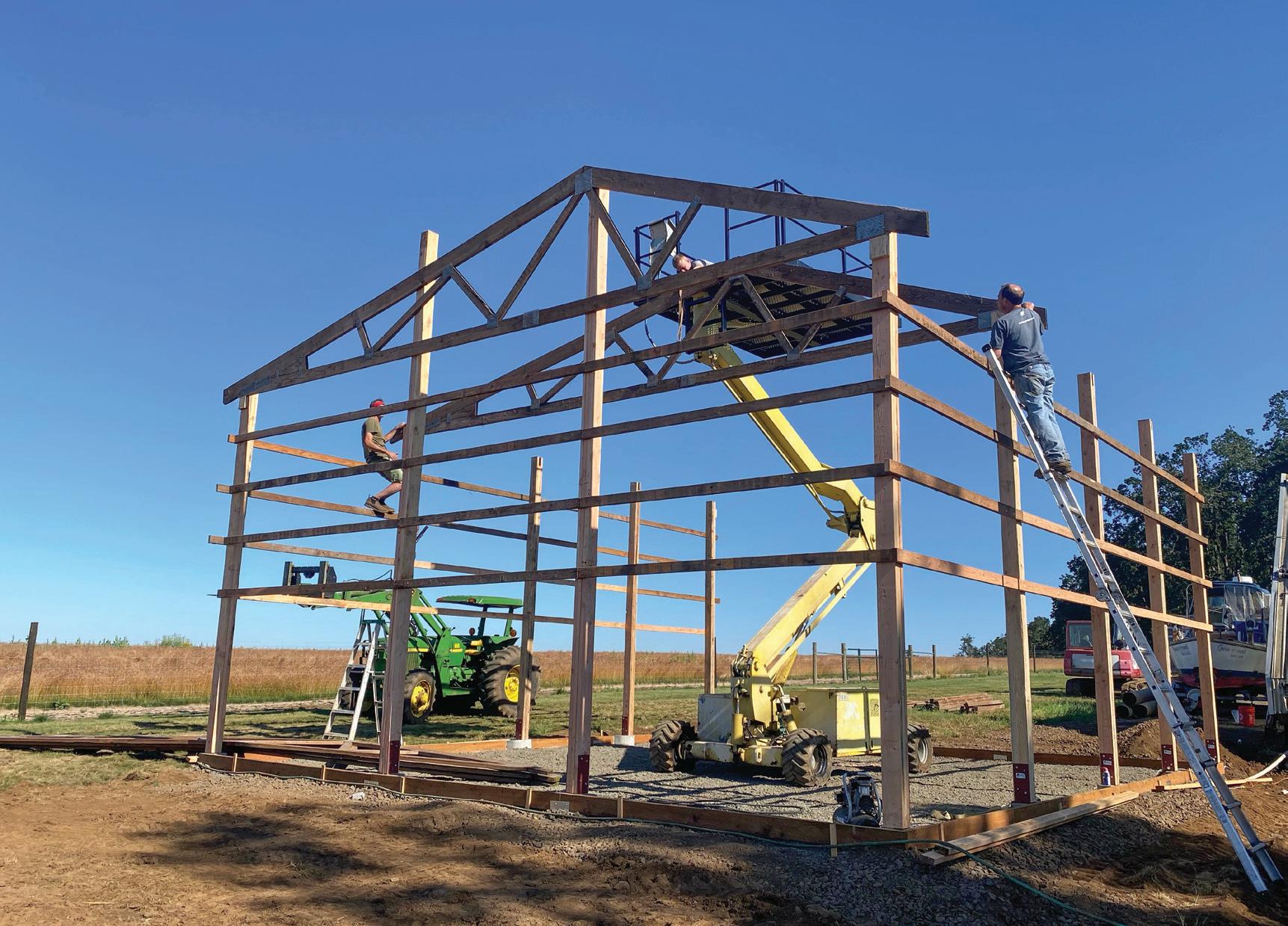
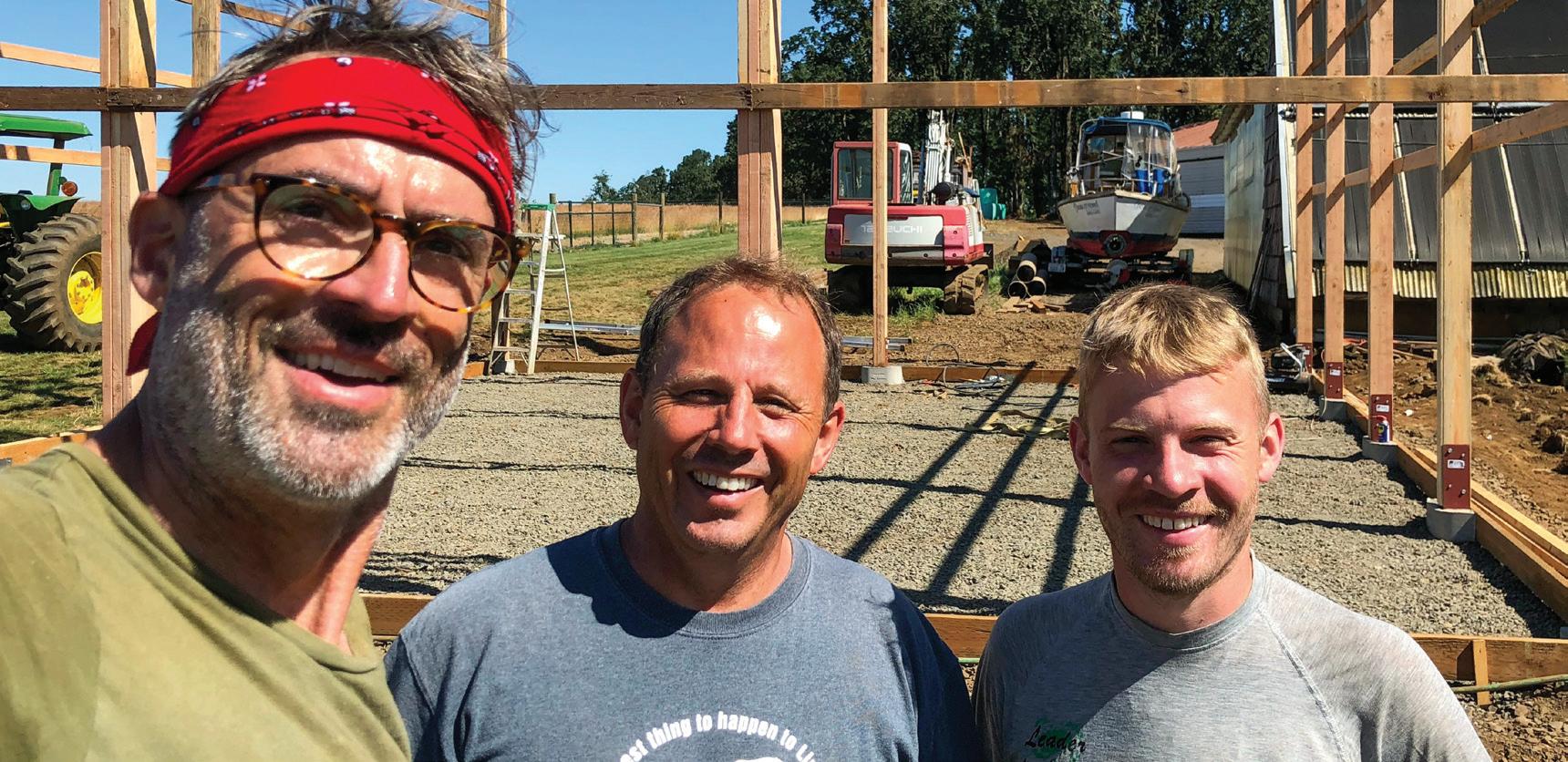
WABASH.EDU 13
Moving In
Wabash welcomed 265 new students to campus in August. For the first time since COVID-19 forced many changes in protocol, the start to the semester actually felt normal.

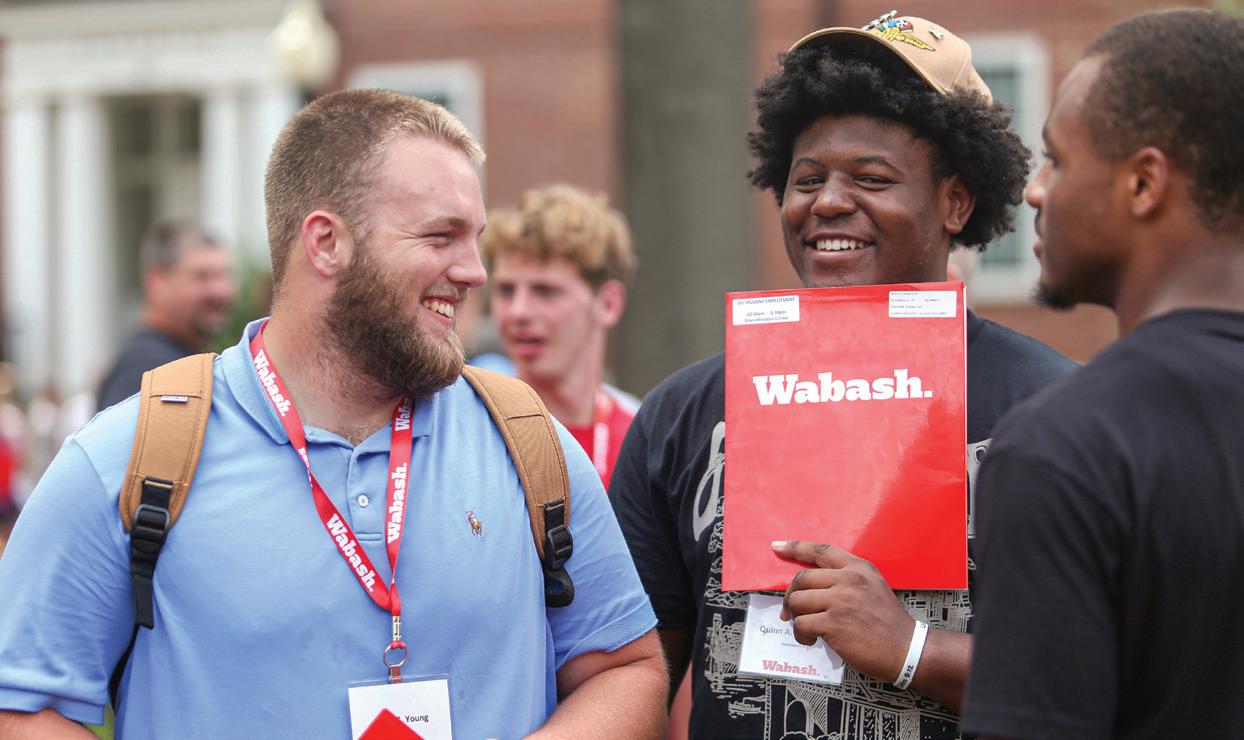
Community Service
New Student Orientation would not be complete without first-year students donning their work clothes, spreading out across the county, and serving area non-profit organizations. Jobs included landscaping, cleaning, painting, sorting, setup, tear down, and more.
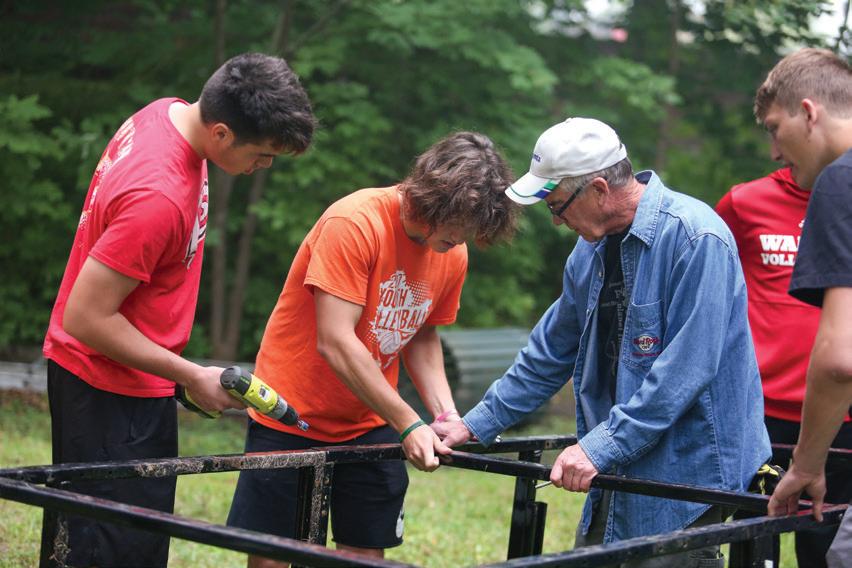
Ringing In
Ringing In returned to a hot, humid, standing-room-only Pioneer Chapel. The Caleb Mills Bell has never sounded so sweet.
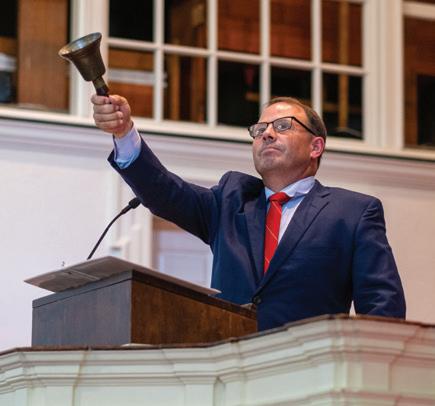
Downtown Crawfordsville Tour Faculty and staff who live in Crawfordsville took new students on tours around the city to introduce them to the downtown gems in their new home away from home.
Art Opening
English Professor Julian Whitney takes in the Richmond, Indiana-based artist, Antonio McAfee’s Mezzanine/Radiant Sons exhibit, which was featured in the Eric Dean Gallery throughout the fall semester. His work addresses the complexity of representation by appropriating and manipulating photographic portraits of African Americans in the 19th century, funk and R&B musicians, and transitioned family members.

14 Moments | FALL 2022
Grandmaster Gregory Kaidanov, one of the top chess players in the U.S., showed off his extraordinary gifts by playing a match blindfolded, then playing 30 games of chess simultaneously, and concluded with four simultaneous timed games.

As You Like It
One of William Shakespeare’s most-performed comedies, the pastoral As You Like It, kicked off the 2022–23 Wabash theater season under the direction of Theater Professor Heidi Winters Vogel
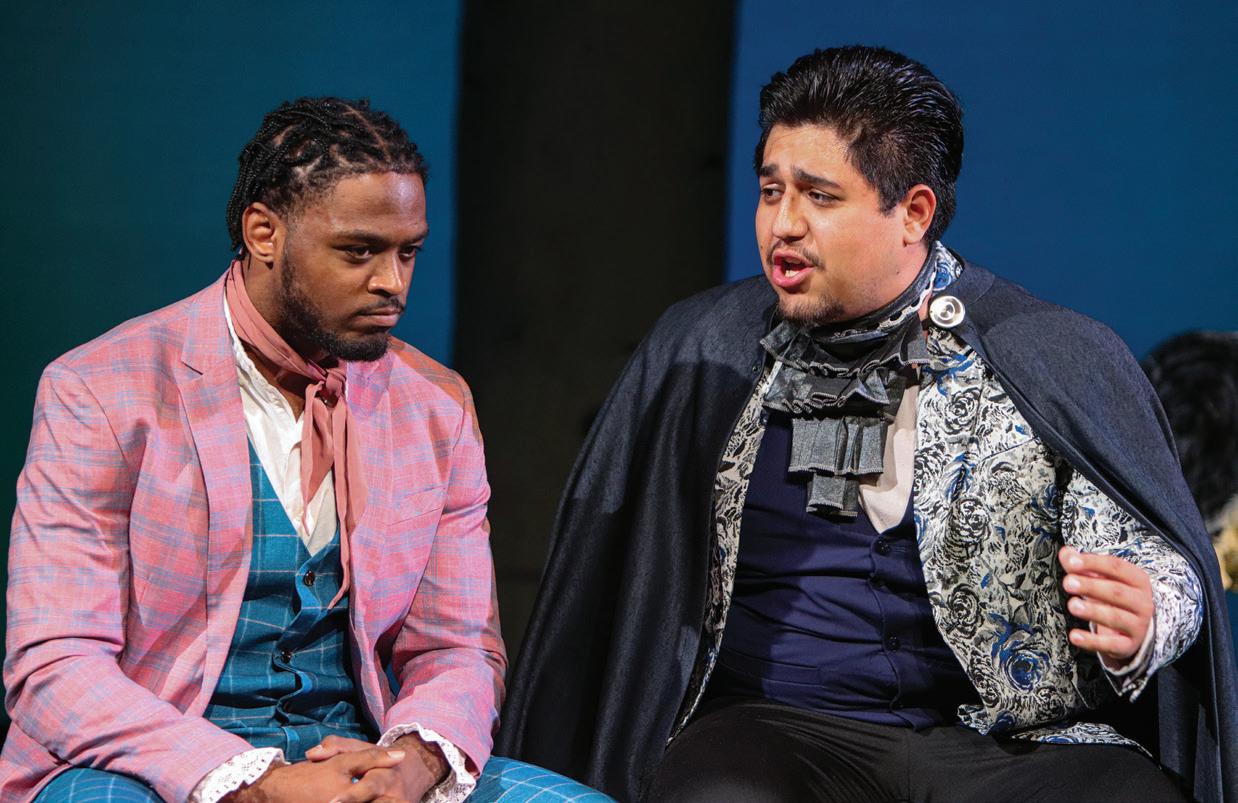

Mid-Autumn Festival
The Asian Culture Club and the International Students Association hosted “The Moon is Full All Over the World” to celebrate traditions that embrace the importance of families, friends, and loved ones globally. The event featured drawing and poetry competitions, an international quiz contest, and fall food, including kimchi fried rice, banh mi sandwiches, mooncakes, mochi, and pumpkin pie.
Lou

Story,
performed by
is a one-woman show featuring storytelling, singing, and video footage to recount Hamer’s activism and tremendous personal sacrifice in the fight for the voting rights of Black Americans in Mississippi. Famous for her line, “I’m sick and tired of being sick and tired,” Hamer’s courageous leadership culminated in her appearance at the 1964 Democratic Convention, and, ultimately, the Civil Rights Act of 1965. The presentation was in partnership with Steward Speakers of Indianapolis and sponsored by the Malcolm X Institute of Black Studies and Lilly Endowment Inc.'s “Restoring Hope, Restoring Trust” grant.
Chess Grandmaster
Fannie Lou Hamer
The Fannie
Hamer
written and
Mzuri Moyo Aimbaye,
WABASH.EDU 15
photos by Jim Amidon ’87, Elijah Greene ’25, Kim Johnson, Allie Northcutt, Jacob Paige ’23, Richard Paige, Anna Tiplick, and Becky Wendt
Generations of Sphinx Club members reunited on October 29 to celebrate 100 years of tradition keeping. The 59–23 Little Giant Football victory over Hiram that day meant a lot of push-ups on the sideline!
Members of Delta Tau Delta gathered in honor of the chapter’s 150-year history at Wabash. Originally installed in 1872, more than 1,700 Wabash men have become members of the fraternity since.

Tau Kappa Epsilon celebrated its 60th anniversary in September with a panel discussion, social gathering, and breakfast before heading to the Little Giants’ home opener against HampdenSydney College.



In its 29th year, Moot Court recorded a first—two winners. Liam Buckley ’23, counsel for the petitioners, and Seth Kirkpatrick ’24, counsel for the respondents, were named top advocates. Moot Court is a partnership between the Wabash Club of Indianapolis and the rhetoric department. Student-advocates are chosen to represent either the petitioner or respondent to an adapted court case. Each presents his case in front of a panel of judges while being interrupted and challenged with questions along the way. This year’s case addressed whether persons born in United States territories are automatically citizens. Jackson Grabill ’24 was awarded the Floyd Artful Advocacy Prize. Jakob Goodwin ’23 rounded out the top four finalists with William Grennon ’24 being the alternate.
Dork Club Game Day
Members of the Dork Club invited the Wabash community to join them for Gaming Day. Table-top gamers enjoyed the chance to step away from studying and challenge each other across the board.
 TKE Reunion
Moot Court
Sphinx Club Reunion
Delt Reunion
TKE Reunion
Moot Court
Sphinx Club Reunion
Delt Reunion
16 WABASH MAGAZINE
| continued
Moments
Nathan
President Scott Feller welcomed Dr. Nathan Grawe, the Ada M. Harrison Distinguished Teaching Professor of the Social Sciences and Professor of Economics at Carleton College. Grawe is the author of “Demographics and the Demand for Higher Education” and “The Agile College: How Institutions Successfully Navigate Demographic Changes.” His visit was sponsored by the President’s Distinguished Speaker Series.

Women’s Collective
International Students
Wabash welcomed 25 new international students to campus in the fall—the largest group of incoming international students in the College’s history. They are from Bangladesh, Brazil, China, Ethiopia, India, Mongolia, Nepal, Nigeria, Russia, Tunisia, and Vietnam. In addition, five new foreign language teaching assistants arrived in August from Argentina, France, Germany, Mexico, and Taiwan.

Class agents assembled for the annual Class Agent Forum. A proclamation was read naming all future forums after JB Bachman ’61 for his dedication as class agent for the Class of 1961.

The Wabash Women’s Collective held its inaugural meeting in October. By women, for Wabash men, the group brings together women leaders, chief supporters, and giant believers in Wabash and Wabash men. They are building a space for high-impact, women-driven philanthropic leadership. Members include (top row, left to right): Trustee

Jennifer Evans, parent of Jack Montgomery ’16; Sarah CrossmanSullivan, daughter of Kenneth Crossman ’55, parent of Jack Sullivan ’23; Holly Harrington, parent of Brailen ’22 and Bradley ’24 Harrington; Nicole Chase, spouse of Kip Chase 03; (bottom row, left to right) Maheen Cleaver, spouse of Chad Cleaver ’00; Karen Reetz, daughter of Thomas Reetz ’58; Gayle Davis, spouse of Fred Kraft ’64; and Wendy Feller, first lady. Not pictured, Lisa Kolisek, spouse of Frank Kolisek ’82, and mother of Jake ’11 and Charlie ’14 Kolisek
Thomas and students in her class, Puerto Rico: History, Migration, and the U.S. Empire, traveled to Chicago to visit the National Museum of Puerto Rican Arts and Culture.
 Grawe
Class Agent Forum
Puerto Rico Immersion
Grawe
Class Agent Forum
Puerto Rico Immersion
17
Professor Sabrina
International students joined their local host families to participate in a beloved Halloween tradition—carving jack-o’-lanterns.

Helicopter Landing
Two U.S. Army Black Hawk helicopters from the Indiana National Guard post in Shelbyville landed on Mud Hollow Field to pick up Wabash ROTC cadets and transport them to Purdue University. The Wabash cadets train at Purdue twice a week.

X-tacy
The Malcolm X Institute of Black Studies hosted X-tacy, its annual poetry, spoken word, and rhyme scheme competition.

Family Day
The weather was game-day perfect in October for Family Day festivities. Wally made the rounds for photos and families enjoyed a few extra minutes with their Wabash sons for lunch and the game.
 Pumpkin Carving
Pumpkin Carving
18 WABASH MAGAZINE
ROTC
ROTC students enjoyed catching up with veteran and Wabash Trustee Eric Eversole ’94 at the October 29 football game.

Tea Ceremony
The Asian Studies Minor Steering Committee hosts tea each semester to represent different tea cultures and traditions around Asia. This semester’s theme was Japanese tea. They served Matcha Latte, Houjicha, and Genmai Cha along with some traditional Japanese snacks.
LXA Ribbon Cutting

Lambda Chi Alpha held a ribbon cutting ceremony to officially open the new indoor and outdoor common space and kitchen renovations in the chapter house on Jennison Street.
Trick-or-Treat
A not-so-scary group of faculty, staff, students, and even a few Wabash kids brightened the sidewalks and halls of Wabash by dressing up on All Hallows’ Eve.


WABASH.EDU 19 Moments | continued
Miracles, Miracles Everywhere
Of all of the things he learned about U.S. culture before his family relocated, smiling at everyone was the strangest. Now he can’t stop.
by Kim Johnson
at 12-years old, alex ngaba ’24 , his mother, and younger siblings fled the Central African Republic amid civil war. For two weeks, they hiked through the woods with broken sandals and only the clothes on their backs as they crossed the border into Cameroon.
“There were tense shootings. We just left. We escaped—just look forward, go. We would run, walk, rest, run, walk, rest,” Ngaba says.
He recalls people crying and dying on the pathway and having to search for “random stuff” in the woods to eat to stay alive. He learned to survive by eating only two or three times a week.
“If I don’t see any food around, I just keep drinking water,” he recalls. “Water is the source of life.”
Months later the family was reunited with his father. For years they lived in a refugee camp. Ngaba attended school and his dad picked up odd jobs to make money. Visits to pantries and food supplied every few months from the UN kept them fed.
“Cameroon was a refuge place for me but I didn’t call it home,” says Ngaba. “A lot of people bullied me at school because of where I was from so I didn’t put in my head that it was my home. I was trying my best not to fight or get in trouble because if I got in trouble, I would get expelled and that’d be it for me.”
Eventually, the UN offered to relocate the family to either Canada or the U.S.
“My dad said anything that is better,” Ngaba says. “We just go.”
They were put on a waitlist for the U.S. for five months.
“We thought they forgot about us. But they called back and said, ‘OK, you have been approved to go. Get your stuff ready,’” Ngaba says. “We had to sign lots of papers, get vaccinations, and learn the American culture.”
He recalls learning to count U.S. currency, watching a video about how to use a washing machine, and learning various phrases in English like, “I need help,” and “Where should I go?”
“I couldn’t believe I was stepping on an airplane. I never thought I would step on an airplane in my life,” he says. “For me and my family it was just miracles, every day new things happening. Miracles, miracles everywhere, miracles.”
Among the first people Ngaba and his family met when they reached their final destination of Indianapolis were Cathy and John Bridge ’72, who along with Exodus Refugee Immigration and Trinity Episcopal Church in Indianapolis, have established a local support system for the family.
“We were happy to help,” Bridge says. “I was with the group that met Alex and his family when they came off the plane. We set them up in an apartment. Many people from the church have stayed close with the family. Alex has got charisma plus. He’s in high gear all the time.”
“They taught us how to stay in a hotel and that when American people see you, they smile, and you have to smile back,” says Ngaba. “My family hadn’t smiled in a long time.”
They left Africa on November 13, 2016, and arrived in the U.S. on November 15.
Ngaba started school at the first opportunity and sped through the Indianapolis Public Schools Newcomer Program for students learning English. What was supposed to take him a year, he completed in one semester. He then transferred to Arsenal Tech and then to George Washington High School, where he graduated at the top of his class in 2020.
He was interested in computer technology and told Bridge he was thinking about attending community college.
“
20 WABASH MAGAZINE Works in Progress | FALL 2022
For me and my family it was just miracles, every day new things happening. Miracles, miracles everywhere, miracles.”

WABASH.EDU 21
“He is way too talented for that,” Bridge says. “I encouraged him to look at Wabash.”
Ngaba received a generous financial aid package, but there was still a large sum to make up.
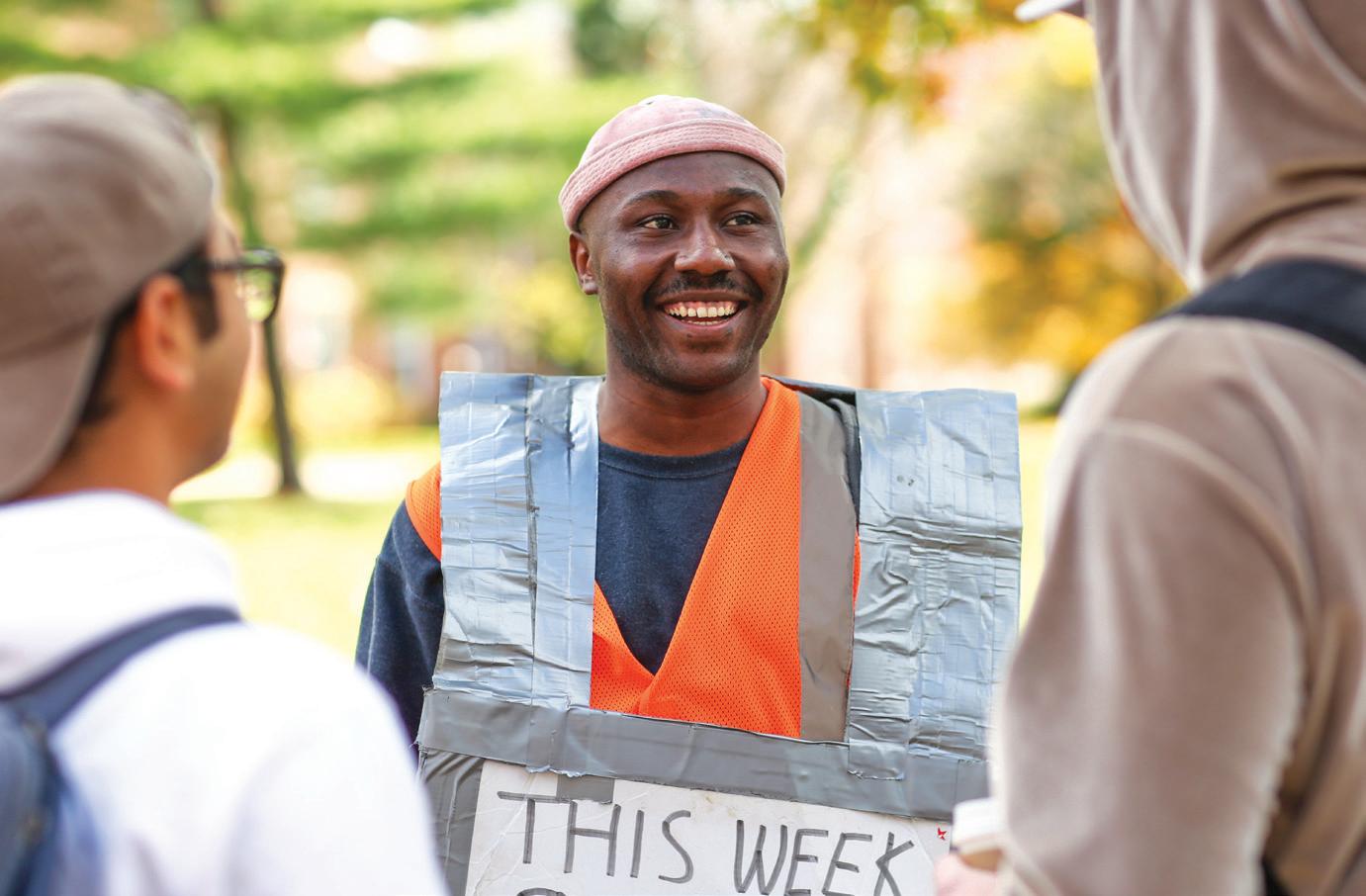
“Some people said, ‘Well, it’s just not going to be possible for him to go there,’” Bridge says. “I told them, ‘I will prove to you the power of the Wabash brotherhood.’ I contacted a number of friends of mine and within three days, we had made up the difference.”
The art major and French minor continues to have an interest in computer science, but looked to his Wabash experience as an opportunity to grow.
“College is about challenging yourself,” Ngaba says. “I needed to find something I had never done that I didn’t start until college, which is art.”
He admits he was pretty reserved and didn’t get involved much his first three semesters, but pushed himself to do “something good” before he graduated.
Now, Ngaba is the house manager at Tau Kappa Epsilon, on the Diversity, Equity, and Inclusion Committee, treasurer of the African Student Association, a new inductee in the Sphinx Club, and a supervisor in the
Fine Arts Center. He also became a U.S. citizen in November.

“Involvement is important,” he says. “When you get more involved, people can help you out and I can also help them. I came here without knowing people. I am learning the language and the culture. I voted for the first time. I asked somebody in my house, he showed me how to do it.
“I’m open to talk to anyone,” he continues. “I have met people from many different countries. You learn a lot from people and they can also learn a lot out of you.”
While he admits he still has struggles, he tries to keep it all in perspective.
“I always keep my smile up. When I smile and I see someone smile from my smile, it just makes me happy. As a little boy, I saw people dying in front of me, their heads cut off. It was awful. I know that every place is not perfect, even the U.S. isn’t that perfect. But if I can eat and wake up in the morning and do what is best for me, smile, that’s a perfect place for me. I’m just thankful.”
And if he needs an extra reminder, Ngaba still has the clothes he wore everyday for four months as a refugee.
“When I came to the U.S., I kept them to remember how far I’ve come. It’s good to remember where you come from, to never forget.”
Alex Ngaba ’24 met a Sphinx Club rhyne his first semester at Tau Kappa Epsilon. “I thought he was a priest,” he says with a laugh. As a rhyne himself in the fall, he wore that same TKE rhyne pot.
“It’s good to remember where you come from, to never forget.”
22 WABASH MAGAZINE Works in Progress | continued
Ngaba after becoming a U.S. citizen in November.
BROTHERS ON AND OFF THE FIELD
by RICHARD PAIGE
Brotherhood is a term that gets thrown around a lot at Wabash. The connection, the act of living, learning, and growing up like brothers is fundamental to what makes Wabash, well, Wabash.
One doesn’t have to look far to see examples of brotherhood all across campus, but if you sat in the stands of Little Giant Stadium on a Saturday afternoon this fall, such a concept was hard to miss. Because on the field at any given time were two sets of football playing brothers—Ben ’25 and Will ’25 Netting and Connor ’25 and Liam ’24 Thompson.
 Left to right: Will Netting ’25, Ben Netting ’25, Connor Thompson ’25, and Liam Thompson ’24
photo by Anna Tiplick
Left to right: Will Netting ’25, Ben Netting ’25, Connor Thompson ’25, and Liam Thompson ’24
photo by Anna Tiplick
WABASH.EDU 23 Speaking of Sports | FALL 2022
The Nettings—identical twins who have played together since they were five—both anchored the defense from their positions at safety. The Thompsons drove the offense with Liam at quarterback and Connor at wide receiver.
The idea of brothers playing together at Wabash isn’t unique. Recently, the Bureshes—Tyler ’12, Cody ’15, Ethan ’17, Dylan ’18, and Seth ’22—overlapped for more than a decade. And Austin ’13 and Houston ’15 Hodges both started at cornerback in 2011 and 2012, respectively.
Being on the field at the same time proved to be a powerful byproduct to a strong recruiting pitch.
“When he was looking at colleges, I was obviously pushing him this way,” explains Liam about his brother. “But I never really appreciated how cool it would be for us to actually be on the field at the same time until we got to do it.”
For the Nettings, it wasn’t that simple. This is the first year that they’ve played defense together. For much of their shared history rising through the youth and prep
ranks in Jacksonville, Florida, Ben was a quarterback and Will was a safety.
After spending the 2020 season at Marist College, the duo transferred to Wabash. Will fit right in on defense, but Ben found himself behind Liam, the team’s established QB1. Knowing he didn’t want to spend three seasons as a back-up, Ben decided to switch to wide receiver. Anything to get on the field.


In his first practice as a receiver, he tore his ACL. After a lengthy recovery, he hit spring practice ready to contribute again— but in a new position. Defensive Backs
Coach Joe Riordan mentioned the team was a little thin at safety. He suggested Ben give it a try.
So he did.
In his third position in three seasons, Ben says, “I took the initiative and just stuck with it. From quarterback to receiver to safety, here we are.”
“The fact that he switched positions, got hurt, and then came back to learn a whole new position, that’s just crazy,” Connor says. “He’s such a good athlete to be able to do it, and we need guys like that to win.”
As the Netting brothers took the field for the first time on the same side of the ball, Will said it felt a lot like it did when they were kids.
“The first time it happened, I just kind of laughed,” says Will. “It’s hard to explain, it felt just like playing football in the backyard. I look over and he’s playing safety next to me.”
“There used to be a lot of competition between us being on opposite sides of the ball,” Ben says. “With this being my first year playing safety, having him there to teach me how to play the position has definitely been helpful.”
This season, the Nettings combined for 55 tackles, two sacks, and six pass break ups, though Will only played in five games due to injury.
For the Thompsons, that COVID season proved to be a benefit. Liam, two years older than Connor, has an extra year of eligibility because of the lost 2020 campaign. That allowed these brothers to get three years together instead of two.
“That was the silver lining to the pandemic,” Connor says. “We started working out together—I caught thousands of balls from him—and I started learning the playbook early, too. It ended up being a really great thing for us.”
It wasn’t without a few adjustments.
“When I’m on the sidelines, I can feel like a fan watching Liam make plays,” Connor says of the quarterback who successfully targeted him 13 times this season. “But when I’m on the field, it’s a lot different because I
photo courtesy of Connor Thompson ’25
photo by Becky Wendt
Liam Thompson ’24
24 WABASH MAGAZINE Speaking of Sports | continued
Left to right: Mother Shannon Thompson, Liam Thompson ’24, Wally, and Connor Thompson ’25
know if I don’t get my head out of the break, he’s going to drill me with the ball. It’s coming in hot, so I have to be ready.”
It was another stellar season for Liam, as he completed 72% of his passes in amassing nearly 3,600 yards and 34 touchdowns. And for the second consecutive year, he received the Mike Gregory Award as the 2022 North Coast Athletic Conference Football Offensive Player of the Year. Connor averaged 13.5 yards per reception with a touchdown to his credit.
Does the Little Giant QB happen to look for his brother out of instinct when the team breaks the huddle and hits the line of scrimmage? Yes, he says, acknowledging there is a running joke about Connor getting the ball.
Liam takes time to see where the advantages are. For a quarterback who completed nearly 75% of his passes last season, the elder Thompson was good at identifying those advantages.
2021 season, it leveled the playing field by neutralizing the advantage Will carried over Ben.
“Early on, I had most of the answers to the questions,” Will says. “But as we got into the season and faced new schemes, I had to go to Ben sometimes and ask, ‘what are we doing here when they come out in this formation?’
in practice, a nod to the competitiveness that exists between them.
Connor mentioned Liam’s stiff-arm of a DePauw defensive back in the 2021 Monon Bell Game. “A lot of people would say that was their favorite Liam Thompson play,” he explains, “and that’s the one I remember most.” But it was Liam who answered like a good big brother.

“His first touchdown (Sept. 24 vs. Denison),” he starts. “We had almost everyone from our family here that day. When he scored, I went down there to celebrate and set the ball aside. I told him that this ball is going in the trophy case at home. That’s an easy choice for me.”
Connor’s arrival coincided with an already strong connection between Liam and fellow wide out Cooper Sullivan ’24. During the missed COVID-19 season, the trio worked out together daily, building the trust that every great QB-WR group has. Now, they are on the field at the same time.

“That’s a cool thing,” says Liam. “It feels like backyard football, in a sense, but we’re playing at a pretty high level in college with really high expectations. We’re not in the backyard tossing balls around anymore. There is a whole new feeling now.”
Aside from COVID-19, transfers, and injuries, the one surprise benefit from getting the Nettings on the same side of the ball was the ability to learn together. When Mike Ridings arrived as the program’s new defensive coordinator following the
It was nice to be able to lean on him.”
The brothers spend about 90% of their time together, whether it’s living together, practicing, or hanging out. And even through this season, where the Thompsons and Nettings have shared the field together, it’s not surprising that they are each other’s biggest fans, enjoying those moments when they can watch the other from the sideline.
Each brother had a favorite moment come to mind. Will and Ben reminisced about times in high school when as leaders of their respective units they would jaw at each other
It’s one thing to have an actual brother on the field, it’s another to share that experience with teammates.
“What we’ve done together just fits right in with Wabash and how we talk about brotherhood,” Will says. “Brothers playing together fits here because we have a hundred brothers on this team that we are close to.”
“Surrounding yourself with people like that is what makes this place so special,” says Ben.
photo by Anna Tiplick
“When he scored, I went down there to celebrate and set the ball aside. I told him that this ball is going in the trophy case at home.”
photo by Tom Runge’71
WABASH.EDU 25
No. 2 Will Netting ’25 and No. 12 Ben Netting ’25 in the tunnel before taking the field.
Season in Sports | FALL 2022
Soccer
Led by rookie sensation Caleb Castaño ’26, a very young Wabash soccer team finished 12–6–1 on the season and went 5–3 in conference play. With an incredible defense that limited opponents to an average of just one goal per game, Head Coach Chris Keller ’s Little Giants earned its sixth-straight berth in the four-team NCAC tournament. The team has won 11 or more games in a season eight times since 2014.
Hailing from Las Vegas, Castaño earned NCAC Newcomer-of-theYear honors and made the all-NCAC second team after collecting six goals and four assists. He had game-winning goals over Hanover, Wittenberg, and DePauw. Wabash has beaten DePauw in five of the last six matches.
Bruno Zamora ’25 joined Castaño on the all-NCAC second team, while Emilo Paez ’25, Hayden Eaton ’25, and Soren Russell ’26 were honorable mention selections. Russell recorded five shutout victories in his rookie season in goal for Wabash.


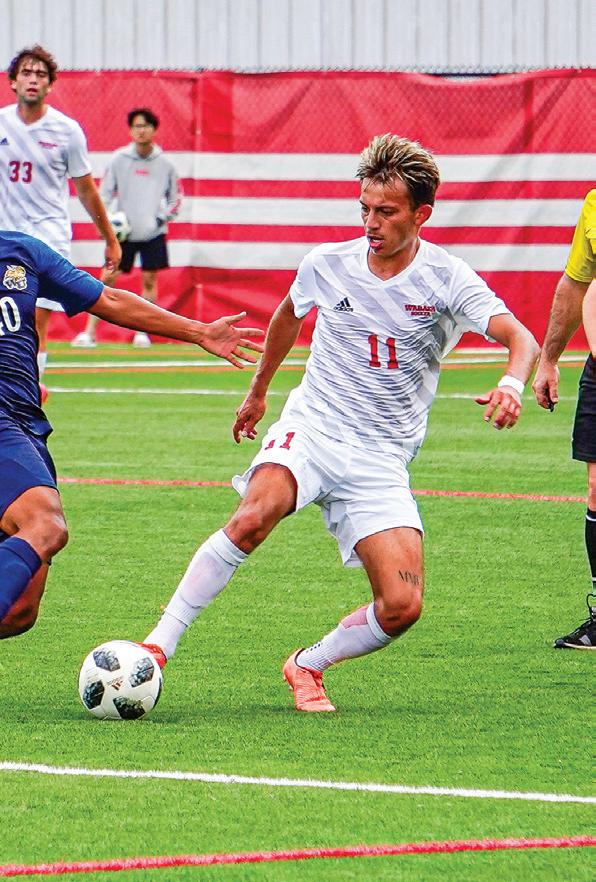 Bruno Zamora ’25
Soren Russell ’26
No. 8 Emilo Paez ’25 celebrates with No. 33 Hayden Eaton ’25 and No. 2 Quinn Leous ’23
photo by Tom Runge ’71
Caleb Castaño ’26
Bruno Zamora ’25
Soren Russell ’26
No. 8 Emilo Paez ’25 celebrates with No. 33 Hayden Eaton ’25 and No. 2 Quinn Leous ’23
photo by Tom Runge ’71
Caleb Castaño ’26
26 WABASH MAGAZINE
photos by Jacob Paige ’23
Football
The Wabash football team entertained fans with six home games in Little Giant Stadium with a 7–3 record finishing in second place in the North Coast Athletic Conference. Quarterback Liam Thompson ’24 led a record-setting offense that averaged 536 yards and 43 points per game, including a thrilling come-frombehind 52–48 win over Hampden-Sydney College in the Gentlemen’s Classic.
Wabash avenged 2021 losses to Wooster, Wittenberg, and Ohio Wesleyan (spoiling homecoming for the Scots and Tigers). Thompson repeated as the NCAC Offensive Player-of-the-Year and led NCAA Division III in passing yards (358.8 per game) and total offense (393.7 per game).



Cornerback Jose Franco ’23, receiver Derek Allen Jr. ’24, and offensive tackle Quinn Sholar ’26 earned first team all-NCAC honors. Tight end Penn Stoller ’24 earned second team honors. Running back Donovan Snyder ’24 led Wabash with 14 total touchdowns, while receivers Stoller, Allen, Heisman Skeens ’23, and Cooper Sullivan ’24 combined for 28 touchdowns.
Cross Country
Head Coach Tyler McCreary’s harriers were a young and improving squad in the fall 2022 cross country season. Five sophomores joined Thomas Gaines ’23 and Joe Barnett ’24 on the NCAA Great Lakes Regional team, and all seven Little Giants posted personal best times in the 38-team field.

Brayden Curnett ’25 paced the Little Giants at the conference meet, finishing 12th overall to earn a spot on the all-NCAC second team. Racing in the snow two weeks later, Curnett sheared two minutes off his conference time to lead Wabash at the Regional in a time of 25:20. Gaines posted a career-best time of 25:41 in his last collegiate race.
Barnett also had a career-best time of 26:19 at the Regional, while Justin Santiago ’25 and Will Neubauer ’25 posted lifetime-best times to round out the scoring for the Little Giants. The team’s top all-around performance came at the Jenna Strong Cross Country Classic, where Wabash finished fifth among 23 teams.
photo by Anna Tiplick
photo by Tom Runge ’71
photos by Becky Wendt
Derek Allen Jr. ’24
Cooper Sullivan ’24
WABASH.EDU 27
Liam Thompson ’24
WELCOME HOME, COACH KOPP
by Allie Northcutt
“ i ’m happy to help.”
It wasn’t uncommon to hear Justin Kopp ’21 say those four words as a student at Wabash. Whether it was on the field or in the classroom, the religion and Spanish double major from Avon, Indiana, was always eager to lend a hand.
Not long after graduating, Kopp shared those same four words with Head Golf Coach Josh Hill.
Hill joined the Wabash staff in July 2021, replacing Tyler Schmutz, who served two seasons as the team’s head coach.
“When Coach Schmutz left, some guys were worried the team may not be able to recover and continue successfully on the path they’d worked hard to pave,” explains Kopp, who played on the golf and soccer teams all four years, and was named Most Improved Player for Wabash golf in 2019.
“I thought it would be helpful for Coach Hill to have someone in his corner to talk to and to introduce him to Wabash, someone who’s been through it,” says Kopp. “I care deeply about the program. It gave me so much personally as a student, and I wanted to stay involved.”
Hill took Kopp up on the offer, and the 2021 graduate volunteered to serve as the team’s unofficial assistant coach. That year, the team placed fifth overall at the 2022 North Coast Athletic Conference Men’s Golf Championship Tournament.
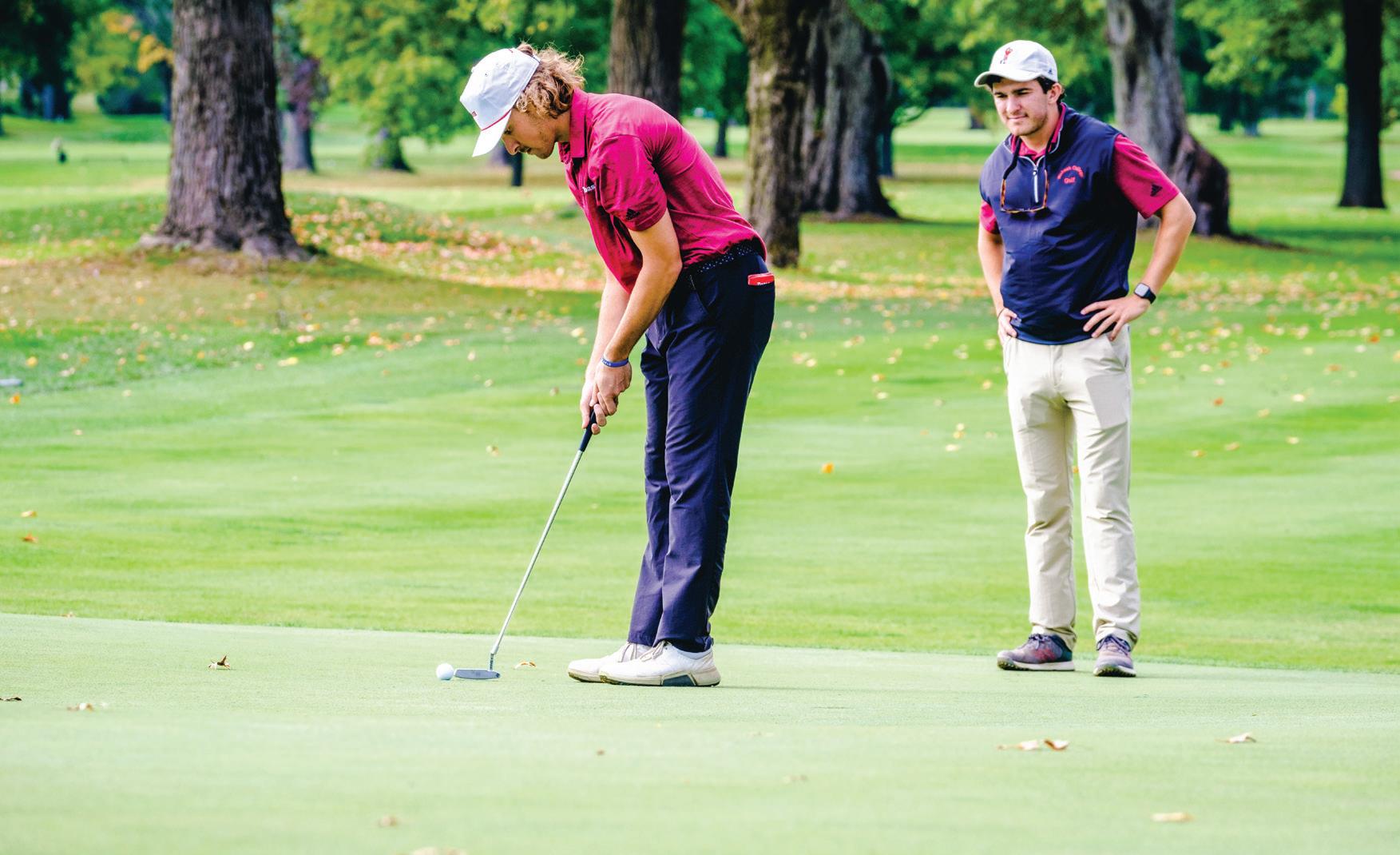
“Being able to go to conference with the guys was definitely the highlight of my year,” says Kopp.
Months later when Hill unexpectedly announced he would be leaving the program after one season, Kopp again said, “I’m happy to help.”
This time it was directed to Matt Tanney ’05, director of athletics and campus wellness, who needed to quickly find a new coach before the fall season started. Kopp agreed to help serve on a panel responsible for interviewing potential candidates.
Tanney, however, had another idea. He encouraged Kopp to apply for the job himself, and said the team could move forward under his leadership.
“I was pretty shocked and couldn’t believe that it was happening so quickly,” Kopp says. “I had definitely fantasized about coaching in some kind of capacity in the future. I felt
honored that Wabash saw potential in me.”
If he accepted, coaching wouldn’t be his only full-time job. Kopp is in the second year of a two-year appointment as an Orr Fellow and works as an associate solution architect at Lev, a Salesforce consultancy marketing company in Indianapolis.
After receiving some guidance from family, close friends, and his mentor, Head Soccer Coach Chris Keller, Kopp accepted the offer to return home to Wabash and serve as the golf team’s interim head coach.
“I felt reassured and confident coming into this position because I understood the expectations and what was going on with the team from the year before,” says Kopp. “I believed I could help the program continue on the right trajectory.”
Kopp had a terrific academic and athletic career at Wabash. He played in 33 rounds over his collegiate career, posted ten top-10 finishes, including three spots in the top five, and earned the Scholar-Athlete Award presented annually to the Wabash senior who best demonstrates the combination of scholarship and athletics by the Wabash Club of Indianapolis.
photos by Anna Tiplick
28 WABASH MAGAZINE Season in Sports | FALL 2022
Justin Kopp ’21
“Justin’s knowledge of the game and leadership of the team provides a seamless transition for the men in the golf program,” Tanney said at the start of the 2022–23 season. “He’s a winner on and off the course that will positively impact everyone associated with Wabash golf.”
Kopp quickly proved his coaching abilities by leading the team to victory at the start of the fall season.
With Sean Bledsoe ’26 and Brayden Weiss ’24 capturing the top-two places, Wabash won the team title at the Forest Hills Invitational, hosted by Earlham College, in September. Wabash was the only team to score under 300 strokes on the final day of competition—finishing at 298.

“I knew they could do it,” says Kopp. “Since our first practice, I have focused on instilling confidence in them. I want to make sure they know how good they are and believe in themselves. Building up that culture is what will result in more wins.”
The team wrapped up the fall season with a second-place finish out of nine teams at the Stateline Shootout, as well as seventh-place at the Wabash College Invitational, and sixth-place at the Wittenberg Golf Classic.
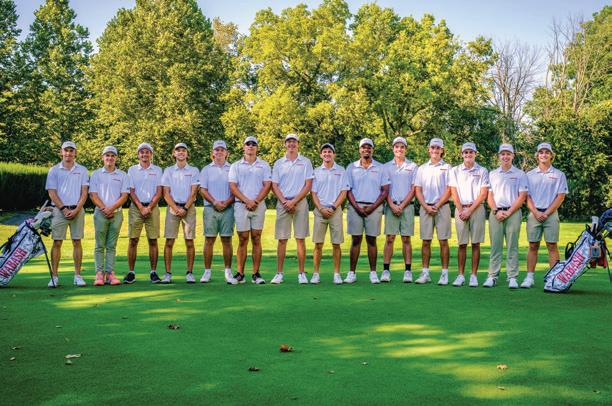

“The big thing haunting the program before Kopp was that we weren’t performing to the best of our abilities,” says Allen Johnson Jr., one of two seniors on this year’s roster and Kopp’s former teammate. “We wanted to win. We wanted to have that moment and be able to bring the trophy home. And we did that in our first event.”
Johnson also recalls the excitement the team felt when Kopp asked every golfer to sign the back of the trophy.
“That win helped establish Kopp’s presence on campus and with the team,” he says. “We knew we had really good players, but we also quickly learned that we have a really good leader at the top, too. Kopp cares, is going to help us be consistent, and prove we can compete with everybody.”
It took some time for Kopp and his team to adjust to his shift from friend to coach.
“We had a talk as a team early on,” says Kopp. “I told the guys, ‘I realize that I am your friend. We will always be friends even after golf. But you didn’t come to Wabash to be coached by your friend. You came to be coached by someone who is going to push you, and that’s exactly what I’m going to do. If I see something I don’t like or needs improvement, I’m going to tell you.’”
Establishing those expectations did feel uncomfortable to Kopp at times, but having Keller to lean on for advice has made the transition from player to coach smooth.
“Whenever I find myself struggling with how I should approach something, whether motivating the guys in practice or how to recruit future players, I know I can turn to Coach Keller,” Kopp says. “Just the other day, we had a really good conversation about the highs and lows of coaching, and if this is something I want to do as a career. Having him there to talk to has really made a difference.”
Keller remembers the phone call he shared with Kopp before he accepted the coaching position.
“He said, ‘What do you think? Should I do it?’” Keller recalls. “I told him it sounded like an opportunity he’ll enjoy, and he would never know if he was going to love coaching unless he tries it. Even as a player, he was always a coach on the field, so I already knew he had those qualities in him.”
Keller says he’s been happy to serve as Kopp’s mentor during this transition,
and the coaching relationship he’s built with his former player is one that can be found among all Wabash’s coaches.
“The way he bounces ideas or asks for help is the same way I have with Coach (Mac) Petty, Coach (Kyle) Brumett, Coach (Tyler) McCreary—it doesn’t matter the sport, we all talk and share ideas, and can relate to each other,” says Keller. “I’ve told Kopp that we’ve all been through it, so he’s not alone in figuring out coaching. Everyone in athletics is here to support him.”
Keller is proud to see how Kopp has embraced his new role.
“When they won their first event, Kopp was really humble about it,” he says. “Kopp said, ‘The guys did it. They played great and ran the show.’ It could have been about him, but he made it about celebrating the team.
“He’s establishing a really good culture,” says Keller. “I’m excited to see where he takes them as their coach.”
With ‘interim’ in the title, Kopp is unsure if he’ll be head coach next year.
“I’m not sure what the future looks like, but I will say with 100% certainty, I am committed to our current players, to our future players, and to the overall future of this program,” says Kopp. “I’d love to continue to be a part of the Wabash golf team, whether it’s as the head coach, an assistant coach, or just a cheerleader. Whatever is decided, I’m happy to help.”
WABASH.EDU 29
Interim Head Golf Coach Justin Kopp ’21 (third from left) led the Wabash golf team to win the team title in September at the Forest Hills Invitational. This was Kopp’s first tournament of the 2022–23 season as the team’s new coach.
HOME
after wabash i joined the navy and have had so many homes! My wife Rachel (DPU ’06) is a saint and always up for our next adventure.
Home is where my family is—wife, three children, the dog and cat. The building changes but we’re the same. Home is my squadron parking spots at the airfield after a deployment. Home is the familiar pier when sailing back into Norfolk Naval Station.
I know I’m home after a crew debrief. I walk off the ship or out of the squadron and get into my truck. It may not have moved for weeks but the same coins are in the cupholder, and the sticky hand prints are on the back windows where my children so excitedly looked out.
I get home to family and everything else disappears. The cold steel of the ship is replaced with hugs and a comfy blanket. No more loud engine noise of the planes. I often get home at night and the house is silent. This changes in the morning as instead of the roar of engines, it’s cartoons blasting in the living room and children skipping throughout the house.
. Eric M. Eder ’08
I know I’m home after a crew debrief. I walk off the ship or out of the squadron and get into my truck. It may not have moved for weeks but the same coins are in the cupholder, and the sticky hand prints are on the back windows where my children so excitedly looked out.
We asked our readers:
Where is your home?
How do you know you’re home?
Do you have a story of leaving home or coming home?
i ’m almost always home as I’m like a turtle and my home is always with me. Everything I own is less than 25 feet from me. It began with moving aboard my 32-foot sailboat, Kelly IV. I lived there for five years, sailing from Erie, Pennsylvania, through the Welland Canal, across Lake Ontario, out the St. Lawrence Seaway and traversing the Canadian Maritimes. I cruised New England, arriving in Annapolis, Maryland, to serve as a yacht broker for a couple years before continuing south through the Intracoastal Waterway to Florida.
In 2016, I sold Kelly IV and replaced her with a small, 25-foot sailboat and a 25-foot RV named Kelly VI. My full-time abode since is Kelly VI. I’ve driven her through all 48 states of the lower U.S. I’ve enjoyed many little adventures, including my longest bike ride, Florida coast-to-coast from the Atlantic to the Gulf. My most interesting trip might be when I nearly sunk my sailboat in Nova Scotia while cruising the Canadian Maritimes. Other adventures include traversing the entire length of Old Historic U.S. Route 66 from downtown Chicago to the Santa Monica Pier during the COVID-19 pandemic—66 days on Route 66 in my 66th year.
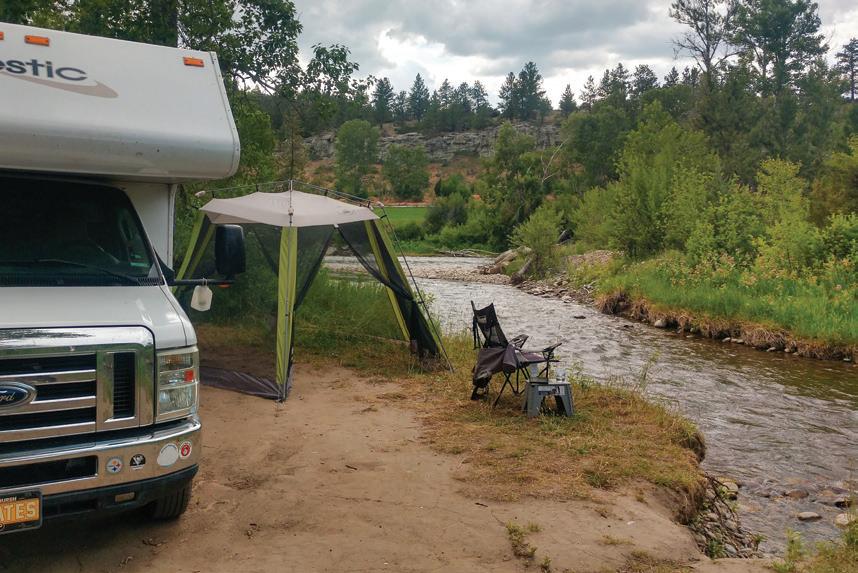 . Allen Murphy ’76
. Allen Murphy ’76
30 WABASH MAGAZINE Big Question | FALL 2022
i grew up on a small 60 -acre farm in Carroll County, Indiana. Besides the normal corn and soybean crops, we had dairy cows, sometimes five or six, but by the time I was in high school we were milking 25 or so. I was very proud to announce in first and second grade showand-tell that I was milking cows. Not so happy about it by the time I reached high school. Having dairy cows also meant we spent most of our summers baling hay and straw.
Every Saturday was spent loading earcorn into our pickup using a scoop shovel, driving it to the local feed supply elevator where the corn was unloaded, ground up with some necessary additives, then returned to the pickup. We’d return home and unload the feed, again using a scoop shovel.
Dairy cows are milked twice a day, 365 days a year. There was no vacation, at least for myself and my brothers. My dad and mom went on a week-long fishing trip to Minnesota but we stayed behind to care for the cows and other animals.
It’s no wonder that when I left home for Wabash College I felt as though I was sort of on vacation.
When I came back home for Thanksgiving break my freshman year, the dairy cows were gone. They had been sold. It felt like, “Our free labor is gone, let’s sell the cows.” That really wasn’t the reason. New government rules about milk sanitation, cold storage tanks, and other requirements just made it impossible for the small farmer to continue trying to make a living with dairy cows.
To this day I don’t have any animals that require attention twice a day. No dogs, pigs, cows, or horses. Just our cat, Cleo. She can survive for a couple of days without human assistance.
That being said, that small farm was a great place to grow up.
. Gene Snipes ’67
home is where the heart is, and my heart is with my family. My wife, Brittany, and I got married in Crawfordsville on March 12, 2022. My heart is at home in Broad Ripple, where we have started our family with our pets, Kitty and Rona. And, of course, Wabash will always be home. Wabash is a special place where we made so many friends and memories. It meant the world to Brittany and me to come home to Wabash to get married.
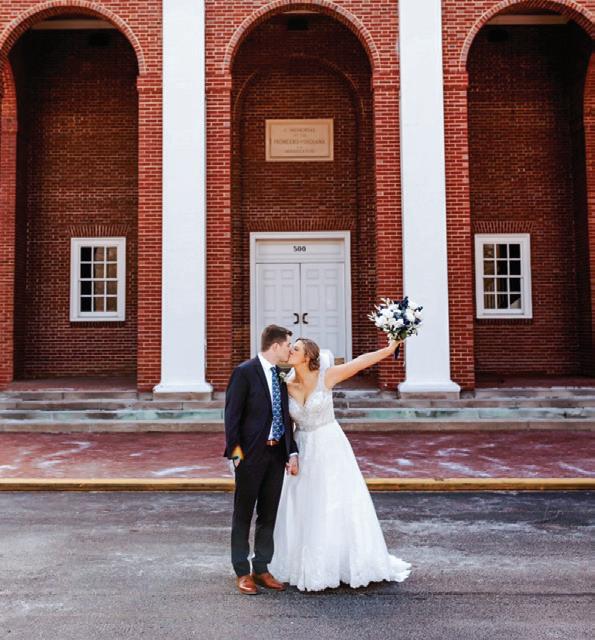 . Will Amberger ’19
. Will Amberger ’19
as a child, when our family vacationed out of state, we always sang “Back Home Again in Indiana” when we crossed the state line on our way home.
.
Philip
Coons ’67
i started teaching government at Colby College in Waterville, Maine, in 1978. Our two young children and my spouse, a high school literature teacher, would spend weekends driving up and down the coast looking for affordable shore front. We found it in Prospect Harbor, though we stretched in order to make the purchase. The little ocean camp on three acres slowly became a year-round home as we built three additions over a dozen years. We settled there permanently in 2007 and we have since been living our lifelong dream. We face open ocean with two small isles visible from our home—Old Woman and Old Man. Here we are unable to forget about aging because the two isles remind us daily of who we are.
 . Roger W. Bowen ’69
. Roger W. Bowen ’69
i was born in cincinnati, went to grade school in Kentucky, and graduated from high school in Columbus, Indiana. But I live in California, am married to a native Californian, and I LOVE California. So THIS is home. A cousin of mine in Dayton, Ohio, used to ask me, “Skip, when are you coming home?” I told him, “I AM home,” in the Los Angeles suburb of Lomita.
. Clifford L. “Skip” Lindeman ’64
WABASH.EDU 31
i completed the dual degree program with Wabash and Washington University in St. Louis and was commissioned as a Naval officer in 2002. I began the nuclear power training pipeline on my way to the submarine service. In the years since then, I have moved 17 times as my Navy career progressed, including two tours in Guam, where I currently serve. I consider our great nation to be my home, but it would be incomplete without my wife—my heart. I have lots of stories of returning home, but the most recent and meaningful was when I returned home from deployment onboard the submarine I command, USS Jefferson City (SSN 759). We were deployed to the Western Pacific from April to October 2021. My crew performed as trained and exceeded my wildest expectations. Returning home to my wife, Liz, and my two sons, Callum and Angus, in Pearl Harbor left no doubt in my mind that I was home.
 . Joe McDowell ’01
. Joe McDowell ’01
Home is wherever my family, friends , and loved ones are. These are the people that make any space feel like a home, somewhere I belong
nineteen houses later, we are living in what I presume will be our final home. So what is the difference between the houses in which I lived and the subset of them that I would have called “home?” It seems to me that a house is just a structure where I can live. On the other hand, a home is a place where I am comfortable, surrounded both by things that have special meaning to me as well as by people I love. So, a home could be a house or an apartment or an underground cave, as long as I feel that I belong there. Maybe home is just a precursor of things yet to come. According to Charles Henry Parkhurst, “Home interprets heaven. Home is heaven for beginners.”
. Jack Hauber ’66, excerpted from his book, What I Am is What I Was When…
“Home interprets heaven. Home is heaven for beginners.”
.
32 WABASH MAGAZINE Big Question | continued
Kenny Coleman ’22
for those of us who lead peripatetic lives, the simple question, “Where’s your home?” can be fraught with emotion.
I spent 35 years serving our country, first as a Peace Corps volunteer and then as a foreign service officer. I lived in seven countries, plus the D.C. area, in more than two-dozen apartments, duplexes, and houses, in and out of walled compounds. For 25 years of that, every move included not just me, but my wife, also a foreign service officer, and our son. We pulled up stakes every few years and moved to our next posting. Overseas postings were usually to places we had never been before, assigned to leased quarters filled with standard government-issue furniture.

This was a richly rewarding and meaningful career, but in many ways a rootless one. Kids have a particularly tough time with this, as often they have no memory of, or attachment to, a U.S. address beyond the few weeks they spend at grandma’s house in the summer. My son’s college application essay began with, “Stacks of cardboard boxes have defined my life.”
Of course, we all carried the things that made each new dwelling a home— beloved stuffed animals, an artificial Christmas tree with its ornaments, favorite art to brighten the walls. A strong culture of creating the “family of the moment” binds the foreign service together. There’s even someone at every post responsible for creating events that make everyone feel like a valued member of the community. There are sponsors for each new arrival, holiday parties, poolside barbecues for the teens, a bridge group for the empty-nesters, if that’s their thing. Nobody goes uninvited for Thanksgiving or Christmas.
Most of these temporary strong bonds inevitably weaken as we move on to the next posting, but some have surprising powers of endurance. A dozen years after I retired, most of the staff at Embassy Yaoundé in Cameroon, West Africa, are still in touch with each other thanks to Facebook, and when there’s not a pandemic, we enjoy periodic “Camereunions” in Washington.
I used to answer that home for me was, “Pot roast at my mom’s house the first night back in the States.” Maybe a better answer was in the lovely cross-stitched sampler in a friend’s dining room: “Home is where the State Department sends you.”
. Steve Fox ’69
after experiencing stage-3 bladder cancer and stage-3A renal failure, I don’t view home as just the roof over my head. My home is in heaven. I’m in no hurry to get there, and I want to help others here on earth as much as I can in the days I still have here.
Little did I know that Wabash College would become my second home, first as a student, then an employee. The academic halls of Crawfordsville challenged me, encouraged me, grew me, motivated me, and opened my eyes to a world far bigger than I’d imagined.

Alaska and Washington, D.C., are among the places I’ve called home in my past. I’ve earned three academic degrees since Wabash. I’ve been away from the College for 45 years, but every time I return, I feel like I’m home again.
. John Kerezy ’77
46227 is unglamorous. A creative realtor might describe it as Southport-adjacent. My parents spent their entire lives nestled within this zip code. It offered them everything they wanted: family, friends, church, and employment. But I always craved more than it could provide, and I’ve spent most of my adult life with no fixed abode, living in places like London, New York, San Francisco, and Los Angeles. But I never really put down roots in any of those cities. 46227, by default, was my home until it wasn’t.
After graduating from Wabash in 1995, I left Indiana, but frequently returned to visit my parents. My mom would always be eagerly waiting at the airport for my arrival. In the years before heightened security, she would ambush me with a big hug as soon as I stepped off the plane, reminding me that I was home in a lovingly aggressive way. My mom died in the summer of 2004. After her death, the first time I set foot in the Indianapolis Airport, she wasn’t there to celebrate my arrival. That’s when I knew life had changed, and 46227 was no longer my home.
San Diego is now my adopted home. Sure, there are no White Castles, and the city no longer has a professional football team. But all things considered, it’s an upgrade over 46227. And it’s the only place in the world where I have family who hugs me at the airport. That’s what makes a city really feel like home.
. Scott Simpson ’95
4 6 2 2 7
WABASH.EDU 33
photo by Anna Tiplick
HOMECOMING
Your generosity helps our students—regardless of where they come from or their financial situation—to receive a world class education taught by teacherscholars who genuinely, passionately love teaching Wabash men. Your generosity allows our students to conduct experiments in Hays and Goodrich Halls using state-of-the-art equipment. Your generosity is reflected in the strength of our nationally-ranked alumni network and internship program. Your generosity allows our students to travel the world with their teachers through immersion learning courses.
When you give talented young men the financial resources to attend Wabash, surround them with excellent, accessible faculty, and link them to our great alumni network—incredible things happen. Life-changing things happen.
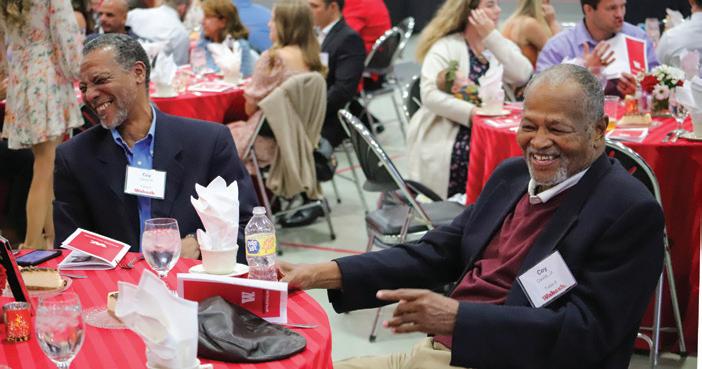





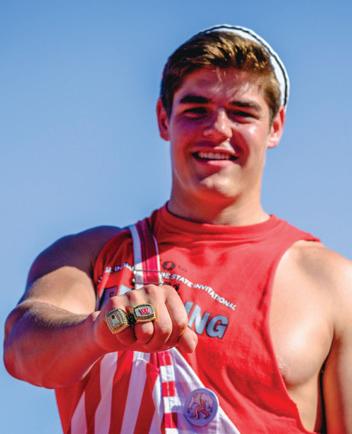

But at its root, philanthropy is about relationships. At its core, philanthropy is about love—the love you show, unconditionally, to the students, faculty, and staff at Wabash College. We are grateful for your love of our College.


34
PRESIDENT SCOTT FELLER at the 2022 Homecoming Luncheon

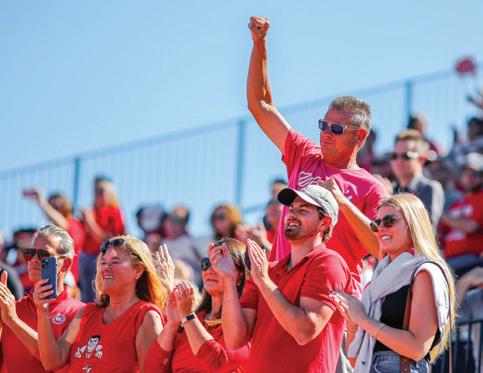

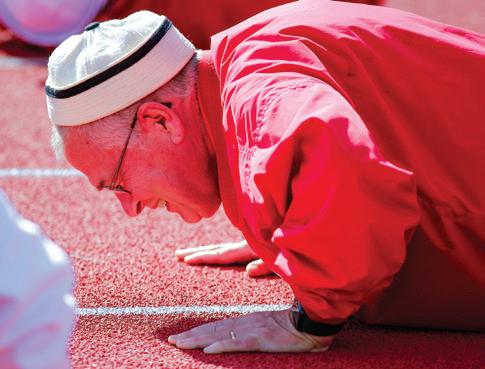









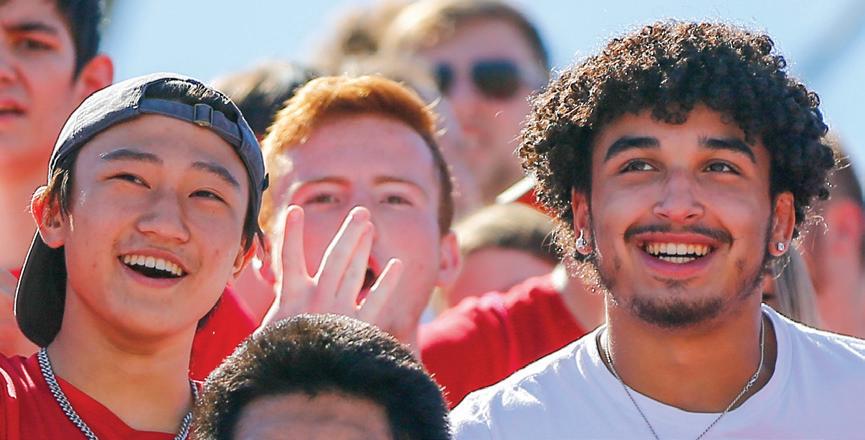

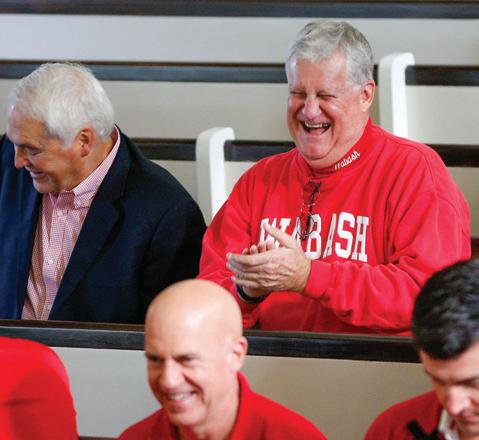
35
Chapel Award Winners
R. Gregory Estell ’85 Frank W. Misch Alumni Distinguished Service Award

Your love for Wabash manifests itself in so many ways. Your enthusiasm for all-things Wabash is contagious, and with your incredible partner in life, Sarah, you have inspired hundreds of Wabash men and women to do all they can to secure the future of our College.
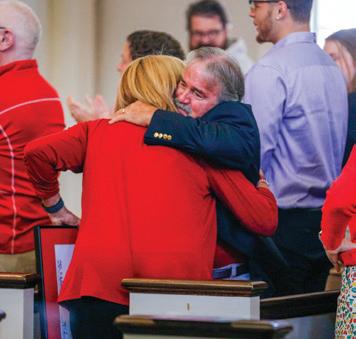

Jacob A. German ’11 Alumni Admissions Fellow
You have earned an honored place among “Thy Loyal Sons” of Wabash. The National Association of Wabash Men (NAWM) and Enrollment Office are thrilled to name you an Alumni Admissions Fellow.

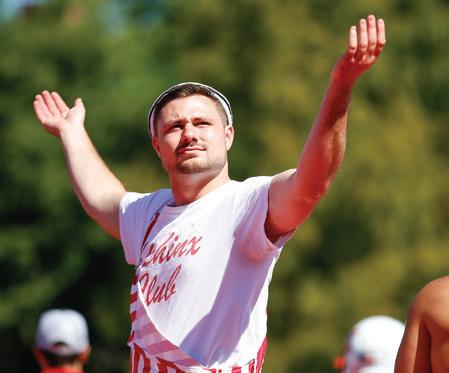

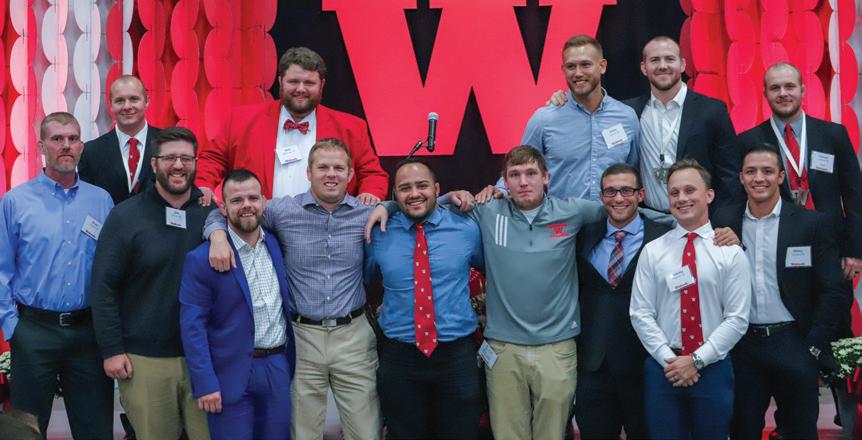
Jacob E. Koeneman ’06 Alumni Career Services Fellow
We are grateful that you model for others the enormous impact an alumni mentor can have on a young Wabash man.


“Youplayfootball,notbecauseit’seasy, youplaybecauseit'shard.It’sametaphor forlife.Yougetknockeddown,youget punchedinthemouth,yougetup,andyou playthenextplay.CometoWabashnot becauseit’seasybutbecauseit’shard. Itisgoingtotesteveryfiberofwhoyouare. Butwhenyoucomeoutofthisplace asyoungguys,you'rebetterforit.”
NateBoulais’03

36
Alumni
Athletics Hall of Fame Winners
Joshua D. Owens ’07
Jeremy R. Wright Distinguished Young Alumnus Award

Joshua Owens, your LinkedIn profile says it all: Entrepreneur, Educator, and Community Activist. You have pursued all of these things with enormous energy and success, and the NAWM is proud to honor you.

Sherry Ross

Honorary Alumna in the Class of 2004 Sherry, for more than two decades you have graciously and gracefully sat on the “front porch” of the Dean of Students’ Office. While your official title may be Senior Administrative Assistant to the Dean of Students, you are so much more to our young men, your coworkers, and our deans—past and present.
James R. Williams ’88
Fredrick J. Urbaska Distinguished Civic Service Award


You truly model for all what it means to think critically, act responsibly, lead effectively, and live humanely. Your experiences prepared you well to solve complex problems, including diving head first to save and recreate Muncie Community Schools. You have motivated and united school board members, community leaders, foundations, teachers, parents, and students to put the school system on solid financial ground with unlimited potential for growth and success.
Elizabeth “Beth” Swift
Honorary Alumna in the Class of 2006
President Feller called you this College’s “hidden treasure” at your retirement last spring, saying, “While entirely surrounded by artifacts, you focus on the stories behind the objects. You are in constant pursuit of the question: Who are these amazing students, teachers, administrators, and alumni from our past? And in doing so, you help all of us understand our own roles in both making Wabash history and preserving it.”
Richard C. Sasso ’82
Clarence A. Jackson Distinguished Career Achievement Award
Dr. Sasso, the men and women of Wabash are in awe of your accomplishments and the ways you have lifted your entire profession while maintaining your focus on patient care. We are proud to honor you with the Clarence A. Jackson Distinguished Career Achievement Award.
 Front row (left to right): Chris Davis ’93, diving; Reece Lefever ’16, wrestling; Conner Lefever ’16, wrestling; Riley Lefever ’17, wrestling.
Back row (left to right): Joe DesJean ’03, basketball; Nate Boulais ’03, football; John Holm ’12, baseball; Mason Zurek ’16, football.
Front row (left to right): Chris Davis ’93, diving; Reece Lefever ’16, wrestling; Conner Lefever ’16, wrestling; Riley Lefever ’17, wrestling.
Back row (left to right): Joe DesJean ’03, basketball; Nate Boulais ’03, football; John Holm ’12, baseball; Mason Zurek ’16, football.
WABASH.EDU 37
Alumni Chapel Award Winners
Framing House & Home
 by Derek Nelson ’99
by Derek Nelson ’99
what is it to have home, to be at home? It’s one of those things that everyone, or almost everyone, knows. But it’s also elusive. No one can quite say why or how they know they feel at home. Yet when they know, they know. It’s a mystery. Theology, the discipline I spend most of my time trying to work within, is eager to noodle around in mysteries like this. Theology thrives at the edges where knowing meets not knowing.
So I’ll propose a thesis, just to get the mystery on the table so we can prod and poke at it. How about this: a home is place where we experience belonging, comfort, and delight. Let’s think about those last key terms in turn, and see how our thesis fares.
Belonging
In Robert Frost’s poem “Death of the Hired Man” a farm couple is debating what to do with their ailing former hired hand who has come back and knocked on their door asking for help. He left, we are made to understand, under some unsavory conditions, and now he is in need. The husband says the fellow ought to go instead to his brother’s house, not so many miles away. After all the brother is rich, “a director in the bank...” But the farmer’s wife protests and says “he has come home to die.” The husband mocks this idea, but is told, “Home is the place where, when you go there, they have to take you in.”
That’s a powerful way to think about the social aspects of home, certainly. “Home” has a “they” who take you in. A friend of mine recently wrote a book called “The Comforts of Home.” For her, “home” means forming attachments with other people in a way that makes you feel (and be!) safe and secure. She grew up in Romania during the terrible upheavals they experienced at the end of the Cold War. She has migrants and refugees in mind when she considers home. So “home” is about relationships, and thus a sense of belonging. I came to feel at home at Wabash College, in Crawfordsville, in Indiana, when I formed attachments with people who knew more about the place than I did and were very different from me, yet found ways to connect with me. To “belong” to something is both active and passive; I can actively sign up to be a part of a club or team or organization, but a sense of belonging is something that I also undergo when others accept me as their peer.
38 WABASH MAGAZINE
So “home” is about relationships, and thus a sense of belonging.
Comfort
Home is a social concept, to be sure. It requires and deepens a sense of belonging. But when I think of “home” it has a place, a space. Yes, people and pets and various social “others” are there, too. But we have other words for that, like family, or community. Home is walls, floor, and a roof. And it exists for our comfort. Like belonging, comfort is a term that has many different registers. Once I move into a new house or apartment, it might feel like a glorified hotel room until I start to know it better, and thus get more comfortable there. I learn how to control the temperature, I fix the broken screen door hinge, and a in a thousand other ways make the place more comfortable.
Etymologically, “comfort” comes from Latin “con-fortare,” which means to make stronger. When I go to my home after a long day of work at Wabash, I am strengthened for other activities, including working the next day. Were I to leave my place of work to a broken home, one where I could not feel safe or be comforted, then I would be accordingly less able to do my work, to pursue my interests, to extend myself into the world and use what gifts I have. In that sense, “home” is both a descriptive and a normative idea. It describes places where we go to sleep, eat, and share life with others. But intrinsic to it is a notion of what a good home is, one where others accept me, and where I can be comforted, strengthened, for the work ahead. And it is tied to the theological notion of vocation, about which Bill Placher wrote so beautifully and so often. A good home strengthens you for some purpose, some activity, and that purpose is your vocation, your calling.
Last year I spoke to the faculty of theology at Copenhagen University on the idea of “dwelling.” Sometimes the Bible speaks of Jesus as abiding or dwelling with the believer in faith, and I was pushing that to explore texts where it’s as though the incarnation was God “dwelling” in Jesus of Nazareth. A student asked a pointed question: “Can a prison be a home?” He works as a prison chaplain and had been mulling it over during my lecture. I didn’t know how to respond, and even now I don’t quite know. Surely there are places in a prison where one can (or should be able to) feel safe, and be strengthened to face another day. Surely there are friendships and a sense of community, no matter how imperfect or tenuous. But home is also something you can and should leave. In Genesis (quoted again in Matthew and Ephesians) we read, “For this reason, a man leaves his father and his mother and clings to his wife, and they become one flesh.” You leave home to become an adult. Put another way, homes are for sending, not just for staying comfortable. If you have to stay there, it isn’t a home, not quite.
Perhaps this aspect of home has taken on a special relevance during the COVID-19 pandemic. So many were forced to stay home, and many others were desperate to be safe at home but could not be because their calling was to work in hospitals or essential services. Home means something different now to the telecommuter. You’re always around your work if your living room is your office. Walking past the table to get a bowl of nighttime ice cream you notice that stack of papers you haven’t taken care of. Or desperate for elbow room you begin to resent the others around you. Or you crave the commute you used to have and the chance it gave you to decompress. Still others were finally motivated to get their homes in better shape. The pandemic made us think about the comforts of home differently in all kinds of ways.

Put another way, homes are for sending, not just for staying comfortable.
If you have to stay there, it isn’t a home, not quite.
WABASH.EDU 39
photos courtesy of Derek Nelson
Delight
That leaves delight. Delight means that it feels good, feels right, to be in this place, among these people with these things. But delight isn’t something we can control. Delight happens. There is a surprise element to delight, like when a loved one brings home dessert unexpectedly or the light comes in the east window just right as you drink your morning coffee. Being around things of beauty, for instance, lovely furniture that I might have made, seeing a sun I didn’t make set over a forest I didn’t plant—that’s delight. We feel most at home when this is happening.
A German thinker whose ideas I think are extremely powerful and timely is a sociologist and philosopher named Hartmut Rosa. He talks about resonance, by which he means, in an admittedly Germanic definition, “a form of worldrelation in which subject and world encounter each other and are mutually transformed.” Resonance happens when you, the experiencing subject, can’t merely control the world you’re relating to. It’s the difference between, for example, seeing a wild animal in its own habitat when you're on a walk and seeing one in a controlled environment at a zoo. Or between a genuinely pleasurable conversation among friends and a staged political debate between opponents. The conversation features people deeply listening to each other and then responding after having been affected by those spoken thoughts. The debate involves the same pattern of one person speaking, and then another, but each is seeking to control the outcome, and this is not resonant.
A resonant experience is something like what I’m calling delight. When I hike on a mountainside, thoughts come to me, and I’m surprised by them. I might end up solving a problem I’ve been worrying over, or suddenly understand an argument I had with a coworker.
That’s resonance. It’s not being in control, but rather being open to be changed. Rosa notes that many technological advances we depend on to control the world have a dark side. It’s nice to have a camera and email and a stock-market report on my phone, but when I do it’s harder to relax at home or simply take in a show. Our technological advances open up the world for us by helping us control it, but they also capture us. Rosa talks about the snow day, when plans get canceled and we just sit in wonder. That’s delight.
Being at home in your body, your dwelling, and your community happens when you resonate with the world, when your home speaks to you, tells you who you are, where you are, why you are. It’s when you desire the real material, the real thing. Ash floor. Stone table. Poplar beam. Good homes are full of delight because they contain elements of beauty, whether it is a picture of a beaming kid on her first day of school, or a treasured antique hope chest. There is, in fact, a kind of miracle that happens when a house becomes a home. We contribute to that by our living, but mostly we undergo it, receive it, experience its beauty. So delight, as well as comfort, lives in this fascinating tension between activity and passivity, between work and grace.

40 WABASH MAGAZINE
Good homes are full of delight because they contain elements of beauty, whether it is a picture of a beaming kid on her first day of school, or a treasured antique hope chest.
Home on My Mind
For two reasons this notion of “home” has been on my mind recently. One is personal, the other academic. On a personal note, I did something kind of crazy as my own pandemic project. I built a small house on our property, and furnished it with homemade things. And this got me thinking about the environmental impacts of the way we build and live in our dwellings, as well as the theological implications of the idea of home. So I hosted an academic conference at Wabash in May 2022 called “What Is It to Have a Home? Creation Theology and Domestic Life.”
The house is small and green, and is intended as an experiment in green home design, so it’s called The Evergreen (also, my wife is from and terribly misses the Pacific Northwest!). It is a timber frame. That means it is not built from dimensional lumber like 2x4s and 2x8s, but rather by large posts and beams. But unlike “post and beam” construction, there are no metal fasteners in the frame. Everything hangs together by tenons fitting into mortises, and the joints are then pegged together with wooden dowels. The walls are SIPS— structural insulated panels. They’re like huge sandwiches of half-inch plywood on either side of foam insulation. They simply are lag screwed to the frame. The whole house can be taken apart and reused somewhere else, or reconfigured in place. What’s more, this kind of design adds centuries to the life-expectancy of a house. It also has a continuous cloak of insulation around the home, so heat loss (or in the summer, heat gain) is negligible.
The furnishings were all made with environmental design and simple beauty in mind. Local woods from appropriate species make up the floor, ceiling, cabinets and furniture. Long-lasting products were chosen whenever possible: concrete
countertops, a deck from 99% recycled post-consumer waste, fiber-cement siding rather than vinyl, and so on. The goals were to build something that could last for 250 years (i.e., the opposite of “disposable, single use!”), was 500 square feet or more, cost $25,000 or less, and could be taken apart easily to be moved or repurposed. I think I hit all my goals, but we'll have to wait and see how long it lasts!

The conference on home brought together theologians from Scandinavia and North America. The symbol most often used in the Bible to name God's relation to the world is, admittedly, “kingdom.” This presents some problems in the contemporary day. I am more or less morally opposed to monarchies actually governing countries. There is a maleness to “kingdom” that the Greek biblical word basileia, which it translates, does not have. But most important is the kind of subjectivity the term evokes. In a kingdom, there is little for us non-kings to do except obey
Another symbol used in the Bible for God’s presence on Earth is that of home. One of the two oral sources behind the Creation stories in Genesis, the so-called “Priestly” document, maintains literary integrity all the way up to the end of Exodus when the Israelites build the tabernacle. In other words, the creation of the world is not completed until there is a symbolic dwelling place for God. Then there are the texts in John about God “dwelling” with humans, that “the word was made flesh and dwelled among us.” And going right to the end of the Bible, the voice from the throne in the heavenly city in Revelation says, “Surely the home of God is among mortals...” If ever you'd expect “kingdom” language, it would be from a throne! But “home” or “dwelling place” is what we get instead. What's
more, the subjectivity evoked by “home” is so rich. I have some privacy in a home, some autonomy. But I also know there are house rules to be followed. House rules are different than a king’s laws. They’re more likely to be tied to my own well-being, and less about a ruler’s whim. The kinds of things we do in homes are different than we do in public, in a government. Focusing on a different symbol can lead to a quite radical re-thinking of religious themes that may have become so familiar they’re stale.
I put these two experiences of home together by writing a short documentary film. SALT Productions, an Emmy-award winning video production company, shot the film over a week in June. The result was a tenminute film called “Framing House and Home.” I normally work with centuries-old texts and wind them into rational, written arguments. To have to think visually, in an evocative rather than persuasive way, was a welcomed challenge. If you’d like to see how I put these two ideas together—the timber frame of an eco-friendly house along with the conceptual, theological framing of what it means to have a home—I hope you will enjoy the film, which you can find at www.attemptedjoinery.com
WABASH.EDU 41
Derek Nelson ’99 is the director of the coordination program of the Early Career Pastoral Leadership Development Programs Initiative and professor of religion, Stephen S. Bowen Professor of the Liberal Arts at Wabash College.
Little Place Farm
by Fred Wampler ’57
in its 300 years of existence, my wife, Lura, and I are only the third owners of Little Place Farm.
We purchased the old farmhouse near Valley Forge National Park in Pennsylvania in 1971. The house was built in 1732 by Enoch Walker 45 years before then-commander George Washington of the Continental Army encamped there in the winter of 1777–78.
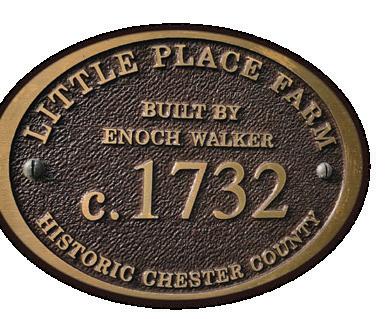

The farm originally included several hundred acres, which the Walker family received on a grant from William Penn and King George II. The Walkers were Quaker farmers. Generations of the family resided there until 1942 when it was sold to an editor of the now defunct Philadelphia Bulletin newspaper, after which the we bought it from his widow.
At the time we bought the house, which is now situated on six acres of ground, Lura and I were living nearby. We were expecting our third child and found ourselves in need of more room for the growing family. We were searching for a unique home with personality and figured it probably had to be an older residence surrounded by ample land.
raising our family at Little Place Farm and preserving it for posterity has certainly been a unique privilege and honor for our family.
One of Lura’s favorite memories is when the children were still moppets, and I was busy working long hours in the ‘rat race.’ Friday evenings were special, because the family got the chance to celebrate two whole days of complete freedom and Daddy being home.
“We would have a family party,” says Lura. “The kids and I spent the afternoon decorating the dining room with crepe paper and balloons. Dinner was always all anybody wanted of my country fried chicken, my mother-in-law’s recipe for kidney bean salad, and was followed by either ice cream or apple pie.
“Then we would play recordings of ‘Peter and the Wolf,’ acting out the various parts of Peter, the wolf, grandfather, the duck, or hunters. Many friendly arguments arose over the assignment of various roles,” she says. “We also enjoyed musical parades with appropriate hats and the American flag, marching around the dining room table multiple times and into the parlor.”
The evenings concluded with horseback rides up the stairs to bed.
“Dad proved to be a very capable and adroit ‘horse’ in those magic days,” says Lura.
little place farm is on the local register of historic sites and eligible for the national designation.
Walls of the original house are approximately two feet thick. There were six rooms, two on each floor, plus a full basement. The floor plan is quite similar to houses in Philadelphia and London.
The layout of the house is what’s known as the Swedish plan, which features a triangular-shaped chimney with multiple flues to provide diagonal corner fireplaces for heating each room on all floors. The kitchen was, in all probability, a separate small building with its own chimney. It is now connected to the main house. It has no cellar but rests on chestnut beams laid directly on the ground, with chipped rock between them. These are surprisingly intact, no rot or termite damage.
A two-story expansion was added around 1820, nearly doubling the size of the house. It included an addition to the basement, and greatly increasing ceiling heights to preserve the roofline. It also featured a few minor touches of elegance. To facilitate this addition, the entire north wall of the old house was demolished so its stone could be reused in constructing the new part.
Despite having installed modern necessities such as electricity, bathrooms, and hot water heat, the house is mostly unaltered from the time it was built.
42 WABASH MAGAZINE
our three now-adult children happily grew up at the farm. They all have great interest and respect for artworks and antiquities. In their schooldays, many class projects were penned about various aspects of their home, pets, possessions, and related experiences.


One experience that stands out in memory comes from the 1976 Bicentennial.
On the evening of July 3, the Bicentennial Wagon Train had already arrived for the celebration with its many, many Conestoga wagons that traveled for weeks from all across the United States.
The National Park Service, which had just been gifted Valley Forge State Park from the State of Pennsylvania, was responsible for contributing a well-promoted fireworks extravaganza to the festivities. The firework show was billed as the “best ever,” and it truly was.
We had invited about 30 friends to watch the show with us, which started at 11 p.m. and lasted until midnight. Our guests and their children bunked all over the place, filling all the beds, cots, sleeping bags, and the hayloft in the barn.

A large and enthusiastic crowd was anticipated, but nothing like the more than
two million people who actually showed up for the celebrations. The park rangers, state troopers, and local police were overwhelmed and forced to abandon trying to control traffic. They let people park wherever they could find a spot.
I encountered one fresh-faced young man who said he and his buddies had bicycled all the way from Boston but could not find any place to camp because the park campground was already at capacity. I gave him directions to our house and instructions to pitch his tent by our stream.
Returning home after the fireworks, we were surprised to see around 30 tents with bare feet sticking out and bicycles parked nearby! Word had gotten around. Some of these young men stayed on for several days to visit sites in Philadelphia. A few kept up with us by mail for a few years.
When we roused everyone bright and early the next morning to attend the sunrise service in the park, people were still walking past our house about five abreast to retrieve their cars.
It was an unforgettable night for our family. We were happy to welcome all to Little Place Farm, to our home.
Among my other fondest memories were the two times we entertained former director Richard Bowen and the Wabash Glee Club for an after-concert soiree when they visited Philadelphia. There is absolutely nothing more thrilling than to hear those lovely guys render our “Alma Mater” in our own parlor.
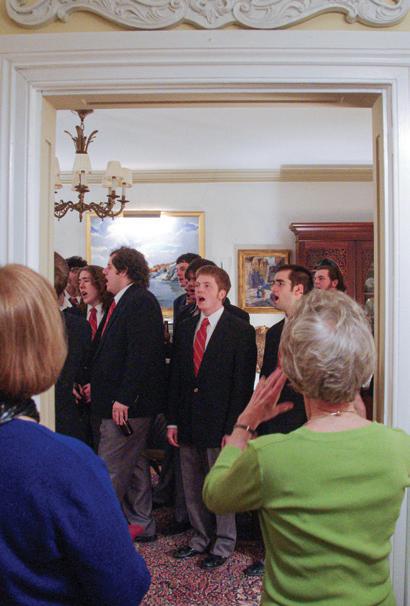
 We live and sleep in every room, even those on the third floor, although the large parlor usually only sees brisk activity at Christmas and parties.
The house is furnished with antiques and artworks throughout, even in necessary workaday spaces like the kitchen. Visitors often comment that the place looks like a museum. I started collecting while I was still at Wabash, and Lura enthusiastically shares my interest.
photos courtesy of Fred Wampler ’57
We live and sleep in every room, even those on the third floor, although the large parlor usually only sees brisk activity at Christmas and parties.
The house is furnished with antiques and artworks throughout, even in necessary workaday spaces like the kitchen. Visitors often comment that the place looks like a museum. I started collecting while I was still at Wabash, and Lura enthusiastically shares my interest.
photos courtesy of Fred Wampler ’57
WABASH.EDU 43
photo by John Zimmerman H’67
Finding Home in the Backyard
 by Kim Johnson
by Kim Johnson
Of all the places in the world Bryan Gonzalez ’03 has been, rural Iowa is the place he loves most.
as a junior in college, Bryan Gonzalez ’03 didn’t know what he wanted to do with his life. The religion major and German minor from Fishers, Indiana, received a $1,000 Dill Grant in 2002. His curiosity and the generosity of a professor landed him in Europe for a summer of exploration.
“(Emeritus) Professor of Classics John Fischer had invited me to visit him overseas, so I hung out with him for a couple of weeks,” says Gonzalez. “I went to Italy, because when you think about religion, you think of Christianity and Rome. For a few weeks, I lived in a monastery at the birthplace of St. Benedict in a small Umbrian town called Norcia.”
Then an introduction to a host family led him to Germany.
“There I got an unpaid internship at the Topography of Terror, which was the headquarters of the Nazis,” he says. “For a month, I passed out headphones to people, and they would take self-guided tours. That was my summer.”
When he returned to campus for his senior year, Gonzalez applied for a Fulbright to teach English in Germany. He was not selected but still wanted to return to Europe. Something drew him back to Italy and the monastery in Norcia.
“The monastery would hire young men out of college to manage some of the secular affairs, like running the gift shop,” he says. “They paid 500 euros a month, plus room and board. I signed up for a year and enjoyed it so much I stayed for two.
“It was a great formative experience for me. I realized I didn't know my faith very well,” he says. “And, I was a religion major at Wabash—having studied scripture and lots
44
of religious texts—but I felt this desire to learn more about my faith.”
That “spiritual awakening” led him to enroll in a five-year extended master’s degree program in Austria specializing in philosophy and theology. There he met Kilty, a young woman from Iowa who was studying abroad for a semester.
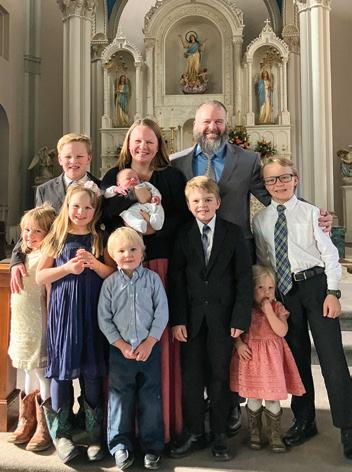

“Why fall in love with somebody who’s going to be gone after three months?” he says with a laugh. “Well, that happened. In the third year of my program, I ended up studying abroad in the United States. It’s all relative, right? I went there for a year, we got engaged, and she graduated all within a three-day period.”
They married in 2009. In 2010, he graduated, they had their first child, and moved to Iowa near Kilty’s family.
The monastery he worked for in Italy was looking to start a fundraising program and asked if he would be interested in the position.
“I was working remote before it was cool— seven time zones away.”
After six years of working odd times of the day and night, he moved to his current position in development for a free healthcare clinic in Des Moines.
in 2020, with six kids and number seven on the way, Gonzalez and his wife, decided it was time to leave their .19 acres in the city for a place with more space.
“It was becoming apparent we needed more space in the backyard. The kids need to run around,” he says. “We always had to ask them to play baseball toward the house to spare the neighbors of broken windows.
We replaced eight windows in our house in seven years.”
They built a house on eight acres in rural Iowa, 20 minutes outside of Des Moines and created a home.
“Home certainly means the place you lay your head at night and the place that you eat your meals. We eat three meals a day here. We do our schoolwork here,” he says while sitting at the kitchen table. “This area is important for us.
“But home is also the people you love. It’s your spouse and the people she has birthed into this world,” Gonzalez says. “I think of home in those two senses. In both of those senses, I just love being here with them.”
Kilty agrees home is where you are at peace and all together.
“It’s where you’re able to do what you love,” she says. “People get so caught up in achieving things and doing things. At the end of the day, it’s all meaningless if you don’t have someone to love.”
The family has made quick use of their space for learning, loving, growing, and sustaining. The 40'x40' garden, 43 chickens, and raw milk from an Amish family nearby feeds their bodies and gives them a greater appreciation for the process of gathering and preparing food.


“Moving to the country has allowed us to drive by farmers harvesting corn in the fall and realize there is a sense of gratitude for seeing how things are made,” says Gonzalez. “We do a lot more of our own cooking, the kids are great cooks now. When the winter comes, there’s a lot of bread baking. When you get a fresh baked loaf of bread you want
to gobble it up because it’s good. But you don't want to gobble it up because you just spent three hours making it. You spread butter churned that morning and jam made from fruit you harvested in the summer.”
Being in the country has given the kids a new-found freedom and has widened their classroom.
“We homeschool— so when we’re talking about science, we have a lot of science in our backyard,” he says. “I have learned so much about the moon, for example, just living out here because you can see it and the stars. It is gorgeous. The sky is beautiful in the country.”
“We are exhausted at the end of every day,” Kilty says. “Then I look at the pictures that I took or one of the kids took on my phone throughout the day, and I think, that was a good day.”
the countryside where he lives in Iowa now looks different from the many countries he discovered as a Wabash student and young alum, but even then, he knew he wanted something more than traveling the world by himself.
“Wabash afforded me the opportunity to do some extraordinary things. I never thought I would be a world traveler,” he says. “I distinctly remember thinking, this is lovely to do, but I would much rather be sharing this with someone I love—a spouse.
“I’d rather be here at home with my family than any of the exotic places that I’ve been.”
Left to right: Bryan Gonzalez ’03 and his kids butchering a chicken; Kilty Gonzalez and two-year-old dog, Argos; the family eats approximately 18 fresh eggs for breakfast each morning; Bryan, Kilty, and their eight children following the baptism of their newest son born in November 2022.
WABASH.EDU 45
photos courtesy of Bryan Gonzalez ’03
REIMAGING HOME
when you ’re 30 and have lived in 50 different houses, defining home is complicated.
“It’s what we do,” says Ian Starnes ’11, a second-generation artist and home renovator.
“My parents would buy a house and renovate it while living in it,” he says. “My mom is a saint.”
Starnes’ father began renovating homes in Mooresville, on the southwest side of Indianapolis.

“He renovated an old farmhouse. Then he bought the house next door, and he renovated that,” Starnes says.
“Then, he bought the one next door to that. Before he knew it, he had done five houses on that street. And then, he started buying homes in other neighborhoods in Indianapolis. In the 80s and 90s, he was buying those mansions on Meridian Street and renovating them. They were in disrepair.”
When Starnes was in first grade, his family moved to Naples, Florida, where his mother had grown up, and they started the renovation process all over again.
starnes did not intend to follow in his father’s footsteps. He planned to study international law.
He credits two classes for helping him see otherwise—an art class his freshman year and constitutional law.
“Emeritus Art Professor Greg Huebner H’77 was so instrumental for me,” he says. “Then I took constitutional law with Political Science Professor Scott Himsel ’85. I remember all of the guys in that class were really fired up. Himsel would say, ‘Ian, what do you think about this?’ And I didn’t care at all.
46 WABASH MAGAZINE
The guys in the class would say, ‘What side do you stand on?’ I don’t care. I didn’t find it interesting at all. I would be a horrible attorney.”
After the art major graduated from Wabash, he did graduate work in business for artists, and a few chance meetings led him to a stint traveling the world in the fashion industry for Ralph Lauren, Bird Dog Bay, and later as a cowboy on a ranch in Wyoming.
“Then I said, ‘I’ve got to pump the brakes.”
Starnes married his preschool best friend, Caroline. They had lost touch when he moved to Florida but later reconnected through a fellow Sphinx Club member at Wabash. They moved to Bloomington where she was enrolled in graduate school.

There, his desire to conserve spending and his itch to jump back in to renovating led them to purchasing their first home.
“I basically put all my money on this gross little condo outside of Bloomington,” he says. “We rehabbed it and it ended up being perfect. It allowed us to save enough to be able to move to Florida and do it again.
“We’ve renovated six properties,” he continues. “Now, like my mom, Caroline is a saint, living house-tohouse through the renovations. It’s an awesome way to work, but it’s very high risk.”

Starnes considers himself more of a minimalist which proved beneficial when Hurricane Ian tore through southwest Florida in September near where he now lives in Sarasota.

“My mom is a very successful furniture dealer here. She loves furniture, but she’s also really quick to let it go,” he says. “I was down at the store and three people came in looking for receipts for prior purchases. They said, ‘My insurance needs it. All of our stuff is gone.’ The hurricane puts into perspective that it’s just stuff in the house.
“The house I considered my home as a kid—where I lived the longest—had nine feet of water and everything on the inside was gone,” he says. “The water was so heavy, it sunk the foundation. It might have to be torn down.”
As Starnes and his wife raise their one-year-old, Mary Louise, they recognize home isn’t necessarily
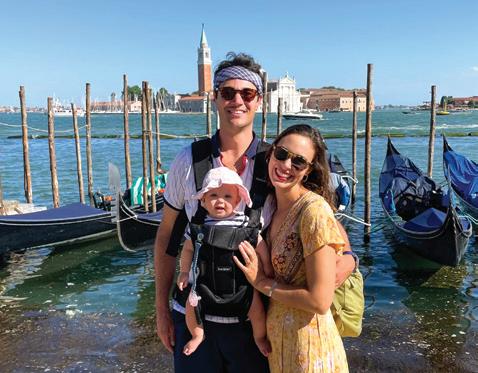
a “physical dwelling” or even a particular place, but something that helps you build identity.
“It’s a place that allows you to learn and grow,” he says. “There’s no way I would be doing what I’m doing with design and home renovations if I didn’t go to Wabash. There’s not a class on that at Wabash, but it taught me how to think—whether working in the fashion industry, as a cowboy out west, or putting on an asbestos suit, gas mask, and going into a house and just sweating, beating down the walls for three days. Wabash gave me confidence and it became a part of who I am.
“I have been to 100 countries, but nothing compares to going to Dari-Licious in Crawfordsville. Nowhere is like the Naples pier, or my grandparents’ trailer south of Crawfordsville, or the Wabash College campus. Those places are home in the sense that there are so many memories. The perspective I gained from traveling helped me identify what home is and allows me to really appreciate it even more.”
WABASH.EDU 47
Left page: A newly renovated Ian Starnes ’11 home in southwest Florida; above left to right: the renovated home’s interior; Starnes, his wife, Caroline, and daughter, Mary Louise; Starnes in front of one of his childhood homes on Meridian Street in Indianapolis.

48 WABASH MAGAZINE
On an island roughly the same population and land mass as Indiana, Ireland and Northern Ireland have been embroiled in a geopolitical and religious conflict for hundreds of years. Conflict turned violent in the 1960s, leading to a three-decadelong period of bloodshed known as “The Troubles.”
As part of the Wabash Pastoral Leadership Program (WPLP), a group of 14 early-career pastors got an up-close look at the ongoing work toward peace and reconciliation, to better equip them to be reconciling agents in their local Indiana communities.
as the bus turns left onto cupar way, the usually exuberant group of pastors grows silent.
Bright colors, bold shapes, and calls for unity, love, and kindness cover the expanse of view out the right-side windows. But so does the concrete wall behind the color that is topped with several feet of fencing and barbed wire that stretches as far as the eye can see.
The bus slows to a stop. The pastors exit and cross the street. It is one of the most popular destinations in Belfast but there are surprisingly few other vehicles. There are even fewer words spoken as they step up onto the sidewalk.
They have 10 minutes to walk a couple hundred yards to where the bus moved down the road—10 minutes to comprehend the generations of division, hate, spilled blood, and thousands of lives lost that led to the construction of these walls.
Messages scribbled in Sharpie by people from around the globe sound hopeful, but are simplistic for such a complex and deeply rooted history. “Love each other; we aren’t as different as you might think.” “Through peace anything can be done.” “Peace cannot be stopped by force; it can be achieved by understanding.”
The Peace Wall on Cupar Way is one of several built in Northern Ireland in the 1970s as an attempt to separate the Catholic republicans and nationalists who desired a united Ireland and the Protestant loyalists and unionists who wished to continue allegiance with Britain.

WABASH.EDU 49
In 1998, the Good Friday Agreement was signed, bringing an end to the most overt violence and discrimination. Since then the number and length of peace walls built has doubled. And to this day, the streets have iron gates that close every night so no person or vehicle can pass to or from Falls Road and Shankill Road in Belfast. The blocks between the two roads were the site of the worst violence of The Troubles.
With the signing of the Agreement nearing its 25th anniversary, some in Northern Ireland believe it is time for the walls to come down. However, that is not the sentiment of the overwhelming majority. There are still many on both sides who believe the walls must remain in place. One never knows what “they” would do to “us” given the opportunity.
the 10-day study tour and the culmination of two years of learning together, placed the 14 early-career pastors in the latest cohort of the WPLP in the middle of the island’s struggle to heal and move forward.
“Sometimes by going out of our own context, we’re able to have eyes to see more clearly what is actually happening in our very own context,” says Libby Davis Manning, director of WPLP.
“We visited cities with such deep divisions. The city of Belfast, for example, is deeply divided between Catholics and Protestants, between Irish and English,” Davis Manning continues. “We can begin to have eyes to imagine what is the long-term ripple effect of the divisions in our own communities now, if they are not tended to.”
The Random House American Dictionary: Pocket Edition defines peace as “freedom from war, trouble, or disturbance.” That’s Belfast now—no war, no trouble, no disturbance—just walls. The American Heritage Dictionary: Second Edition goes a little further in its definition and adds “harmonious relations; public security order; inner contentment; serenity.”
Peace on either side of the stone walls is defined differently by each person, family, and community that has been affected. The personal stories the pastors encountered through stops in Dublin, Belfast, Ballycastle, and southwest Ireland reflect generations trying to emerge into a time of “after.”
The parking lot and adjacent blocks just outside the doors of the Museum of Free Derry is where Michael Kelly and 13 others lost their lives on January 30, 1972, when a peaceful protest was disrupted. That day came to be known as Bloody Sunday.
Huddled around a small group of tables with the pastors, John Kelly recalls with gruesome detail the day of his brother’s death. The two of them, teenagers at the time, left home against their mother’s wishes. The boys were separated until John’s friends dragged him to the scene of Michael’s dying body. Michael’s blood spilled out on his own hands as John held him during the last moments of his brother’s life.

He says he no longer carries anger, though he has made it his life’s work to seek justice for his brother’s death. Even if the solider who was responsible was prosecuted and imprisoned, John admits the outcome would not change, and perhaps he will never feel as though his justice can ever truly be achieved.
The group was introduced to Eugene who lost three brothers when his home was stormed and littered with bullets, literally splitting one brother in half.
A then-young British solider, John, told of being on his way to meet friends at a pub when it was bombed just before he and his girlfriend arrived. The explosion caused the building to collapse killing three of his comrades.
Beryl’s husband was murdered as he walked out the door to his car to go to work. Beryl recalls that that night in her bedtime prayer, her three-year-old daughter Gail said, “There were two bad men that came with guns and killed my daddy. Can you please make them into good men?”
“ We can begin to have eyes to imagine what is the long-term ripple effect of the divisions in our own communities now, if they are not tended to.
”
LIBBY DAVIS MANNING
50 WABASH MAGAZINE
Previous page: a section of the Peace Wall on Cupar Way in Belfast; above: John Kelly shares his story of Blood Sunday in 1972, the day his brother, Michael, was killed along with 13 others.
Alan’s wife and father-in-law were killed when an explosion decimated the family’s butcher shop along with several other businesses on the street. He shared, “If I forgave them, my mother-in-law would never forgive me and I don’t want to damage that relationship. It’s not worth it for me.”
Each person the group encountered came from different backgrounds but their stories were all the same—violent and tragic deaths of loved ones.
With this in mind, the pastors spent a few days north of Belfast just outside of Ballycastle at Corrymeela. The residential retreat center is focused on peace and reconciliation. It intentionally creates opportunities to bring disparate groups of people around the table for conversation— including many groups and individuals throughout the height of The Troubles. Its ideology, “Together is better,” believes that while our histories and identities may be different, it’s the sharing of our stories that can help bring down walls.
Irish for “lumpy crossing place,” Corrymeela sits on a lush green cliffside overlooking the Atlantic Ocean and Scotland—the beautiful landscape and hospitality of the place in direct contrast to the difficult exchanges that often take place there.
Ray Davey established Corrymeela in 1965 after he witnessed the bombing of Dresden as a prisoner of war in World War II. He grappled with the senselessness and destruction of conflict. His work, even as a prisoner of war, centered on building community and belonging for all people regardless of religious beliefs, political affiliation, background, or identity.
Alex Wimberly ’99 serves as the current leader of the Corrymeela community. He recalls a line from Religion Professor Bill Placher ’70: “The best way to show our love to the whole world is to love with a particular passion some little part of it.”
The line serves as an anchor Wimberly holds on to even 3,700 miles away from campus. Corrymeela and the 11,000 people it hosts annually make up the little part
of the world he is currently loving “with a particular passion.”
“It is a place where we are honestly trying to learn from one another. Trying to work through our differences and our conflicts,” Wimberly says. “That’s when we’re doing well. It requires a lot of honesty about how incomplete we are without other people. And anytime we project ourselves as having the answer, or being the hero in the story, we’ve really lost our way. We know the next encounter with the next person is an opportunity to learn more about the world, God, and ourselves. It gives us a more complete picture of our interdependence with each other.”
Every morning at Corrymeela begins with 20 minutes of silence. It’s a time of reading, prayer, meditation, reflection, or writing.
“Silence is such an equalizer. We can all enter into silence,” Wimberly says. “For some of us silence can be very disturbing. For others of us it is really important to have time where we’re listening rather than trying to do or be—where you’re simply receiving the moment as it comes. And silence lets us stop, pause, and allows us to tend to whatever is resting with us or not resting with us.”
Like peace, silence is not always as simple as it seems. Silence can be loud or it can allow us to hear more clearly. Sometimes silence is used as a weapon, or it can be lovely and restful. Silence can be a defense, an offense, or signal complicity—either on purpose or inadvertently.
“Toxic silence is that oppressive pressure to conform to a certain way of being or to look away or disengage,” says Wimberly.
“The toxic silences of Northern Ireland have allowed things to carry on in the church’s
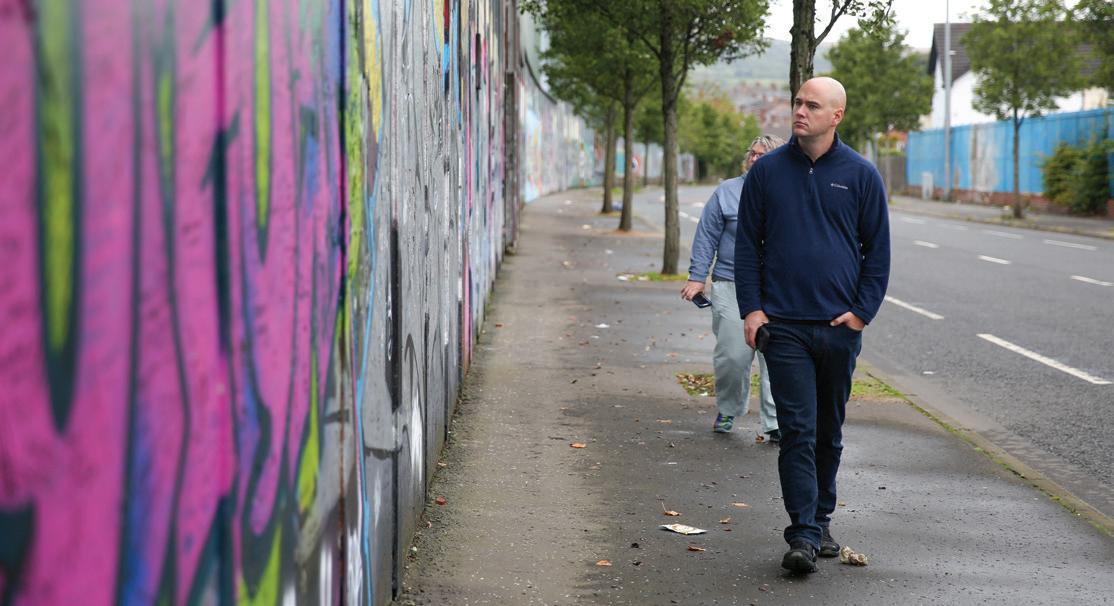
name, in God’s name, in the community’s name. That has done a great deal of damage. Too many remain silent and complicit.”
Fear of saying the wrong thing or of introducing more conflict often leads to silence—saying nothing at all.
“The work of WPLP is to help our pastors understand critical adaptive issues in their local communities so they can theologically reflect, diagnosis, then act—saying and doing the next right thing,” says Davis Manning. “We’re looking at conflict transformation, reconciliation, or relationship accountability, so that over time, we might lead more thoughtfully in the divisions that effect our Indiana communities. We ground our WPLP program in Heifetz’ Adaptive Leadership Theory, and we learn that there is no obvious technical answer to the adaptive challenges facing us. It’s hard to know what the right thing to do or say is in the midst of this acceleration of change and pain and chaos that we’re in, but say something. Don’t say nothing.
“As we’ve seen in the Ireland and Northern Ireland context, once violence is introduced to a place, it’s a tool that is used over and over again,” she continues. “The study tour, I pray, equips early-career clergy to encounter silence, be agents of reconciliation, agents of hearing each other’s story, agents of setting space for understanding across differences such that violence isn’t an outcome for the deep divisions in our Indiana communities.
“Sometimes it takes us leaving, in order to see again.”
WABASH.EDU 51
WPLP cohort seven members Thomas Horrocks and Melody Merida walk along the Peace Wall on Cupar Way in Belfast.
Cohort Seven Reflections
The Wabash Pastoral Leadership Program is funded by Lilly Endowment Inc. and began in 2007. Since then, 105 pastors who serve congregations in 32 Indiana counties and represent 18 denominations have participated in the Wabash program. Directors of the program have included Raymond Williams H’66, Derek Nelson ’99, and currently, Libby Davis Manning.
During their two years as participants, the cohorts study themes relevant to their communities throughout the state by engaging in conversations with influential leaders, including small-business owners, school superintendents, social service directors, judicial officers and hospital administrators, in order to understand the complexity of the challenges facing Indiana communities. Topics have included community well-being, demography and race, the economy, education, hunger and poverty, the justice system, healthcare, conflict resolution, and the environment.
“Early career pastors are great gifts and resources to the entire community. Pastors have a particular way of seeing, of being, and have deep skill sets in relating,” says Davis Manning. “We hope that early career clergy, with local civic leaders, can engage in rich conversation around the adaptive
challenges that are present in that community. And by having these different people—all of whom care deeply about the well-being of that place—can begin to pose and offer new responses to those challenges. No one sector can solve the adaptive challenges by itself. But together, thoughtful pastors and wise local leaders can engage these pressing adaptive challenges and find new life-giving adaptive solutions.”
At the conclusion of year one, the group participates in a study tour within the United States. At the end of year two, they take an international study tour. Cohort Seven studied immigration with travel to San Antonio and McAllen, Texas, and peace and reconciliation in Ireland and Northern Ireland.


“We host study tours for early-career clergy to invite their creativity and their imagination, to set it on fire, to set it ablaze,” says Davis Manning, “so that we can return to our Indiana communities full of hope and possibility, filled with new questions to ask, new respect, or renewed respect for the leadership that exists so that all of us can care well for the places in which we live, serve, and work.”
“Peace doesn’t necessarily mean a lack of conflict. Peace means a deep and abiding care for the well being of a place, of a people—the interconnection of the people in a place. It is something faith leaders seek and tend to in their work of stewarding God’s hope for the world. It is not a straightforward simple reality. It is instead a long, slow, disciplined, methodical, messy journey of paying attention, listening, and adaptively leading, which we know we won’t fully live into on this side of the kingdom. And yet, the work is still to aspire toward it.”
L IBBY DAVIS MANNING, WPLP DIRECTOR
52 WABASH MAGAZINE
WPLP participants and staff along with staff and volunteers from Corrymeela on the Peace Bridge in Derry.
“One of the concepts I came away with is the idea that we’re better together. Congregations exist because we believe we’re better together—that our faith is not just me and Jesus. That extends out into the ways we are present in our communities.”
— R YAN BAILEY, RESURRECTION LUTHERAN CHURCH, INDIANAPOLIS
“We’re conflicted about conflict. One of the things Ireland showed me is how important it is to address conflict before it spirals out of hand in the community. Community by its nature has conflict. One of the things I struggle with, especially because of the Northern Irish, context is the role of clergy in that conflict. There was a lack of voice from the clergy in a positive way. There were some pretty strong examples of negative voices in that situation. I struggle with that balance between allowing the community that I serve to work out conflict, and also where I say, as a member of the clergy, and the spiritual leader of the congregation, this is a justice issue. And this is unjust.”
Q UINCY WORTHINGTON, WESTMINSTER PRESBYTERIAN CHURCH, MUNSTER
“We say, ‘I’m afraid they are going to become a threat to us or our power.’ We react in fear. The church, in particular, has the language to speak to our unifying identity—that in Christ we are more than a particular identity that we come from. It gives us the language to see the image of God in the ‘other.’ If we can see the other as having more in common with us, then we are less afraid or less likely to react in ways that fear brings out in us.”
—THOMAS HORROCKS, BEECHWOOD CHRISTIAN CHURCH, FRENCH LICK
“I keep coming back to the the story of the children singing outside the room as the peace talks broke down. That’s the perfect analogy for what the church should be. It should be the voices singing as things break down and reminding us to come back to the table over and over and over again.”
MICHELLE
WALKER, ST. PAUL'S EPISCOPAL CHURCH, LAPORTE
“One person wrote on the wall in Belfast, ‘Look after each other.’ How do we look after one another? How do we broaden the understanding of who is the ‘each other’ we’re talking about? We put up our artificial walls around the people we like. But that’s not how God sees the world.”
E RIK ALLEN, MESSIAH LUTHERAN CHURCH, BROWNSBURG
“We went to a pub in Ireland one night. We asked three gentleman sitting at the bar how they experienced The Troubles through the ’60s and ’70s. The answer was, ‘We didn’t at all. It meant nothing to us because we stayed away from it.’ That’s how a lot of individualistic people approach life. ‘I don't even have diversity in my neighborhood. Why do I need to learn more about this?’ It reinforces the necessity to create connections between your community and communities that have more proximity to these issues.”
—J ORDEN MEYERS, DIRECTOR OF MINISTRY SERVICES, PRESIDENT’S OFFICE AT THE EVANGELICAL COVENANT CHURCH
“I stepped into a living postcard in Ireland. I was struck by the obscene beauty of it all. But underneath, there’s a current of conflict and strife. It’s easy enough for us to pretend that everything’s all right in our own personal lives, our families, or the congregation. We can think everything looks great. Like Ireland, everything was great, but underneath, there's so much more. How do we pull at the strings of that conflict to bring it out?”
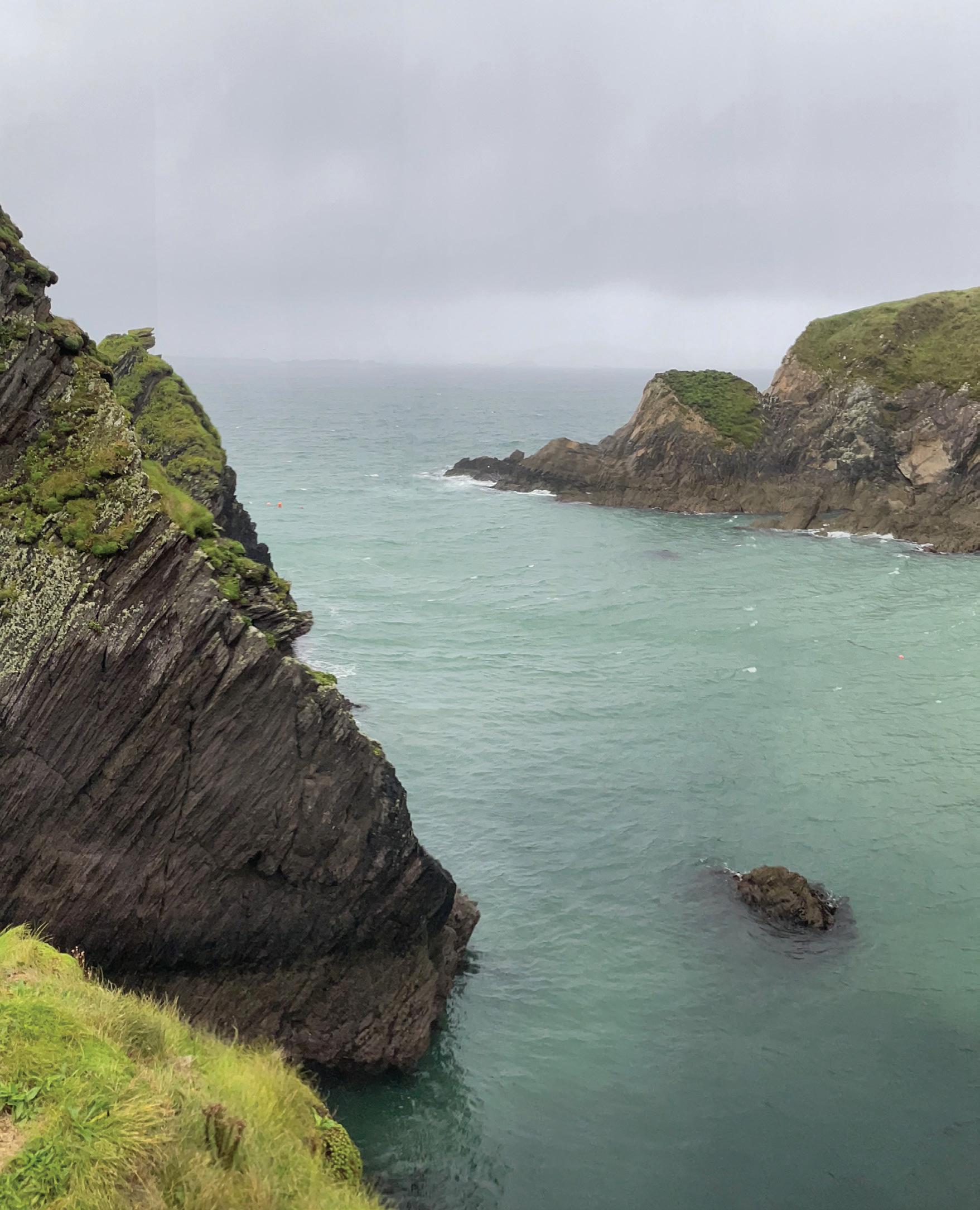 —KARA BUSSABARGER, WESTFIELD UNITED METHODIST CHURCH
—KARA BUSSABARGER, WESTFIELD UNITED METHODIST CHURCH
53
Advocating for Afghanistan
by Allie Northcutt
Ashraf Haidari ’01 came to Wabash as a political refugee. Having experienced years of horrors of his home country in conflict, he was determined to rise above and dreamed of making a global impact. Now, more than 20 years later, Haidari is fighting back against the same dark forces that plagued his childhood.
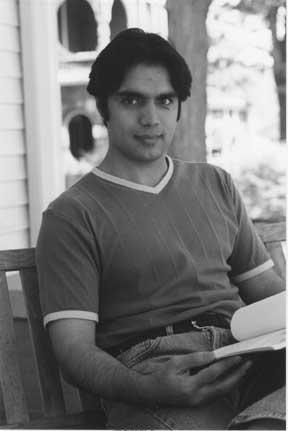
From a young age, Ashraf Haidari ’01 had a clear understanding that there would be “no promising future” for him if he chose to stay in Afghanistan. He knew pursuing education internationally would be key to a brighter future and potential change for himself, his family, and his home county.
“We did not get a proper education in Afghanistan,” explained Haidari, who came to Wabash in 1997. “We would sometimes go to school only two or three days a week, and sometimes the teachers wouldn’t show up.”
Haidari experienced unimaginable hardships firsthand both under the Soviet occupation in 1980s and the Taliban rule in 1990s.
He worked as a street vendor as a child growing up in Kabul, so his family could eat.
His family fled Kabul for Mazar-e Sharif in 1992, where Ashraf approached the United Nations High Commissioner for Refugees (UNHCR) officers for a job. For the next five years, Haidari held various field positions with UNHCR and the World Food Program in Afghanistan, serving internally displaced persons and refugees from Tajikistan.
It was through those jobs with UNHCR that Haidari honed his English skills and his complex road to higher education in the United States began.
“I so desperately wanted to get out,” says Haidari. “What mattered most was getting out of the instability, poverty, violence, and bleak future. I was hoping against hope.”
a year after Haidari left Mazar, the city was plunged into lawlessness when the Taliban returned to take over and massacred thousands of non-combatant members of the Hazara population. After witnessing their own neighbors systematically killed, his family fled from Afghanistan to Pakistan.
“Ashraf told me about his family fleeing the Taliban, and that he had not heard from them in over six months. He had no idea if they were living or dead,” remembers Professor Emerita of Political Science Melissa Butler H’85. “I was tremendously moved by what he had been living with through his first semester of college.”
There was no internet in Afghanistan. Email was not an option to stay in touch with family. The country had roughly 3,000 landlines, which had been destroyed, and there was only one central office of communications where people would wait for hours, only to get a minute or two to speak to someone abroad.
54 WABASH MAGAZINE
“I completely lost touch with my family for nearly two years,” Haidari says. “My friends who worked with the UNHCR would let me know when they saw my father here and there, or would go check on my family. That was the only kind of communication I had during my early years at Wabash.”
Thankfully, Haidari says, he was never truly left alone. Faculty members, his host family, and other friends he made in the Crawfordsville community would often check up on him and ask about his family and how he was coping.
“I did struggle to stay focused on my studies at times,” says Haidari, “but they made it all possible.”
He credits faculty, specifically Butler and Religion Professor David Blix ’70, for helping him persevere.
“Their empathy, support, and patience put me through tutoring. They caught me up to be at the same level as other students,” he says. “Because of them, I was able to exceed everyone’s expectations.”
butler recalls haidari ’s keen interest in the prospects for change in Afghanistan. He wrote his political science senior seminar paper on regional stability in South and Central Asia with an emphasis on Afghanistan. His international studies paper focused on what he learned studying abroad in Geneva, about Swiss armed neutrality as a model for Afghanistan.
“Ashraf is a good man of high moral character,” says Butler. “He is the kind of public servant that his country and the world badly needs in its leadership.”
Blix says he felt awestruck by the fact that Haidari had lived through horrors in Afghanistan and still came out of it with a “relatively cheerful spirit and selfless determination to right a country that had been wronged.”

He remembers instructing Haidari in class, specifically in Introduction to the Quran.
“Teaching about different religions around the world, sometimes I might have a Muslim or a Hindu in class, and I’m always wondering how my account of Islam matches up with what they are actually living,” says Blix. “Ashraf explained to me what he lived through. He believed it matched up with what I thought I understood and was teaching in the classroom.
“We had a lot of conversations about his home, and in a way, he was my teacher as well,” he says. “It was through him that I really became aware of the complicated situation in Afghanistan and what it was like to spend one’s childhood in refugee camps.”
in late 1998 , with the support of Wabash, Haidari applied for and was granted asylum.
“I applied for asylum because I couldn’t go back to Afghanistan,” he explains. “So, I focused on graduating from Wabash, working for two years until I got a Green Card (officially known as a Permanent Resident Card), and then getting a master’s degree. Maybe by the end of that, I could get a UN job focused on humanitarian assistance. That was my original plan.”
Ashraf Haidari ’01 at the 100th anniversary reception of Afghanistan’s Independence Day.
“We had a lot of conversations about his home, and in a way, he was my teacher as well. It was through him that I really became aware of the complicated situation in Afghanistan and what it was like to spend one’s childhood in refugee camps.”
WABASH.EDU 55
DAVID BLIX
Following his graduation from Wabash, Haidari earned a master’s degree in security studies from the Georgetown University Edmund A. Walsh School of Foreign Service in Washington, D.C.
Since then, he has worked as a fellow in foreign service at Georgetown University, served more than two terms at the Embassy of Afghanistan in the U.S., served as Afghanistan’s deputy chief of mission (minister counselor) to India, and as the director-general of policy and strategy of the Ministry of Foreign Affairs of Afghanistan.
haidari has served as the ambassador of Afghanistan to Sri Lanka since 2018, and concurrently serves as the rotating directorgeneral of the South Asia Cooperative Environment Program, a regional intergovernmental organization headquartered in Colombo.
Some of the key issues Haidari focuses on as ambassador have shifted, specifically after the Taliban returned to power in Afghanistan in 2021.
“I have focused on advocacy,” Haidari explains, “advocacy for human rights, especially women’s rights, and speaking up against and exposing the war crimes the Taliban continues to commit.”
In the months before they captured Kabul, the Taliban systematically destroyed local and state institutions, including health clinics and schools, and gutted these facilities of their female workers, Haidari explains.
“The Taliban has taken away all of these facilities that help maintain public health and help Afghans survive,” he says. “And
“A Wabash education, at its best, introduces students to the world and gives them a certain capacity to move comfortably and to not be intimidated by adversity or differences of culture,” says Blix. “Ashraf is a living testimonial.”
Haidari says his work as ambassador does put him at risk, and that he cannot go back to Afghanistan because he’s confident his name is “on the top of the head list.”
But that doesn’t stop him. Haidari says he won’t lose out on any opportunity to “resist, fight, and speak up” on behalf of his home even when others have publicly “fallen silent” out of fear of Taliban retaliation.
Haidari engages in political, defense, economic, commercial, academic, public, and cultural diplomacy as ambassador in order to build and deepen comprehensive bilateral ties between Afghanistan and Sri Lanka. He works closely with the leadership of the Sri Lankan government, including the president, prime minister, and foreign minister.

Additionally in this role, Haidari has enhanced the visibility of the Afghan Embassy in Colombo by working as a writer and TV and radio commentator on regional and international affairs. His work is consistently in notable national, regional and international publications.
this is getting worse as Afghanistan continues to be sanctioned internationally, as the Taliban imposes a complete gender apartheid. It is a nation unfortunately suffering, starving, dying, and completely cut off from the rest of the world.”
blix says haidari has been on his mind a lot recently, especially after he heard news that the Taliban had returned to Afghanistan. He admits to worrying about his former student, but is proud of his “huge amount of courage” and the work being selflessly put in to protect and save his country and its people.
“The reason I continue talking is because of the education I got from Wabash: what to do in situations like this, how to lead in situations like this, how to speak up for the values and rights of my nation,” says Haidari. “It’s an incomplete journey of achieving our democracy, which of course means freedom, liberty, and sustainable development.
“We have to react, resist, and fight against this, and convince our neighbors and the world that what is happening in Afghanistan matters. What’s happening in Afghanistan, much like the 1990s, has implications for the United States,” he explains. “We cannot just let a whole nation suffer under these medieval, ignorant, terrorist criminals that have taken a whole nation hostage. Liberation will be good for regional stability as well as the rest of the world.”
Haidari with Sri Lanken Foreign Minister Dinesh Gunawardena at the Bilateral Cooperation MOU Signing on April 7, 2021.
“ It is a nation unfortunately suffering, starving, dying, and completely cut off from the rest of the world.”
56 WABASH MAGAZINE
ASHRAF HAIDARI ’01
On the Move
by Allie Northcutt
before returning to campus in 1980 to serve as Wabash’s director of annual giving and then as director of alumni relations, Joe Smith ’51 called many places home.
From Algeria to Spain, and Colombia to Paraguay, the history major from Acton, Indiana, found himself living and working in some interesting—and sometimes dangerous—locations while serving as a United States diplomat in the foreign service for more than two decades.

Foreign service officers are key interlocutors with foreign governments, Smith explains. They are responsible for engaging with foreign citizens and leaders, and for informing and influencing U.S. foreign policy while working on issues surrounding the safety and security of American citizens wherever they may be stationed around the world.
“I always knew I wanted to be a diplomat growing up,” Smith says. “My parents belonged to a book club, and one of the books they read was called “ Diplomatically Speaking.” It was written by Lloyd Griscom, who was an American diplomat in Turkey, Persia, Japan, Brazil, and Italy in the early 1900s. He had a fabulous career. I was fascinated by his work, and this opportunity as a diplomat to travel around the world and represent our country.”
Smith’s international work, which began in 1957 with his first foreign service post in Algiers, Algeria, was extensive, and his responsibilities changed depending on where he was stationed at any given time. But most of his work as a diplomat involved writing detailed—and often confidential—reports for the U.S. Department of State.

His reports focused on issues ranging from oil exploration and military operations to terrorism and drug trafficking.
“When I told people I worked in the foreign service, sometimes they would say, ‘Oh, it sounds like you’re a spy.’ I was not a spy, although sometimes the jobs were similar,” Smith says with a chuckle. “We have different leadership. I was responsible for reporting to officials in the State Department and other associated departments. The CIA goes exclusively to their people.”
There were a number of challenges to this job, Smith recalls. Those included delays in communication with Washington as direct contact was not always accessible, personal safety and security, and the requirement of flexibility to leave one post and report to the next at any given time.
“If you had a job like mine, you’re on the clock 24 hours a day,” says Smith, “whether you liked it or not.”
What the Wabash alumnus found most rewarding about serving as a diplomat was the ability to travel and learn more about the world with his family by his side.
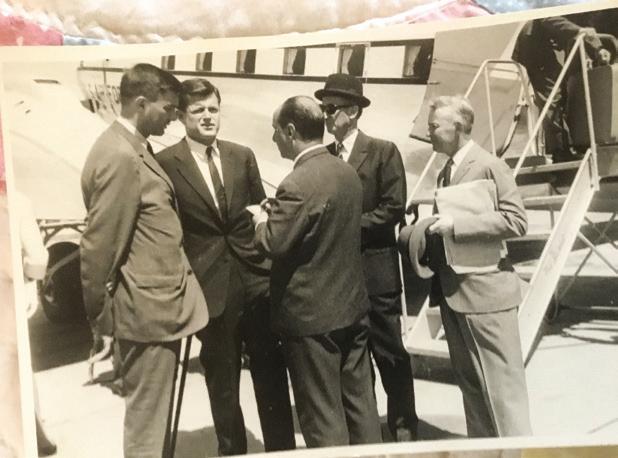

“I was never in a place where my family was not able to live and travel with me,” says Smith. “Working in foreign service offered me, my wife, and our four kids exposure to learning about and being a part of foreign cultures. People have different attitudes and ways of living. That lesson and exposure to the world was very good for my kids.”
As
From top to bottom:
the Smiths arrive in Asunción, Paraguay, in January 1973, they are met by Embassy personnel.
The Smith family in Buenos Aires in June 1973. Pictured left to right is Elizabeth (Lisa), Joe, James, Regina, Jessica, and Nicole. Smith served as a principal participant in 1971 in drafting a treaty between the U.S. and Spain that covered the use of military bases in Spain.
WABASH.EDU 57
Ted Kennedy spent a month in Spain in early 1965. Smith traveled with him and his wife, Joan, the entire time as his assistant.
1963
Ke Chiang “Johnny” Hsieh published his book, “Neutral-Atom Astromomy: Plasma Diagnostics from the Aurora to the Interstellar Medium.”
1968
Richard Stout was presented with the Presidential Award for Faculty Excellence by Knox College. Stout is professor of economics. In addition, Stout represented Wabash at the inauguration of Dr. C. Andrew McGadney as the 20th president of Knox College in May.
1975
Henry O’Connell was named a Top 50 Healthcare Technology CEOs of 2022 by the Healthcare Technology Report. O’Connell is the CEO of Canary Speech, a Provo, Utahbased company that develops technology to detect diseases and other conditions through human speech. The company’s product uses machine learning to diagnose and track conditions such as Alzheimer’s disease, Parkinson’s, PTSD, and depression.
1977
1986
Allen Yow has teamed up with the Morgan County (IL) Audubon Society to hold firefly festivals in his yard and to conduct firefly walks in the Jacksonville, IL, area.

1989
Joseph Turk joined the board for ReWalk Robotics Ltd. ReWalk is a leading manufacturer of robotic medical technology for people with lower extremity disabilities.
Ryan Tipps reunited with two fellow alums, Adam Cole ’98 and Daniel Sweet ’04, at a trail running event, Ragnar Relay. He writes, “We were three of the eight members of the team Uphill Both Ways. We camped for a couple of nights and alternated running trail loops, even throughout the night, at the event in West Virginia ”
2003
Mark Manchak is a deputy public defender in Hancock County. He lives in New Palestine, IN, with his wife and two daughters.
1971
Tom Runge writes, “In early July 2022, a small group of loyal Wabash Little Giants traveled to Alaska for a cruise up the Inside Passage. The group included: Emeritus Trustee Trey Holland ’71; Cheryl Holland, Trey’s spouse and keen adventurer; Sherry Ross H’04, Senior Administrative Assistant to the Dean of Students and Honorary Sphinx Club member; Gary Ross, spouse of Sherry and Honorary Sphinx Club member; Carol Runge, H’71; and Tom Runge ’71. The cruise was named The HoRoRu Expedition (Holland, Ross, Runge). The trip started in Vancouver, British Columbia, where the couples toured the city and experienced Canada Day. Some members rented bikes and rode around and through Stanley Park. The cruise included spectacular views with stops at Juneau (on July 4!), Ketchikan, and Skagway, giving the group a glimpse of Alaskan life old and new. Some of the experiences along the way included helicopter rides to a glacier (and the opportunity to walk the glacier), a zipline course, and several stops in Glacier Bay National Park. The travelers were astonished by the natural beauty of the state.”

John Kerezy represented Wabash at the inauguration of David Haney as the 23rd president of Hiram College in May. Robert Knowling Jr. joined CECO Environmental Corp.’s board of directors. CECO is a leading environmentally focused, diversified industrial company whose solutions protect people, the environment, and industrial equipment.
1978
John Sunde was re-elected to serve on the Julius Hartt Musical Foundation Inc ’s board of trustees.
1983
Brian Boone was named executive director at The Foundation for Sustainable Care in Noblesville, IN.
1984
Mike Kaster had to undergo a doublelung transplant in the fall of 2021. He finished his first 5K since the surgery in April of 2022.

1985
Five Wabash graduates were named to the Forbes list of BestIn-State Wealth Advisors, which recognizes advisors from national, regional, and independent firms. The list recognized Martin Gregor ’85, Mike McGinley ’93, Lou Fenoglio ’81, Leo Priemer ’06, and Keenan Blanchford ’98
1995
Adam Vela was promoted to vice president, general counsel of Coterra Energy Inc., an energy company engaged in hydrocarbon exploration organized in Delaware and based in Houston, TX.
1997
Brent Eaton was inducted into the Greenfield Central (IN) School Foundation’s Alumni Hall of Fame. Eaton has served as Hancock County’s prosecutor since 2015, and won the election in fall of 2022 to secure another term. Sun King Brewery, co-founded by Clay Robinson, opened up a new location in Sarasota, FL. In addition, Clay and Sun King Brewery won the Grand National Championship at the U.S. Open Beer Championship.
1998
Kristofer Monson was reappointed chief administrative law judge for the State Office of Administrative Hearings by Texas Governor Greg Abbott. His term expires in 2024.

2000
Jon Allen was named the new medical director for Cherokee County (GA) Fire and Emergency Services. Sokol Cano joined D.A. Davidson & Co., an employeeowned financial services firm, as a managing director to lead its paper and packaging practice. Chris and Jessica Short welcomed a baby girl, Charlotte Annmarie Short, born May 6. She was 8 lbs., 6 oz. and 21 ¼ inches long at birth. Ryan Vaughn has a new job as president and general counsel with Sondhi Solutions, an Indianapolis-based information technology firm.
2004
Jacob Pactor was appointed as principal at Purdue Polytechnic High School Schweitzer Center at Englewood. Trevor Hall joined the Spencer Fane LLP law firm in Houston, TX, as a counsel attorney. Noah Gambill secured the Democratic nomination for Vigo County (IN) Superior Court 1 Judge.
2006
Barry Tyler reports, “My wife and I welcomed twin boys, Barry III and Bryant, in December 2020. We moved into a new home in January, 2021, in Hammond, IN.”

2009
Andrew Todd is a sixth-grade teacher at Mary Castle Elementary School and won the Teacher of the Year Award for the Metropolitan School District of Lawrence Township. Charles Johnson secured the Republican nomination for Vigo County (IN) Superior Court 1 Judge in May of this year and defeated Noah Gambill ’04 in the fall. Johnson previously served as Deputy Prosecutor in the Vigo County Prosecutor’s Office handling criminal cases that deal with domestic violence. He has served previously as a Deputy Prosecutor in both the Terre Haute City Court and the Vigo County Juvenile Center.
2010
Shane Harmon joined Advanced Dental Concepts in Dyer, IN, as a dentist. Harmon started practicing after graduating from the IU School of Dentistry, spending almost eight years working out of a private practice in Michigan City. John Dewart announces the birth of his daughter, Katherine Grace Dewart, born November 17, 2021.
Class Notes | FALL 2022 58 WABASH MAGAZINE
2011
Andrew Forrester was hired as the new executive tourism director of Visit Madison Inc., the destination marketing and management organization for the City of Madison (IN) and Jefferson County area. Alex Moseman was appointed executive director of talent acquisition for Knox County (TN) Schools.
2012

Our condolences to Kyle Bender on the death of his father, Kevin Bender, on August 10, 2022.
2016
Cameron Dennis received his PhD in physics from the University of Oregon.
2017
The Indianapolis Chamber of Commerce promoted Adam Burtner to vice president of business advocacy and special projects. Aaron Wirthwein defended his physics PhD thesis, “Collision Dynamics of Bose Einstein Condensates: Computational-theoretic Exploration at the New Frontier of Cold Atom Physics in Space,” at the University of Southern California. He’s been working with a group at NASA’s Jet Propulsion Laboratory working on cold atomic physics aboard the International Space Station.
2018
Zach Rohrbach was named 2022 Avon (IN) High School Teacher of the Year. He is a science teacher at the school.

2014
Tyler Holmes was appointed assistant principal at Westerville Central (OH) High School. Andy Walsh writes, “Eleven years ago, Dr. Chris Carr ’82 walked into the football team meeting room during preseason camp at Wabash in my sophomore year to teach us some mental skills. After the meeting, I stayed behind to talk with Dr. Carr about what I needed to do to become a sport psychologist. That day I began a journey toward what I knew would be a marathon, and what I knew would require multiple graduate school stops. August 1, I finished that journey. Dr. Walsh, at your service. God is good.”
2015
Jacob Burnett graduated magna cum laude and Order of the Coif from the University of Pennsylvania Law School in May. He writes, “I will be starting my legal career as an associate at Williams & Connolly in Washington, D.C.”
Brient Hicks joined Barnes & Thornburg as an attorney in the firm’s Indianapolis office. Cory Sims announces the birth of his daughter, Peri Ann Sims.
2019
Jacques Boulais accepted a position as a teaching assistant in Albi, France, with the Académie de Toulouse for the 2022–23 school year.

2021
Canton Terry joined Danville (IN) Community School Corporation as a seventh- and eighth-grade science teacher.
WABASH.EDU 59
photo by Becky Wendt
1947
Kenneth Nels Larsen, 96, died July 20, 2022, in Savannah, GA.
Born August 8, 1925, in Oak Park, IL, he was the son of Violet and Nels Larsen.
He joined the U.S. Navy and served in the Pacific during World War II.
While attending Wabash, he was a member of the V-12 Program and Phi Delta Theta. He graduated from the University of Illinois with his bachelor’s and master’s degrees.
Larsen had a career as a senior executive in the antibiotic research and product management divisions of multiple brand-name and generic pharmaceutical development companies. Larsen was instrumental in his leadership of Parke-Davis/Warner-Lambert and, ultimately, the generic drug market. Larsen was actively involved in the development and passage of legislation opening the generic product competition while providing patent protection for these new drugs. Larsen also brought his many talents to focus on the nonprofitable “orphan” drugs and was twice recognized by the National Organization for Rare Disorders.
He is survived by his wife, Nancy; children, Chris, Karin, Eric, Ann, and Jane; six grandchildren, including Heikki Larsen ’97; and 10 great-grandchildren.
1948
William M. Ebert, 96, died September 9, 2022, in Washington, IL.
Born August 9, 1926, in Peoria, IL, he was the son of Wilma and Forrest Ebert. While attending Wabash, he was a member of Lambda Chi Alpha.
Ebert was a graduate of the University of Illinois with degrees in civil engineering and naval science. For 48 years, he was a self-employed water-well contractor for M. Ebert Co., a business his grandfather founded in 1888.
He served two years in the Navy V-12 program and was commissioned Ensign CEC USNR in 1948. He was the commanding officer of the Navy Reserve CB DIV 9-3 in Peoria for many years, then
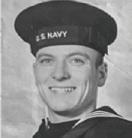
the Reserve Training Center public works officer, retiring as lieutenant commander in 1964.
He is survived by his wife, Winnie; daughters, Elizabeth and Ellen; five grandchildren; and four great-grandchildren.
Bennett E. Sickler, 96, died May 17, 2021, in Town and Country, MO.
Born January 6, 1925, he was the son of Josie and Edward Sickler.
While at Wabash, Sickler was a member of the V-12 Program and Sigma Chi.
Sickler joined the U.S. Navy in 1942 and during World War II served sea duty in the Pacific. After the war, he completed college at University of Illinois and was employed by Mississippi Valley Structural Steel as the director of materials for 34 years.
Sickler was preceded in death by his wife, Dorothy; and son, John.
He is survived by his children, James and Karen.
1949
Warren Edward Johnson, 94, died June 1, 2022, in Salem, OR.
Born July 2, 1927, in Gary, IN, he was the son of Mabel and Elmer Johnson.
He graduated from Emerson High School in 1945. While attending Wabash, he was a member of the Speakers Bureau and Lambda Chi Alpha.
Johnson was awarded a master’s degree at Northwestern University in 1950.
His first job was an audiologist for the Constance Brown Society for Better Hearing in Kalamazoo, MI. In 1952, Johnson moved to the Cincinnati Speech and Hearing Center, becoming acting director and director, serving until September 1958.
Johnson accepted the position of director of the Portland Center for Hearing & Speech and served as director until 1984. He completed graduate work at the University of Oregon and was granted a PhD in audiology in 1970.
In the mid 1980s, Johnson moved to Beverly Beach, OR, where he became director of Food Share of Lincoln County.
He is survived by his wife, Linda; children, Mark, Bruce, and Barbara; six grandchildren; and three great-grandchildren.
1950
Victor H. Mercer, 93, died April 21, 2022, in Fishers, IN.
Mercer attended Shortridge High School. While attending Wabash, he was a member of the Glee Club and Phi Delta Theta.
Mercer received his DDS, and MSD degrees from Indiana University.
After graduation, he served in active duty with the U.S. Navy and U.S. Marine Corps for two years. Mercer was stationed in Korea where he was a dental officer with the 1st Marine Air Division.
Mercer served for 35 years on the part-time faculty of the Indiana University School of Dentistry and retired as a full professor. In addition to several years of private practice, he served on the staff of the Indiana State Board of Health and retired as the Indiana State Dental Director. Mercer was awarded recognition for his contribution nationally to preventing dental disease by the Centers for Disease Control in Atlanta and the State Dental Directors Association.
Upon his retirement, he was recognized by the Indiana Dental Association for developing dental office infection control procedures and the use of universal infection control practice for use by dentists.
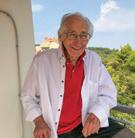
He was awarded the prestigious title of Honor Dentist of the Year (2009) by the Indianapolis District Dental Society and Indiana Dental Association.
Mercer was preceded in death by his first wife, Carolyn.
He is survived by his wife, Beatrice; son, Victor; three grandsons; two great-grandchildren, and a greatgreat granddaughter.
D. Dean Peel, 95, died August 12, 2022, in Sun City West, AZ.
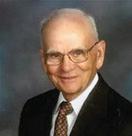
Born November 26, 1926, in Decatur, IL, he was the son of Leonra and Forrest Peel.
Peel graduated from Decatur High School and enlisted in the U.S. Navy during World War II. Upon his return, Peel attended and graduated from Wabash, where he was a member of the Glee Club and was an independent.
His career in consumer hardware and marketing began at Black’s Hardware in Springfield, IL, took a stop at WEN Products in Park Ridge, IL, and concluded as
senior vice president of Dremel Manufacturing. Peel served as president of the National Hardware Association and later president of the Hardware Marketing Council.
Peel sang with the Westernaires and numerous vocal groups, including the Crown of Life choir. Peel was preceded in death by his wife, Alice.
He is survived by his children, Bill, Kathleen, Tom, Sue, and Steve; eight grandchildren; and 10 great-grandchildren.
1952
Norman A. Buktenica, 92, died June 10, 2022, in Palm Desert, CA

Born May 27, 1930, in Chicago, IL, he was the son of Theresa and August Buktenica. Buktenica attended Chicago Vocational High School. An athlete in both football and baseball, he was recruited by several Big Ten universities. Buktenica decided the school for him was Wabash. While attending Wabash, he served as president of the Senior Council and as a member of the W Men’s Club, Blue Key, and the Sphinx Club. He was inducted into the Wabash Athletics Hall of Fame in 2010.
The U.S. Army drafted him in 1953 and he was stationed on Okinawa upon discharge.
Buktenica returned to Roosevelt University to obtain his master’s degree. He was awarded a full scholarship to University of Chicago, where he earned his PhD. He co-authored the BerryBuktenica Developmental Test of Visual-Motor Integration.
He married Dena Jaffe, the mother of his two daughters, Julie and Laurie. His second wife, Marsha Kierscht, the mother of two step-children, Cynthia and Matt. His third wife, Alea, who preceded him in death, was the mother of step-children, Jack, Kelly, Dave, Julie, and Patrick Norman. Finally, Jonne was mother of Cynthia. He has 20 grandchildren; and six greatgrandchildren.
60 WABASH MAGAZINE In Memory | FALL 2022
John Robert
Poncher, 91, died July 11, 2022, in Valparaiso IN.
Born September 13, 1930, in Chicago, IL, he was the son of Gretchen and Henry Poncher.
While attending Wabash, he was a member of Phi Delta Theta. Poncher enlisted in the U.S. Navy to serve during the Korean conflict aboard a P2V Neptune aircraft as a radar operator.
He received his degree at Valparaiso University and attended Indiana University Medical School.
Poncher completed an internship in Evansville, IN, and a residency at Chicago Children’s Memorial Hospital where he received his medical training as a pediatrician.
Moving back to Valparaiso to begin medical practice, Poncher founded Associated Pediatricians in 1969 and expanded the practice until his retirement in 2002.

After retirement, Poncher continued to practice medicine by volunteering at HealthLinc Clinic in Valparaiso and Lurie Children’s Hospital in Chicago.
Poncher was recognized as Indiana Physician of the Year in 1976 and later received the John C. Cook award from the Chicago Pediatric Society in 1999.

He is survived by his wife, Gwen; children, John, Susan, Julia, and Jane; and six grandchildren.
1953
Robert Noel Woods, 91, died July 18, 2022, in Smithfield, VA.
Born March 11, 1931, in Decatur, IL, he was the son of Leone and Robert Woods.
While attending Wabash, he was a member of the track team and Delta Tau Delta and sports editor of the yearbook.
Woods took a job with Sangamo Electric as their quality control engineer in 1956. Woods transferred with Sangamo to Easley, SC, within their electrical meter production section. Woods moved to Blacksburg, VA, as quality control director for Poly Scientific in 1968.
He retired as vice president of manufacturing at Poly Scientific in April 1995.
Woods was preceded in death by his first wife, Nancy; and daughter, Katherine.
He is survived by his wife, Betty; sons, Phillip, Robert, and Steven; seven grandchildren; and eight great-grandchildren.
1954
W. James Cronin, 88, died June 7, 2020, in Rochester Hills, MI.



While attending Wabash, he was a member of the Sphinx Club and Phi Delta Epsilon.
He spent his career working for The Budd Company as vice president of purchasing.
Cronin was preceded in death by his wife, Georgene.
He is survived by his children, Tim and Tracy; and six grandchildren.
William John Graham Jr., 90, died July 8, 2022, in Manalapan, FL.
Born May 23, 1932, he was the son of Edith and William Graham.
While attending Wabash, he was a member of Lambda Chi Alpha.
Graham continued his studies at Wharton College of Business. He served in the U.S. Army, where he worked in the Pentagon.
He is survived by his children, Kim, Kelly, Mark, William, Chris, and Carter; 16 grandchildren; and 10 great-grandchildren.
George Guthrie died October 2021 in Santa Fe, NM.
While attending Wabash, he was a member of Sigma Chi. Guthrie was professor emeritus at Indiana University School of Medicine.
He was preceded in death by his brother, William ’61
He is survived by his wife, Catherine; son, George; and brother Joseph ’64
William Charles Tait, 90, died September 13, 2022, in Venice, FL.
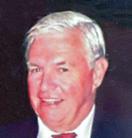
Born February 9, 1932, in Waterloo, IA, he was the son of Helen and Orren Tait.
While attending Wabash, he was a member of the Sphinx Club, track team, and Sigma Chi. Tait graduated cum laude and Phi Beta Kappa.
Tait studied at Cornell University graduating in 1958 with a master’s degree in mathematics.
Tait taught at Wabash until 1961. He studied and earned his PhD in physics from Purdue University in 1962.
Tait moved to Minnesota in 1962 and took a job with 3M. While at 3M, Tait produced 15 patents for the 3M company. He retired from 3M after 31 years.
Tait was preceded in death by his wife, Adele.
He is survived by his wife, Jeanne; children, William Jr., Susan, Sam, and George; nine grandchildren; and 10 greatgrandchildren.
1955
Durland H. “Mike”
Patterson Jr., 88, died August 1, 2022, in Plainfield, IN.
Born September 25, 1933, in Lafayette, IN, he was the son of Mary and Durland Patterson Sr.
Patterson graduated from Lafayette Jefferson High School. While attending Wabash, he was a member of the Glee Club and Kappa Sigma. He received his master’s degree from Purdue University.
Patterson retired from the Indiana State Board of Health after 30 years. He was awarded the very distinguished Sagamore of the Wabash Award.
He was the music director at his church, a member of the NavyBlue Jacket Choir, involved in the Symphonic Choir and Indianapolis Arts, Castlewood Chamber Singers, several barber shop quartets, Harmony Opera Club, and on the board of directors for the Indianapolis Symphonic Choir.
Patterson was preceded in death by his son, Scott; and a grandson. He is survived by his wife, Sallylou; sons, Jerry, Bob, Brian, and Tim; 10 grandchildren, 10 great-grandchildren.
Clifford “Cliff” Paddack Wagner, 89, died August 30, 2022, in Cincinnati, OH.

Born July 25, 1933, in Cincinnati, he graduated from Hughes High School. While attending Wabash, he was a member of Sigma Chi.
He served in U.S. Marine Corps and then joined the family business, Wagner and Son’s
Bottling Company in Cincinnati. He and partner, Paul Gosiger, acquired and developed the local independent insurance agency, Emory P. Zimmer Insurance Company, from which he ultimately retired.
Wagner was preceded in death by his parents; and wife, Patricia. He is survived by his wife, Anne; children, Chip, Chase, and Sarah; eight grandchildren; and one great grandchild.
1956
William A. Lovett, 87, died May 17, 2022, in New Orleans, LA.
Born September 2, 1934, in Milwaukee, WI, he was the son of Mary and Kenneth Lovett ’26 While attending Wabash, he wrote for The Bachelor, performed in Scarlet Masque, and was a member of Phi Kappa Psi. He received second place in the Baldwin Oratorical. He earned his law degree from New York University Law School, master’s degree from Harvard University, and PhD from Michigan State University.
Lovett served as an attorney in the antitrust division of the United States Department of Justice and as an economist at the Federal Trade Commission.
Lovett and his family moved to New Orleans, where he began his career at Tulane Law School in 1969. He was quickly promoted to full professor and eventually held the Joseph Merrick Jones Chair at Tulane. During his career at Tulane, Lovett published many articles and books. He testified on multiple occasions before House and Senate committees in the United States Congress. One of his books, “Banking and Financial Institutions Law in a Nutshell,” ran through nine editions and was translated into Chinese.
He retired in 2008, but continued to teach at least one course a year until 2016. On May 13, 2022, Lovett was inducted into the Tulane Law School Hall of Fame.
He is survived by his wife, Claire; children, John and Leslie; and three grandchildren.
WABASH.EDU 61
Robert Allen Webster, 86, died May 13, 2022, in Mt. Vernon, IN.
Born October 9, 1934, in Posey County, IN, he was the son of Ona and Jack Webster.
Webster was a 1953 graduate of Mt. Vernon High School. While attending Wabash, he was an independent.
He worked for Division of Family and Children for 42 years, and retired as director in 2003.
Webster was preceded in death by his son, Greg.
He is survived by his wife, Suzanne; children, Michael, Diane, Mary, John, Robert, Kristopher, Lesa, and Sara; seven grandchildren; and three great-grandchildren.
1957
Thomas Mabley III, 89, died August 12, 2022, in Hudson, NY.
Born in Newton, KS, he graduated from Episcopal High School in Alexandria, VA. Mabley attended the University of Pennsylvania where he was a member of the St. Elmo’s fraternity and later graduated from Wabash. While attending Wabash, he was an independent.
Mabley moved to New York City to pursue a career in advertising at J. Walter Thompson. Mabley is most remembered for his work on the U.S. Marines recruitment campaigns, “The Few. The Proud. The Marines,” and “The Marines are Looking for a Few Good Men.”
Mabley was the creative mind at Lord, Geller, Federico, Einstein, behind the well-regarded campaign for IBM’s first home computer featuring the iconic Little Tramp character played by Charlie Chaplin and the tagline, “A Tool for Modern Times.” Mabley also ran his own shop, Doyle Graf Mabley, and finished his career at Foote Cone & Belding in Philadelphia, PA.
He is survived by his wife, Geraldine; daughters, Winifred and Jennifer; and four grandchildren.
John R. White, 87, died May 18, 2022, in Fort Myers, FL.
Born February 11, 1935, he was a member of Phi Gamma Delta, while attending Wabash. White was retired from Union Carbide Corporation.

He is survived by his wife, Patricia.
1958
George Duane Badgero, 86 died July 26, 2021, in Granger, IN.
Born June 23, 1935, in Mt. Pleasant, MI, he was the son of Flossie and Robert Badgero. While attending Wabash, he was an independent.
He was employed as a supervisor at NIPSCO in South Bend, IN, before retiring. Badgero was preceded in death by his wife, Nancy.
He is survived by his children, Dane, Kirk, and Rochelle; eight grandchildren, and 19 great grandchildren.
Samuel Houston Gore, 86, died September 11, 2022, in Suwanee, GA.
Born June 23, 1936, in Tulsa, OK, he graduated from Owensboro High School. While at Wabash, he was a member of Sigma Chi.
Gore served two years in the U.S. Army, and graduated from the University of Illinois.
He went to work in the field of publishing with Prentice Hall and later worked for Random House and Harcourt Brace before retiring.
Gore was preceded in death by his wife, Ruth.
He is survived by his daughters, Darci and Stacy; and four grandchildren.
Gerald K. Shortz, 86, died October 11, 2022 in Manalapan, FL.
Born October 6, 1936, in Indianapolis. While at Wabash, he was a member of Sigma Chi.
He received his Doctor of Medicine from Northwestern University in 1962 and was a U.S. Air Force medical officer (captain) and flight surgeon from 1963 to 1965.
Shortz was in private practice in Delray Beach as a board-certified orthopedic surgeon.
Shortz was heavily involved in the Manalapan community. He served as town commissioner from 1978 to 1982, vice-mayor from 1982 to 1988, mayor from 1988 to 2002, served as chair of the zoning commission from 2003 to 2007 and served as vice-chair from 2010 to 2014.
He is survived by his children, Steven and Bretton; two granddaughters; and girlfriend, Kathleen Poole.

1959
Quinn E. Benson, 85, died June 21, 2022, in Kalamazoo, MI.
Born January 17, 1937, in Marinette, WI, he was the son of Lucille and Earl Benson.
While attending Wabash, he was a member of the basketball and tennis teams, and Phi Gamma Delta.
He graduated from the University of Chicago Law School in 1963. He was an attorney in Kalamazoo, MI, for 25 years and was appointed 9th District Judge by Michigan Governor James Blanchard in 1989.
He served as Kalamazoo County 9th District Judge from 1989 to 2008.
He is survived by his wife, Penny; children, Matthew, Stephen, and Sarah; five grandchildren, and one great-grandson.
Walter Ernest Inman, 85, died October 10, 2022, in Orange Park, FL.
While attending Wabash, he was a member of the Sphinx Club and Sigma Chi.
Inman was retired from the U.S. Navy.
He is survived by his wife, Anna; and children, John and Steven.
Edward R. Johnson died February 5, 2022, in Dallas, TX.
Born April 23, 1938, he was a member of Sigma Chi, while attending Wabash. He graduated Phi Beta Kappa.
Johnson was a former employee of the University of Texas Southwestern.
He is survived by his wife, Lizbeth.
Robert F. Oakerson, 84, died October 29, 2021, in New Palestine, IN.
Oakerson was born in Knightstown, IN, the son of Mary and Philip Oakerson.
He graduated from Knightstown High School in 1955. While attending Wabash, he was a
member of Phi Kappa Psi.
He received his master’s degree from Ball State University's Teachers College and taught 37 years at Woodview and Creston Junior High Schools before retiring.
Oakerson was preceded in death by his first wife, Dee, in 1993; second wife, Patricia, in 2019; and daughter Rachel, in 2016.
He is survived by his daughters, Marsha, Michelle, Kathleen, and Ada; and several granddaughters and great-grandchildren.
George E. Trout, 84, died June 2, 2022, in Washington, PA.
Born December 1, 1937, in Fredericktown, PA, he was the son of Mary and Raymond Trout.
Trout was a graduate of East Bethlehem High School. While attending Wabash, he was a member of the football and baseball teams and was an independent.
He worked for more than 20 years at RCA Meadowlands and later became a senior leader at various manufacturing companies in the Washington, D.C., metro area before retiring.
Trout was preceded in death by his wife, Marcy.
He is survived by his sons, Raymond and David.
1960
Charles R. Aubuchon died November 2020, in Redwood City, CA.

Born November 24, 1932, he was a member of Lambda Chi Alpha, while attending Wabash.
He is survived by his son, Mark.
1961
Harry Bernard Meyers, 83, died August 20, 2022, in West Lafayette, IN.

Born January 26, 1939, in Hartford City, IN, he was the son of Ruth and Harry Meyers. While attending Wabash, he was a member of Lambda Chi Alpha. He received his degree from Ball State University in 1963.
After completing his education, Meyers served in the U.S. Army Reserves, in the intelligence unit. Meyers worked for Purdue University as an accountant and also helped incoming international students around the university. He is survived by his wife, Suzanne; sons, Harry and Tom; six grandchildren; and a great-grandson.
1956 (continued)
62 WABASH MAGAZINE In Memory | continued
Mabley is most remembered for his work on the U.S. Marines recruitment campaigns, “The Few. The Proud. The Marines,” and “The Marines are Looking for a Few Good Men.”
1962
Robert Glen Deamer, 82, died July 18, 2022, in South Bend, IN.
Born June 17, 1940, in Rochester, IN, he was the son of Doris and George Deamer.
Deamer graduated from Talma (IN) High School. While attending Wabash, he was an independent. Deamer received his master’s degree in English from Indiana University.
After teaching at Alpena Community College in Michigan, and the University of WisconsinLaCrosse, Deamer returned to graduate studies at the University of New Mexico. He completed a PhD in American studies and resumed teaching at Thiel College.
Eventually he joined his parents at the family business, Deamer and Deamer, a real estate and title insurance business in Rochester, IN, having obtained a real estate broker’s license.
Deamer was preceded in death by his brother, Philip ’67.
He is survived by his wife, Eleny, and son, Eric.
Thomas Korff
Gaisser, 81, died February 20, 2022, in Swarthmore, PA.
Born March 12, 1940, in Evansville, IN. While attending Wabash, he wrote for The Bachelor and was a member of Phi Gamma Delta. He graduated Phi Beta Kappa.
He went on to earn a master’s in physics at the University of Bristol.
Gaisser started his career as a theoretical particle physicist after obtaining a PhD from Brown University in 1967. Following postdoctoral positions at MIT and Cambridge University, he joined the Bartol Research Foundation, where he made the transition to cosmic-ray physics.
He was named Martin A. Pomerantz Professor Emeritus of Physics at the University of Delaware. Gaisser helped prepare the theoretical groundwork for the physics of extensive cosmic-ray air showers. Inspired by the first data from the Irvine-Michigan-Brookhaven and Kamioka experiments in the 1990s, Gaisser also laid the theoretical foundations for interpreting the physics of the atmospheric neutrino beam. His
continued work on the subject, including his highly cited 1989 Physical Review D paper “Flux of atmospheric neutrinos,” led to the successes of the present generation of atmospheric neutrino experiments.
Gaisser provided early calculations of the antiproton flux in the atmosphere, which is relevant for the search for new physics. He also predicted early gamma-ray and astrophysical neutrino fluxes. Among his other achievements was helping to develop the Sibyll simulation of cosmic-ray hadronic interactions.
Gaisser is known for his book, “Cosmic Rays and Particle Physic s,” based on a one-semester course that he taught while on sabbatical at the University of WisconsinMadison and published in 1990. Gaisser updated and expanded it for a second edition, released in 2016.
Denmark, Turkey, and Norway, and director, Office of Press and Public Diplomacy, Bureau of European and Eurasian Affairs, Department of State, in Washington, DC.
Arnett was a career member of the senior Foreign Service with the rank of minister counselor. He retired in 2005 after serving as the Consul General in Istanbul, Turkey. While in Istanbul, Arnett supervised removal from the consulate building, once occupied by Lew Wallace (U.S. minister to the Ottoman Empire, 1881–85) to a modern, safer site. He also once briefed a visiting group of Wabash students about his work and life as an American diplomat.
Arnett moved to Sedona, where he started a new career as writer and poet. He published two novels, contributed to magazines, and placed his poetry in specialized journals. For years he wrote a column for the Sedona Monthly Magazine


Arnett was preceded in death by his daughter, Heather.
He is survived by his wife, Vivi; brother, Earl ’62; and two granddaughters.
Gilbert Allan
Sartore, 79, died October 11, 2022, in Evansville, IN.
Born January 6, 1943, in Evansville, he was the son of Mary Louise and Gilbert Sartore. He graduated from Memorial High School in 1961. While at Wabash, he was member of Beta Theta Pi.
He graduated from Evansville College and Indiana University School of Medicine.
Sartore completed his internship at St. Mary’s Medical Center in 1971. Sartore worked for Volunteers in Service to America in Marianna, AR, for a year. He provided hands on medical care for the underprivileged in Lee County, AR.
He returned to his hometown where he completed a residency in OB/GYN. Afterward, Sartore went into family practice and served in practice for 39 years.
He is survived by his wife, Jacqueline; children, John, Mary, Aimee, Megan, Sarah, Kristin and Emily; and 15 grandchildren.
1966
He was a founder of the IceCube Neutrino Observatory collaboration, which began construction in fall 2004. For several years he traveled to Antarctica, staying there for weeks at a time to participate in building the surface array. In recognition of his work with IceCube, an area in Antarctica was named Gaisser Valley in 2005.


He is survived by his wife, Julia; son, Thomas; and two grandchildren.
1965
David Leslie Arnett, 78, died May 22, 2022, in Sedona, AZ.
Born November 7, 1943, in Muncie, IN, he was the son of Eleanor and Clyde Arnett ’38 He graduated from Crawfordsville High School. While attending Wabash, he was a member of Beta Theta Pi.
He spent four years in the U.S. Army with service in Azores and Vietnam. Arnett received his PhD in English from Tulane University in 1973 and entered the Foreign Service in 1974.
His Foreign Service career included tours in Germany,
John Kent Holt, 78, died August 4, 2022, in Carbondale, IL.
Born September 21, 1943, at Scott Air Force Base, he spent his childhood in Springfield, Marion, and Centralia, IL. While attending Wabash, he was an independent.
He attended Southern Illinois University and served in Vietnam from 1965 to 1966.
Holt was an active volunteer at Synergy, a long-time member and elder of the First Presbyterian Church of Carbondale, a member of the Rotary Club for many years, and a committed member of several area support groups.
Holt loved hanging at the Whiteside Bluegrass Festival and was deeply knowledgeable across blues, bluegrass, and classical genres.
He is survived by his wife, Pam; children, Philip, Cassy, Dion, Vanessa, and Colleen; 12 grandchildren; and three greatgrandchildren.
Robert C. Anderson, 77, died April 21, 2022, in Cincinnati, OH.

Born October 16, 1944, he was a member of Phi Gamma Delta, while attending Wabash.
He is survived by his wife, Judy; three sons; and five grandchildren.
Rolfe Newton Coons, 77, died June 21, 2022, in Lebanon, IN. Born November 9, 1944, in Lebanon, he was the son of Norma and Robert Coons.
Coons graduated from Lebanon High School. While attending Wabash, he was a member of Sigma Chi.
He was one of the first National Teacher Corps members, teaching at Harry E. Wood Middle School in Indianapolis, in the late 60s.
Coons went on to be treasurer and vice-president of the Empire Wood Company in Bloomington, IN, and paralegal and special investigator for Achrem Associates in Las Vegas.
He is survived by his children, Heather, Sariah, Thor, Nina, Lacia, Serene, Aluna, Rod, Glory, Nova, Princess, Precious, Josiah, Zephyr, and Uno; foster son, Brian; 32 grandchildren; and two greatgrandchildren.
WABASH.EDU 63
In recognition of his work with IceCube, an area in Antarctica was named Gaisser Valley in 2005.
buildings we go in every day on campus often started as private family residences. Wabash’s campus is dotted with these homes. Each carries memories and histories of the families that grew up within them. Caleb Mills House, Hovey Cottage, Kane House, Hays Alumni Center, the International Office, Arnold House, Bill and Ginny Hays House, and the Stephenson Institute for Classical Liberalism were all once private homes filled with the love and laughter of families.
HOVEY COTTAGE
by Nolan Eller ’11
Many pass by Hovey Cottage on a regular basis without thinking of the significance it holds to Wabash College. Today it is the office of marketing and communications and home of Wabash Magazine
Hovey Cottage was built by Edmund O. and Mary Carter Hovey between 1836 and 1837. In a letter to his brother, Israel Dewey, on December 6, 1837, Edmund described his new home in great detail.


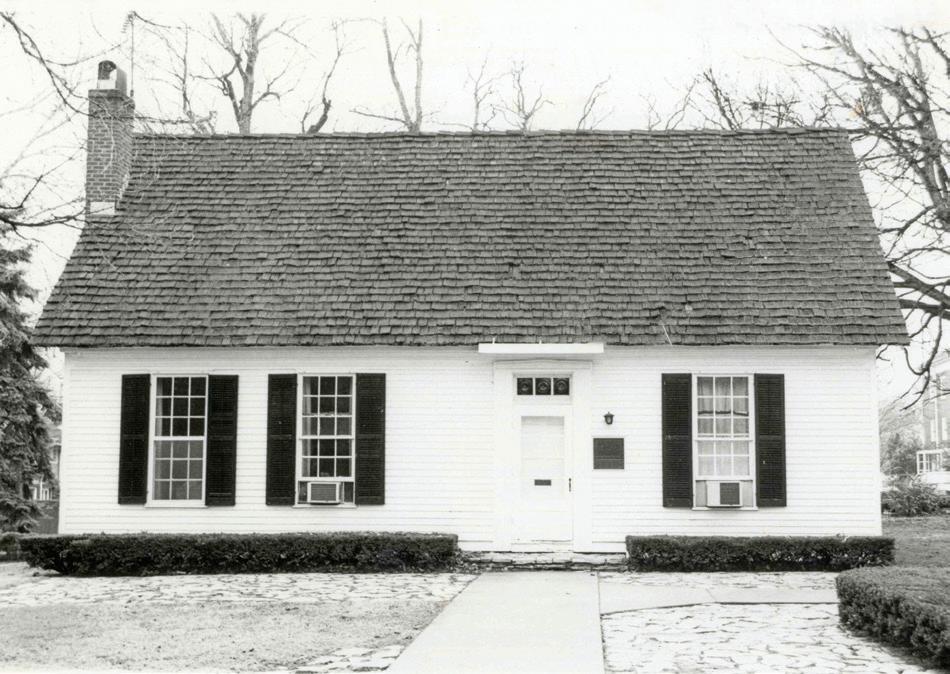
“We have now been in our house about four weeks. It is a one-story house, 40 feet by 20, with a kitchen… It lies about ¼ mile from the village, and perhaps 50 rods from the site of the college. It is a high and I hope healthy location, commanding pleasant view of town and of the college grounds… the college campus on the east beyond the village. On the south is Prof. Mills’ house at the distance of 13 rods.”
Hovey Cottage still sits on this plot of land, though it has been moved a little to the south of its original location. A rock now sits where it once stood. The Hovey family only had funds at the time to furnish two of the rooms of their new home. It would not be completely furnished until 1840 with the assistance of Mr. and Mrs. Israel Williams, who rented and finished the extra rooms. When the Hoveys moved into the new home,
they brought their young son Horace, who would be joined by his sister Mary Freeman in 1838. This modest home was filled with the passions of its owners and grew not only with the family that called it home, but with the College itself.
The Hovey home was always bursting with people coming and going through its doors. In a manuscript written by Nora Hopkins, she noted that every place in the house and at the table was kept full. The Hoveys not only lived in the home but also boarded students and travelers to the College. Some of the first student boarders were Thomas S. Milligan [W1839] and Samuel S. Steele [W1839]. The Hovey home also became the foundation of the Wabash College band, which was formed with the assistance of Edmund
64 WABASH MAGAZINE From the Archives | FALL 2022
Edmund O. Hovey, a founder and the first professor of the sciences at Wabash.
Hovey in 1841. The first instruments for the band were purchased by Hovey in New York and shipped back to the College with other dry goods. The instruments were stored in the attic of the Hovey Cottage during vacations and breaks. During this time, Horace Hovey would venture to the attic and try out all the instruments, igniting a passion for music he would possess his entire life.

Mary Carter Hovey was a passionate gardener, and her home was surrounded by different plants and gardens, beautifying the Hovey home and Wabash College. She writes in a letter to her sister on May 4, 1846: “I assure you a change has passed over us and though we have no snow we have tons of snow-balls, and lilacs and roses, our tulip is now in bloom. If you find any one that has tulip bulbs to give away or to sell pray bring me up some when you come. It is just four weeks since we had our first pie-plant pie, and we have had them quite often since. We have had plenty of asparagus and our currants are almost fit to use.”
Hovey Cottage, at its core, was the home of Edmund, Mary, Horace, and Mary Freeman Hovey. The two children grew surrounded by the love and admiration of their parents and the College community that surrounded them. Horace graduated from Wabash in 1853 and followed his father into the priesthood, attending Lane Theological Seminary. He also carried on his parents’ passion for nature, documenting and exploring many of the cave systems of Indiana and the United States. Mary Freeman followed her father into education, becoming the first documented female instructor at the College at the close of the Civil War. She would go on to teach at Kansas State Agricultural College, now Kansas State University. After teaching for a few years, she returned to Crawfordsville
to be with her parents. While caring for her aging parents, she continued to teach by tutoring the children of faculty and staff.
Hovey Cottage may appear to be a modest and straightforward building, but it is one with a complex story that is integral to the founding and success of Wabash. It has remained a constant on campus and will hopefully continue to be well into the future.
For more information about the Hoveys and the Robert T. Ramsay Jr. Archival Center collections, please visit https://library.wabash.edu/home/ collections to view our digitized collections and online resources. Please also follow us on Instagram @wallysattic for weekly posts showcasing the history of Wabash College!
The letter Edmund O. Hovey sent his brother, Israel Dewey, detailing the new home.
WABASH.EDU 65
The Hovey home also became the foundation of the Wabash College band, which was formed with the assistance of Edmund Hovey in 1841.
Alfred R. Nucci, 78, died November 12, 2021, in St. Joseph, MI.
Born November 26, 1943, he was an independent, while attending Wabash.
He was retired from the U.S. Government Census Bureau.
Joseph James Sedmak, 77, died September 25, 2022, in Fort Collins, CO.
Born September 30, 1944, in Canonsburg, PA, he was the son of Victoria and Joseph Sedmak. While attending Wabash, he was a member of the cross-country team and Sigma Chi.
He received his PhD in microbiology from Indiana University. Sedmak taught at the Medical College of Wisconsin as the Associate Professor of Microbiology for 17 years. Sedmak also worked at Universal Foods, now Sensient Technologies as a research scientist for 23 years. In 1998, the flavors division moved him to Indianapolis.
He is survived by his wife, Barbara; his children, Michael and Stephen; two grandchildren; twin brother, Gerald ’66, and brother, Jacob ’68
Frank David Starkey, 77, died January 3, 2022, in South Orange, NJ.
Born August 6, 1944, in Indianapolis, IN, he was the son of Margret and Frank Starkey. He graduated from Washington High School in Indianapolis. While attending Wabash, he was a member of Malcolm X Institute of Black Studies and Tau Kappa Epsilon.
Starkey received a PhD in organic chemistry from Brown University. He taught for several years at Illinois Wesleyan University. Later, Starkey worked at the General Electric Global Research Center in Niskayuna, NY. He is survived by his wife, Gunilla; children, Michael and Julia; and a granddaughter.
1968
Neil B. Gillies, 62, died February 19, 2009.

Born May 25, 1946, he was a member of Lambda Chi Alpha, while attending Wabash. He served in the U.S. Navy.
R. Grant McGuire, 68, died October 6, 2015 in Happy Valley, OR.
Born October 19, 1946, he was an independent while attending Wabash.
He served as division director at LSC Communications.
He is survived by his wife, Sue; and children, Elizabeth, Sarah, and Christine.
1969
Jerry L. Fanger, 75, died June 13, 2022, in Huntertown, IN.
Born August 26, 1946, in Fort Wayne, IN, he was a son of Dorothy and Walter Fanger.
Fanger graduated from South Side High School in 1964. While attending Wabash, he was an independent.
He served his country in the U.S. Army. He spent six years serving with the National Guard in Fort Wayne.
Fanger worked for 40 years as an executive for various insurance companies retiring in 2015.
He is survived by his wife, Denise; children, Lisa, Mary, Julie, Angela, James, David, and Adam; brother, Michael ’62; seven grandchildren; and a greatgranddaughter.
Robert D. Shearer, 73, died April 16, 2021 in Chicago. IL.
Born July 6, 1947, he was the son of Robert Shearer ’40.
While attending Wabash, he was a member of Kappa Sigma.
1970
Gregory Alan Burk , 73, died October 12, 2022 in Springtown, TX.
Born January 2, 1949, in Peoria, IL, he was the son of Betty and Donald Burk.
He was employed at Duke Realty corporate headquarters in Indianapolis.
He was preceded in death by his parents; and son, Dan.
He is survived by his wife, Lisa; and son, Jeff.
Robert Leroy Schmitt, 73, died July 19, 2022, in Belleville, NJ.
Born July 25, 1948, in Peoria, IL, he was the son of Mamie and Leroy Schmitt.
While attending Wabash, he was a member of Kappa Sigma.
Schmitt served in the Vietnam War, was assigned to a medical unit, and spent most of his service at Fort Riley, KS, where he counseled soldiers returning from the war. Schmitt received his master’s degree of divinity from Unification Theological Seminary.
Later when the church organized an elementary school, he moved on to teaching and summer camps, and finally got certified as a special education teacher, employed for 13 years at Clifton High in New Jersey.
He is survived by his wife, Rhonda; children, Mindy, Michael, Emily, and Eric; and four grandchildren.
1971
Gregory Lowell Allen, 73 died September 24, 2022, in Jesup, GA.
Born November 1, 1948, in Crawfordsville, IN, he was the son of Charlotte and Lowell Allen.
Allen graduated from Apopka High School. While he was attending Wabash, he was an independent.
He went on to attend Rollins College, earning a bachelor’s degree in 1971. He owned Great Southern Gold Jewelry Store in Brunswick and retired from the United States Postal Service after more than 25 years.
He is survived by his wife, Tiffany; children, Glenn and Joshua; two stepchildren; and seven grandchildren.
Laune Jon Mason, 72, died August 4, 2022, in Auburn, IN.
Born September 28, 1949, in Auburn, IN, he was the son of Billie and Jon Mason.
Mason graduated from Elmhurst High School in 1967. While attending Wabash, he was a member of Beta Theta Pi. He graduated from Purdue in 1971.
Mason was the owner of Allen J. Wise, Inc., chairman of the Parade of Homes in 1984, and president of the Home Builders Association of Fort Wayne in 1988.
In recent years, Mason operated as Laune Mason Building Contractor being subcontracted to Real America LLC.
He is survived by his wife, Deborah; children, Ben, Aileen, Tavia, and Damian; five grandchildren.
1973
Daniel Craig Masten, 71, died October 14, 2022, in Nashville, TN. Born June 3, 1951, in Greencastle, IN, he was the son of Dorothy and Donus Masten.
Masten was a graduate of Greencastle High School in 1969. While at GHS, he was initiated into the National Honor Society, and served as a delegate to Hoosier Boy’s State. He graduated magna cum laude and Phi Beta Kappa from Wabash. While attending Wabash, he was a member of the John Van Sycle Society, a group with roots at the University of Chicago, where members routinely attended symposia with Benjamin Rogge H’53. He was also selected in the summer of 1972 to page for Congressman John Myers in Washington, D.C. He was a member of Sigma Chi. Masten attended Vanderbilt University School of Law, receiving his JD in 1979. He entered private practice in a Nashville partnership, and built many life-long relationships with colleagues and clients. He was licensed in Tennessee, Indiana, and Alabama, and was admitted before the Supreme Courts of all three states. At the time of his passing, he was serving as chief magistrate in the Davidson County (TN) court system.
He is survived by his brothers, David ’77 and Tom; sister, Julie; fiancée, Nancy Mark; and former spouse, Mildred.
1974
J. Allen Smith Jr., 69, died August 20, 2021, in Littleton, CO.
Born April 18, 1952, in Selma, AL, he was the son of Anne and James Smith Sr. While attending Wabash, he was an independent.
Smith went on to earn his degree in psychology from the University of Illinois and his master of divinity from Louisville Presbyterian Theological Seminary.
Smith was ordained in 1989 in the Presbyterian Church and served 20 years as a chaplain in the Federal Bureau of Prisons, with posts at the Federal Medical Center in Fort Worth, TX; the United States Penitentiary in Leavenworth, KS; and the Englewood Federal Correctional Institution in Littleton, CO.
He is survived by his wife, Sandra; and children, Hannah and Matthew.
1966 (continued) 66 WABASH MAGAZINE In Memory | continued
HOME
new student move-in and homecoming typically take place within a few weeks of each other in the fall and serve as bookends for the Wabash community. The new generation of story-makers are on-boarded, and soon after, the story-tellers return.

New Student Move-in involves the time-honored tradition of leaving home, moving into a new community, a new living unit, and often, with a new roommate. The new crop of young men and their families have their lives turned upside down as their sons come to Wabash to grow and establish new roots. The weekend is full of promise, uncertainty, and opportunity.
A few weeks later Wabash welcomes back generations of Little Giants, their families, significant others, children, and grandchildren. We make the pilgrimage back to the College to see the classmates, professors, staff, and administrators that impacted our lives.
To me, home is a place defined by growing up. It’s where we learn how to take care of ourselves, our relationships, and our possessions. It is the place that we are welcomed by those closest to us. It is about who you share these experiences with—family and dear friends.
After I moved from Bedford to Crawfordsville in the summer of 1999, I found myself going back home to Bedford and sharing with my family how much I loved being a student at Wabash. I shared the joys of making new friends (some of whom


went on to stand with me in my wedding) and shared details of the challenging coursework I was taking. My sense of home had expanded.
At Homecoming, I was surrounded by multiple generations of my own family who, because of me, consider Wabash home. We celebrated in a typical Wabash way— tailgating, laughing, and taking photos from some of our favorite locations on campus like Little Giant Stadium and Pioneer Chapel. My older brother was there, as the father of a Wabash student. I was there as a proud uncle and alum. My dad was there as the father and grandfather of Wabash men. My sons and wife were there, too. Wabash has become home to our family because the members of our family have lived, learned, and grown up here—each in different ways.

Now, two decades later, it has come full circle for me. As the president of the National Association of Wabash Men, I gave welcoming remarks to 265 new students, including my nephew, Kannon Chase ’26, during Ringing In. At that moment Wabash College became home for another member of my family. Kannon will get the chance to grow and experience what I did. He will know what it’s like to walk across campus through a new fallen snow, or to get into a deep intellectual debate on a topic that isn’t on the syllabus but simply a topic he loves and has the curiosity to explore.
Budding dreams and distant memories come together each fall. Home is built and celebrated through Ringing In ceremonies and stories retold during tailgates and walks around campus with generations of Wabash by our sides.
M. Kip Chase ’03 | President, National Association
of Wabash Men
Above left to right: Kip and Nicole’s sons, Jack, Andy, and Will enjoy visiting Chadwick Court before a fall football game; from French Lick, Indiana, to Little Giant Stadium, Kannon Chase ’26, Conner Grimes ’26, and their families share a moment after a game; Kip’s brother, Kyle, nephew, Kannon, and father, Alan, celebrate after a Wabash win.
WABASH.EDU 67 From the NAWM | FALL 2022
To me, home is a place defined by growing up. It’s where we learn how to take care of ourselves, our relationships, and our possessions. It is the place that we are welcomed by those closest to us.
HOME AWAY FROM HOME
it was just a group of guys sitting in a parking lot spending time with each other. There was no program, no event to watch at the moment, no music playing, and very few people coming and going—only the pavement, lawn chairs, mildly warm air, some TWR, and a high level of comfort. If you didn’t know them, you might think they were brothers, family members, or friends who see each other frequently. Yet, they actually see each other about once each year.
This was the scene behind Little Giant Stadium after the October 2022 football game against Hiram. This close-knit group included the entire starting offensive line and their coach from the undefeated 1982 football team. They are remarkable. Some may say it is not surprising they are close now because they went through an undefeated season together, but I submit it’s the other way around: we had an undefeated season BECAUSE these guys were so close.
I was alerted earlier that week they were getting together. After the game, I stopped to say hello.
The group included the starting line of Scott Lahr ’85, Tom Julian ’83, Scott Teach ’86, David Hayhurst ’83, and Kurt Lightcap ’83; their offensive line coach, Mike Deal; plus, Rich Blastic ’82, Frank Kolisek ’82, Jim Snyder ’82, Dave Taylor ’83, and Dan Taylor ’83. Earlier attendees included Bill Grant ’84, Tony Altavilla ’85, Tim Heston ’84, and others, I’m sure. Teach and Deal both traveled from Florida, and Lightcap from Chicago, to see their buddies. They certainly make an effort to be a part of this small brotherhood. And, as you can imagine, stories and laughter were the norm! We even had a nice moment when current quarterback, Liam Thompson ’24, stopped by.

By the time I left, the sun was setting, but it wasn’t setting on their comfortable friendships and camaraderie. They showed no interest in leaving the shadow of their home-away-from-home, Little Giant Stadium.
 Steve Hoffman ’85 | Director, Alumni and Parent Relations hoffmans@wabash.edu
No. 74 Scott Lahr ’85, No. 56 Tom Julian ’83, No. 50 Scott Teach ’86, No. 53 David Hayhurst ’83, and No. 66 Kurt Lightcap ’83
Steve Hoffman ’85 | Director, Alumni and Parent Relations hoffmans@wabash.edu
No. 74 Scott Lahr ’85, No. 56 Tom Julian ’83, No. 50 Scott Teach ’86, No. 53 David Hayhurst ’83, and No. 66 Kurt Lightcap ’83
68 WABASH MAGAZINE Hoff’s Corner | FALL 2022
Photo above back row left to right: Lahr, Julian, Teach, Hayhurst, Lightcap; front: Offensive Line Coach Mike Deal
1975
Timothy E. Schroer, 69, died October 20, 2022, in Westfield, IN.
Born May 1, 1953, in Geneva, IL, he was the son of Anita and Kenneth Schroer. He graduated from South Bend Washington High School in 1971 and received his master’s degree from Ball State University. While attending Wabash, he was an independent.
Schroer was an English and Latin teacher. He started his teaching career at Jac-Cen-Del Schools in Osgood, IN. He then had a brief stint at Lawrence North High School before finishing at South Putnam Community Schools, where he retired in 2013.

He is survived by his wife, Becky; and his brother, Peter ’79
1977
Robert Fisher Clark, 67, died July 12, 2022, in Carmel, IN.
Born April 23, 1955, he was the son of Dorothy and Earl Clark. While attending Wabash, he was a member of Student Senate and Kappa Sigma.
Clark worked at Blue Cross and Blue Shield, Indiana State Department of Health, the Attorney General’s Office, and most recently with Indiana University Health in the grants department.
He is survived by his wife, Barbara; children, James and Annie; brothers, Ronald ’66 and Carl ’69; and a grandson.
1978
Bruce Kevin Pickens, 65, died June 13, 2022, in Liberty Township, OH.
Born September 5, 1956, in Terre Haute, IN, he graduated from South Vigo High School. While attending Wabash, he was a fouryear member of the Little Giant’s football team, culminating in his team’s participation in the 1977 NCAA Division III National Football Championship Game, the Stagg Bowl. Additionally, Pickens was an active officer in his fraternity, Lambda Chi Alpha.
After graduation, Pickens obtained his PhD in clinical psychology from California College of Professional Psychology and completed his internship at Tulane University.
During his tenure as director of behavioral health services for Norman Regional Hospital, he was one of the lead psychologists supporting the Oklahoma City bombing victims and their families.
After Oklahoma, Pickens moved to Cincinnati where he served as director of programs and treatment facilities supporting the mental health needs of youth through Talbert House, New Path Child & Family Solutions, and Rite of Passage.
He is survived by his wife, Sandi; children, Kyle, Zachary, and Christopher; and stepchildren, Amanda, Tim, and Megan Nunan; and two grandchildren.
1987
James D. Haberfield, 57, died October 13, 2022, in Columbus, IN.
Born May 18, 1965, in Kokomo, IN, he was the son of Barbara and Robert Haberfield.
Haberfield graduated from Kokomo High School in 1983. He obtained his bachelor’s degree from the Kelley School of Business at Indiana University. While attending Wabash, he was a member of Phi Kappa Psi.
Haberfield worked as a commercial banker for JC Bank in Columbus.
Haberfield was proceeded in death by his mother.
He is survived by his wife, Kelly; son, Alexander; and his father.
James W. Miner, 57, died October 2, 2022, in Carmel, IN.
Born November 28, 1964, in Indianapolis, he was the son of Anne and William Miner.
Miner was a 1983 graduate of Carmel High School. While attending Wabash, he was a member of Phi Delta Theta.
He recently retired from Merck Animal Health after a wonderful 34year career in pharmaceutical sales.
He is survived by his wife, Karen; and children, Eric and Jennifer.
1993
Otis Clark Casey III, 51, died September 8, 2022, in Indianapolis, IN, Born June 8, 1971, in East Chicago, IN, he was the son of Pok and Otis Casey Jr.
He was a graduate of Southport High School. While attending
Wabash, he was a member of Student Senate and Tau Kappa Epsilon and wrote for The Bachelor. He received his MBA from Indiana University.
Casey was a CFA-Level II and worked for Markit, a financial information providing company as a director of credit.

He is survived by his brother, Kwang Casey.
1997
Karl Andrew Milkereit, 48, died June 19, 2022, in Chicago, IL.
Born May 12, 1974, in Valparaiso, IN, he was the son of Carla and Gilbert Milkereit.
Milkereit graduated from Valparaiso High School in 1992. While attending Wabash, he was a member of the swimming team and was an independent.
He was a human resources officer with Optimus in Chicago.
Milkereit began swimming at age 12 and continued through high school, college, and beyond. He was a member of USA Swimming and Illinois Swimming, as well as a former head swim coach and aquatics director at Stevenson High School in Lincolnshire, IL, for 14 years.
He was owner and operator of Windy City Elite Aquatics, where he was a private swimming instructor for people of all ages and talent levels. His accolades as a coach include state and national championship swimmers and national record holders.


He is survived by his parents.
Donald Money, 91, died June 6, 2022, in Crawfordsville.
Born January 19, 1931, to Erma and Austin Money, he attended Crawfordsville High School and proudly served in the U.S. Army from 1951 to 1953 during the Korean War.
He worked for Sodexo Campus Services at Wabash as a security officer.
Money was preceded in death by his son, Roger.
He is survived by his wife, Nancy; children, Mark and Tina; and several grandchildren and greatgrandchildren.
William Franklin “Frank”
Stone, 62, died July 27, 2022, in Waynetown, IN.
Born September 17, 1959, in Clinton, IN, he was the son of Martha and William Stone. Stone worked for Sodexo Campus Services at Wabash for 27 years.


He is survived by his daughter, Danielle; and two grandchildren.
Arthur R. Baxter ’56
Arthur R. Baxter, 90, died July 6, 2022, in Carmel, IN.
Born March 4, 1932, he was the son of Jane and R. Norman Baxter. He graduated from Shortridge High School in 1950. After serving in the U.S. Army during the Korean War, Baxter graduated from Wabash. He was a member of Beta Theta Pi. Baxter served as president of the Keyless Lock Company. Then, changing the course of his life, he obtained a master’s degree in English from Butler University and after moving his family to Traverse City, MI, became headmaster of the Leelanau School in Glen Arbor, MI.
He and his wife, Nancy, founded the Pathfinder School, an independent day school, in Traverse City in 1972. The school, a member of the Independent School Association of the Central States, has just celebrated its 50th year.
After turning over the school to its trustees in 1980, Baxter served the National Association of Independent Schools in Boston and returned to the Hoosier state to serve his alma mater, Wabash, as its senior gift planning counsel for planned giving.
In 2005, he joined his wife in book publishing at the two companies they established, Guild Press of Indiana and Hawthorne Publishing, where he served as president.

WABASH.EDU 69 In Memory | continued
He is survived by his wife, Nancy; children, John, Marybeth, Janet, Jim, Arthur, and Dan; 17 grandchildren; and 10 great-grandchildren.
A Remembrance
I first became acquainted with Arthur “Art” Baxter in the fall of 1999 when I stepped on campus as the new director of the annual fund. About a year later, I stepped into a new role as major gifts officer during the Campaign for Leadership under the direction of then Dean of Advancement Paul Pribbenow. I remember Art as this easy-going fellow who would pop in and out of meetings rather nonchalantly and when it was his turn, he would share his latest progress with donors in his portfolio. He was a sort of fatherfigure for most of us. Having served Wabash for a few decades already—he struck me as a bit like Yoda from “Star Wars”—the senior man on staff, always a quiet, reserved way about him. And when he spoke, he was like E.F. Hutton. Everyone listened. Art approached his work and life as a servant-leader. He was always eager to help figure out what strategies one could utilize to move a prospective donor toward closure. After he retired, he probably forgot more about strategizing than I’ve ever learned. Art was well respected among his peers, especially in the defined, sort of niche space known as planned giving. He served on the board of the Planned Giving Group of Indiana in the 1980s and was one of the earliest presidents of a local chapter of what was then called the National Committee on Planned Giving. Art was ready to help wherever he could when his colleagues sought him out for sagely advice. He gave generously of his time and coached me up on various technical aspects of this complex field of study, as well as supplying tips on nurturing relationships, which remains at the heart of cultivating transformational philanthropy.
Art followed in a long line of tremendous fundraisers for Wabash, including but not limited to men like Byron Trippet ’30, Frank Sparks ’56, Dick Ristine ’41. Whenever I search for information, I frequently see Art’s signature on letters of correspondence and memos and it becomes a fresh reminder of just how extensive his
knowledge of gift planning was and how deep his impact on the College was.
I recall fondly one particular trip we took together to see some donors in southern Indiana prior to his retirement. He was such a great traveling companion. During the ride, he read the information I compiled for previsit strategizing. We talked through how we envisioned the call would go and what parts each of us would take in the conversation—a tag team effort. And we would talk about life—family, spiritual matters (Art was a strong believer in Christ), the future of Wabash, the latest in sports, politics, weather, and whatever the wind blew our way that day. Art and his wife, Nancy, had a love for travel and books. In between trips to Florida where Art sailed—his second love beyond Nancy, the two of them started two publishing companies. One, Hawthorn Publishing, published two books about Wabash and Wabash men—“500 Strong” which was about Wabash men who served in the Civil War, and “A Hoosier Trial Lawyer’s Notebook ,” on William “Bill” Reinke, Class of 1952.
Art was genuinely interested in people, which naturally made him great at his work with Wabash donors. He was always interested in his colleagues as well. He and Nancy took a genuine interest in my family. What were we up to? Who was where and doing what? Who graduated recently? How was the last dance recital or soccer match?
Art was a history buff, especially about anything to do with his family, Wabash, or topics like the American Civil War and World War II. I recall a visit with him and Nancy at their home in the spring of 2019. A photo hung on the wall of their sunroom of him and two other family members when he was young. It was a beautiful black and white of them sitting on the roots of an enormous tree along the banks of Sugar Creek in Parke County. Upon inquiring, Art shared a fascinating history about his family and the time they spent exploring Turkey Run State Park.
As the years slipped by, I would occasionally see Art on campus attending a football weekend or milling about Big Bash reunions. As time marched on, those visits became fewer and far between as
age and mobility issues began to catch up with him. So, I would visit with he and Nancy from time to time and I was always welcomed with smiles and open arms. My last visit with Art was on February 22, 2022. When I left their home that day, I thought it would probably be my last visit with my friend and former colleague. Indeed, it was.
I will miss Art. I am a better man for having had the privilege of knowing him. But I know I’ll see him again one day. “O death, where is thy sting? O grave, where is thy victory? The sting of death is sin; and the strength of sin is the law. But thanks be to God, which giveth us the victory through our Lord Jesus Christ” (1 Cor 15:55–57).
Rest well, friend, in the bosom of your Savior, until we meet again on the other side of the Jordan. Some Little Giant.
David Troutman
Remembrances
John Goodrich personified a Little Giant. He had a mammoth passion for learning, teaching, and challenging dogma. From my first day in his Sunday school class more than 30 years ago, to my last visit with him weeks before he passed, John hadn’t changed, and for that I am grateful. To the very end, his steadfast fortitude, fiery consistency, and intensity to his devotions burned as fierce as ever.
I’ll always remember my first engagement with John. He talked about a book that he cherished, written by Isaac Asimov. Being a science fiction fan, I perked up from my slouch as I had fully expected the teacher to exhort us to study ancient scripture.
John started by discussing the book’s themes and meaning. When he got to a section that riled him, BAM! He tossed the book! The classroom went silent with bewilderment, processing his action. John retrieved the book saying “I have had the same reaction to reading this particular section many times over the years and I always throw the book across the room.”
My thoughts were ignited and challenged. Why did he have such a strong reaction to a science fiction story? How can he be so frustrated at his “favorite” book? Why hadn’t he come to peaceful terms with that particular passage over the years? John often didn’t give the answer but provided the gift of idea exploration instead.
John B. Goodrich ’68
John B. Goodrich, 76, died July 12, 2022, in Portland, IN.
Born November 6, 1945, in Winchester, IN, he was the son of Francis and Perce Goodrich ’30 He graduated from Portland High School in 1963. While attending Wabash, he was a member of Concert Band, Glee Club, Student Senate, and Beta Theta Pi. He received an award from Wabash for being an alumni admissions fellow in 2005 and received the Fredrick Urbaska Service Award in 2013.

Goodrich was owner and operator of J&P Custom Plating in Portland and had been a teacher at Bloomfield Elementary School.
He is survived by his wife, Sarona; children, J.B. ’00, William ’10, Meranda, and Emily; and two grandsons.
John once dedicated an entire lesson to the importance of a proper handshake. He believed that the quality of a handshake can tell a lot about a person. Their grip strength needs to be firm but should adjust for the recipient’s attributes and direct eye contact is a must, critical upon delivery. I cannot recall a time visiting John when he didn’t test my handshake for proper execution.
These thought accelerants and life lessons would replay over and over each Sunday during the four years that I spent in his class. He always challenged me to think critically, and to question deeper. He ignited my mind and put me on a collegiate collision course.
I had just started high school when John introduced me to Wabash. He was a master at pausing during his delivery to draw you in. Thus, when he shared his tales of college, it always felt
70 WABASH MAGAZINE In Memory | continued
Arthur R. Baxter (continued)
like he was letting me in on a secret about an otherworldly oasis of higher learning.
He recounted the fantastic lore of Monon Bell games, his time as a Beta where he spent an entire semester rebuilding a motorcycle in the basement, and a legendary professor who would destroy his lecture notes after each class to ensure the content was fresh the following year. And he always, without fail, opined on the high caliber of the people that drove the College’s ecosystem.
It was in the church basement that John converted me into a Wabash disciple. I became a Wally with a healthy disdain for all things Tiger-related before setting foot in Crawfordsville. Fortunately, I was accepted. Wabash was the only place I applied.
I visited John this past July at his custom plating shop. He was stretched out in a chair resting with his wife of 50 years, Sarona, by his side. We caught up on our families and he was enthusiastic about a new microbrewery he and his daughter had designed and built. Although it had been years since our last visit, we jumped right into a lively conversation that swept me back to the familiar feelings of intrigue and wonderment.
During our conversation, John was reclining. But then he paused, forcefully sat up, and stated with vigor, “I’m starting on my second hundred next week.”
He had completed his goal of guiding 100 students to Wabash. He also had a strong lead on a high school student that would be number 101.
As I was leaving, I extended my hand, looked him directly in the eyes, and gave him what I hoped was the best handshake of my life. I said, “Always fight.”
He smiled, gripped my hand like a vice and said, “You bet.”
John’s dedication and unwavering conviction continue to inspire the 100 and beyond. John placed an indelible mark on my character and life path. He taught me the importance of expanding one’s mind, the conviction of beliefs, and the passion of pursuits. He was a mentor and a dear friend that I will miss forever.
John G. Fields ’96
In Portland, IN, during the 1960s, one person everyone knew was John Goodrich.
When long hair, beards, and motorcycles were somewhat frowned upon, John did not hesitate to disappoint. He had all three. John was known as a free thinker and very independent in his ways. One thing for sure was his love for his hometown and Wabash College.
He was a successful business owner, former school teacher, a member of First Presbyterian Church, and Presbyterian Foundation. He taught Sunday school, served on numerous community boards, and was president of the Portland Rotary Club. He was also awarded the Citizen of the Year Award from the Jay County Chamber of Commerce.
I was aware that John had led many young men to attend Wabash. He had a tremendous passion for leading others to the College. He loved his biology classes at Wabash and talked often about Professors Tom Cole, Eliot Williams H’53 and Aus Brooks ’61. He also developed a love of trees and the great outdoors. The residence and grounds of his immaculate property were a testament to his and his wife Sarona’s work.
In reflecting on John’s life I believe he would agree with this quote from John Wesley, “Do all the good you can. By all the means you can. In all the ways you can. In all the places you can. At all the times you can. To all the people you can. As long as ever you can.”
Mike Medler ’74
John Goodrich was a man of principle, intergrity, courage, honesty, humility, humor, generosity, family and faith. He was a true friend.
Cal Black ’66
The path from Portland, IN, to Wabash College may have many routes, but those who knew John Goodrich know there was only one correct way to make the drive. My junior year of high school I was fortunate enough to make that drive with him to my first Monon Bell game. I was lucky to take that drive to Wabash with him a few times over the years, including when the Goodrich Ballpark was dedicated, and I joined him on the field. I was then invited to throw
out the first pitch at the dedication the following spring, an honor I’ll be forever grateful to have had. We had remarkable conversations about the different paths we had in life. We shared being Wabash men—a mutual respect to cherish and a common ground to communicate. John had an inherent ability to identify what it takes to be a Wabash man before you even knew what that meant. He unequivocally showed his passion for Wabash and he made the connection for young men like myself clear, identifiable, and attainable.
In 1993, I didn’t need a father. I had a great one. I didn’t need someone to light a fire in me. I was about to become a first-generation college student with self-imposed high academic standards as well as success as an athlete. What I needed was a mentor and the wisdom of John Goodrich because I was about to embark on uncharted territory.
I needed his vision to illustrate what I couldn’t see ahead of me. I had made every possible visit to campuses courting options to play either football, baseball, or both. It was John that provided the clearest path for me to success and a future at Wabash College.
There are few people in life that will help define the path you take. I can proudly say, you, John, opened doors and created opportunities. I am eternally grateful and forever indebted!
Will Derrickson ’97
John B. Goodrich left a lifelong legacy with all that he did for Wabash College and the young men that he led there to obtain their education. He was always willing to share his experience at Wabash and how it changed his life. He was forever loyal to his alma mater through monetary gifts, his time volunteering, as well as recruiting those who he felt were Wabash men to enjoy the same unique experience and instruction he received while attending those classic halls.
I was fortunate enough to call John my uncle. What you saw in John from his business and volunteering, was no different than what I experienced as his nephew. He was unwavering in his faith, loyalty to his family, dedication to continual learning, and desire to leave the world
a better place. John made an impact daily, whether it was being an active member in his church, encouraging his kids to think independently and be their own person, serving on numerous boards, or tending to his tree farm, that is much like the Wabash arboretum possessing every native tree in the state of Indiana.
From the time I set foot on campus in the early 80s for a football game, I knew Wabash was the place I wanted to attend, not because of the historical buildings, the athletics, or the comradery of an all-male institution. Instead, I admired my Uncle John and hoped in some way my experience at Wabash would help me become more like him.
John B. Goodrich, you will be missed by many, but the life you lived was unequivocally that of Some Little Giant!
Matt Franks ’91
I had the pleasure of getting to know John when he started recruiting me at Jay County High School. But recruitment doesn’t feel like the right word. It has undertones of a challenge or some level of coaxing. But for me, Wabash is where I wanted to go from my first visit. So John and I connected first from his deep love for the College and my aspirations to become a Wabash man. That connection deepened after I got to Wabash and when I’d stop by to visit during breaks. After his stroke, I could see the frustration as he fought to produce the words he had in his still-sharp mind. It was clear he never lost the Wabash Always Fights mentality. I admire that John returned to Portland after graduation and helped so many young Jay County men like myself get to Wabash.
Caleb Dann ’06
John was a family friend. I knew him from church by his distinctive look—ponytail, red Chuck Taylor’s, white t-shirt, red suspenders, and sport coat. He also loved talking about Wabash College and without fail, John could put a smile on everyone’s face.
John had a deep desire to make an impact. He devoted his life to bettering his communities. His involvement in community development initiatives, as well as with the church and philanthropic organizations, were extraordinary.
WABASH.EDU 71
In Memory | continued John B. Goodrich (continued)
Even more extraordinary was John’s ability to impact lives. He endeavored to set bright young men from Jay County on a path to Wabash, to a quality education, and then to the rest of the world. John gave me that opportunity. He opened a door to a world for which I am forever grateful.
His philanthropy, leadership, and love for his communities were unparalleled and will be missed.
John Goodrich ’67, Some Little Giant!
—Alex Loucks ’08
Without John, I would have never attended Wabash College. He was at my mother’s place of employment one day and said, “Where is Andrew going to college?” She mentioned other schools. He responded, “He is going to Wabash. Let me take him and his dad on a visit and see how it goes.” I went on the visit and that’s all it took. I only applied to Wabash and never looked back. John’s love for the College was a strong selling point for me. Someone that cared that deeply for Wabash, so many years later, told me there was something special happening on that campus.”
Andrew Wells ’06
Attempting to quantify the impact that John Goodrich and his family have had on Wabash College is extremely difficult. I live a county adjacent to where Mr. Goodrich lived. For many years I have heard about the commitment he has had in helping local young men find out about and attend Wabash College.
Early in my freshman year at Wabash, I was awarded a scholarship from the Goodrich family, which paid a portion of my tuition for each of my four years. I still have the letter awarding that generous scholarship.
In more recent years, I enjoyed seeing Mr. Goodrich at football games. He was willing to take a few moments to speak about Wabash or how my family was doing. Three years ago, when my son Andrew was in eighth grade, we were attending a football game. I thought it would be a good time to introduce him to Mr. Goodrich. He was very gracious, and, of course, asked Andy if he was considering Wabash College after he graduated. When Andy said that he was, Mr. Goodrich told him
that if Wabash turned out to be his choice, we should speak to him further about the college and the finances involved.
I don’t personally know anyone who has done more to encourage and assist young men in attending Wabash. He will be missed greatly by those of us who had the opportunity to meet him and be influenced by his Wabash spirit and generosity. Mr. Goodrich is just the type of man that the following phrase was meant for— he was Some Little Giant!
Jay Toney ’83.
I first met John, as many did, in a small conference room at Jay County High School where he wanted to tell me about Wabash College. I didn’t know at the time he would end up playing such a large part in my high school experience while setting me on the right path for an amazing college experience.
When he walked in, he had a truly captivating air, not necessarily in the way he appeared and dressed (which was unique in its own right), but in the way he engaged in conversation. There was perpetually a twinkle in his eye which kindled a contagious passion that I’ve not personally experienced with anyone else. Largely I think the topic of discussion of Wabash had a part to play in his enthusiasm, which as everyone knows was (aside from Spiderman) his most passionate thing to talk about, but now looking back, it is just how John was wired. He was a passionate person with a zeal for life that he couldn’t help but share.
His son, Wil, and I ended up becoming good friends in high school and through that friendship in high school I got to see a lot more of John and his impressive way of life. First, his house should truly be classified as a UNESCO world heritage site as being the site of the most extensive amateur spiderman collection I’ve ever seen. But his home in the woods and his passion for botany were a kind of haven for the imagination.
John and I shared so many interests. I assumed that we just had a lot in common but John had interest and passion in just about every topic. It was inevitable that we would have overlapped. He was truly a renaissance man.
John ended up talking to me more and more about trees, a passion I retain today. He was unselfish with his time and helped me with my Eagle Scout project which was dedicated to replanting unique Indiana native trees like the Blue Ash. He provided me with all the trees I needed for the project and a lifelong curiosity about trees and local botany.
I haven’t had as many chances to go back to Wabash as I’d like, but I know when I go back I will inevitably have to visit Goodrich Ballpark. I’ll think about John, a man that I can hope to emulate with a passion for the great things in life, nature, culture and raising the next generation with a passion for life. When I think about John I think about the Greek proverb which he embodied for me: “A society grows great when old men plant trees in whose shade they shall never sit.”
—Kyle Prifogle ’09
County Mayor in 1994. Ryder was general counsel for the Republican National Convention from 2013 to 2017. He was also delegate or active participant at every Republican National Convention between 1984 and 2016. In both 1988 and 2004, he cast votes for president and vice president as a Tennessee presidential elector in the Electoral College.
He is survived by his wife, Melita; daughters, Reagan and Nancy; and one grandson.
A Remembrance
John Louis Ryder ’71
John Louis Ryder, 72, died May 15, 2022, in Chicago, IL.
Born May 31, 1949, in Chicago, he graduated from White Station High School. While attending Wabash, he was a member of Speakers Bureau, Student Senate, the swimming team, and Lambda Chi Alpha.
Ryder attended Vanderbilt Law School and returned to Memphis to begin his law practice in 1974.

Ryder began to explore ways to become involved in politics and local elections. He managed campaigns for state legislators, Martin and Williams, and worked in campaigns for Tennessee Republican luminaries Dunn, Alexander, Sundquist, and Thompson.
He was instrumental in the election of Jim Rout as Shelby
I got to know John Ryder in an unusual way. During the summer of 2018, I was putting together a new Wabash course titled “The Courts and Democracy” to address the extent to which courts should be involved in American elections. In addition to many other sources, I scoured the internet and found a superb May 2018 debate at Stanford Law School titled “Gerrymandering: Past and Present.” This debate had a huge impact on how I designed the course because all the lawyers involved were very experienced, and they spoke about this very important topic with a depth and understanding often missing when partisans clash on the subject. The panel included John Ryder, who was introduced as former General Counsel of the Republican National Committee. His name rang a bell. I paused the debate, ran a Google search, and was reminded of a post from our Advancement Office that John had graduated from Wabash in 1971. He was going toe-to-toe with the other panelists. I finished watching the debate filled with pride that one of our very own was among the nation’s top election lawyers.
Subsequently, President Greg Hess selected John as winner of Wabash’s 2019 David W. Peck Senior Medal for Eminence in the Law and invited him to return to campus. John was thrilled. He responded, “I cannot tell you how much it means to me to be considered for an honor given by my alma mater. It is the place where so much of my intellectual foundation was laid by great professors and an environment that nurtures scientiae et virtuti, which President Thaddeus Seymour H’78 once translated as ‘knowledge and guts.’”
72 WABASH MAGAZINE
In March 2019, John returned to campus to receive the Peck Medal. He shared his experiences at the tumultuous 2016 Republican National Committee with an audience of students, faculty, staff, and alumni lawyers in Baxter 101. Every seat was taken. John drew on a wealth of experience. In addition to being General Counsel to the RNC, John also chaired the GOP’s presidential nomination scheduling committee and its redistricting committee after the 2010 census. In 2016, the Republican National Lawyers Association conferred upon him its lawyer of the year award. In addition to his Memphis, Tennessee law practice, John also taught election law as an adjunct professor at Vanderbilt University Law School, his second alma matter. The morning after receiving the Peck medal, John attended the Courts and Democracy class I had designed with the help of his Stanford presentation. John generously shared his experiences and insights, giving us the backstory on some key gerrymandering cases and asking probing questions that made us all think more critically. It was an amazing opportunity for my students to visit with an expert who had helped shape the cases they were reading.
While he was on campus, John shared with me how much he had loved being a Wabash student. In particular, he explained how he loved his fraternity, Lambda Chi Alpha, and enjoyed participating in speech and debate. John eagerly took me up on my offer to have some current Lambda Chis take him back to their house for a visit. I also remember how deeply touched John and his wife, Lain, were when he received a standing ovation at the Peck Dinner. But what I find most memorable was how John exemplified one of the best traits of a Wabash man: he was willing to “pay it forward” by generously sharing his wisdom and expertise with a subsequent generation of Wabash men. Some Little Giant!
Scott Himsel ’85
James L. Engledow ’78
James L. Engledow, 66, died August 2, 2022, in Carmel, IN.
Born March 23, 1956, in Indianapolis, he was the son of Nancy and Jack Engledow ’53
He was a graduate of Carmel High School. While attending Wabash, he was a member of the Sphinx Club, baseball and track teams, and Beta Theta Pi, serving on house boards.
Engledow was president of the Engledow Group, which he led through a long period of growth and change.
Engledow was past president of the Carmel Clay Parks Board, a board member of the Indiana United Methodist Children’s Home Foundation, and had been named Most Valuable Volunteer of the Year by the Carmel Clay Chamber of Commerce.
He was named a Sagamore of the Wabash by Indiana Governor Mike Pence in 2016.
Engledow was preceded in death by his mother.
He is survived by his wife, Elaine; sons, Eric ’05, Craig ’08, and Kirk; father; and nine grandchildren.
A Remembrance Meeting Jim Engledow for the first time in the guest room of the Beta house with the other new pledges in 1974, remains a vivid memory. We perceived a leader even then. He stood out as strong, athletic, and in charge. Yet he was friendly, excited, and welcoming. He would become our pledge class president and with his sense of fairness and responsibility, lead us through that first semester of pledgeship commitment and initiation. Jim’s perseverance and determination proved to be so important to the development of the leaders we would all soon become. He served the 513 West Wabash house well, as a trusted brother, house manager, and occasional arbiter of contentious fraternity issues. Often, he would see through the arguing of how
and why, to move forward and get the job done. As a sophomore, in a show of highest respect as the trusted upperclassman, he was “kidnapped” by the 1975 pledge class to give counsel and guide them on their three-day walkout—a tradition designed to encourage healthy defiance and allow bonding between these new Wabash men. He joined the Sphinx Club and played varsity baseball. But he is especially remembered by the joy on his face after catching the winning touchdown in the championship intramural football game!

Jim was my first roommate and my first college friend at Wabash. We served the fraternity sequentially as house managers, responsible for the cleaning, repair, and upkeep of all aspects of the living quarters. We were a team and enjoyed the privilege of exploring the crypts and hidden spaces of the house because we had the keys! Once, we found an undiscovered shaft going from the basement to the attic which we later used to run communication cable. Mostly, we were always busy with furniture and house repairs, and once had to transport the valuable T.C. Steele painting to the Indianapolis Museum of Art after it sustained a frisbee injury.
Jim was a particular if not a peculiar man. In college, he drove a yellow Opel GT. When traveling, his watch was always on Indiana time, a habit which persisted through life. He liked real coffee. Even before Starbucks, he had a custom grinder and brewer at home, never a Keurig man. A traditional dresser, Jim would be reliably seen in a navy jacket, red tie, and khaki pants. Jim was a great mimic. He liked to imitate and parody people, like Coach Bowen or some of the professors we shared as biology majors.
A poll of his pledge brothers described him as kind, traditional, fiercely loyal, serious, and of the highest quality. He had a way of grounding us, when we started to
feel too important. With unselfish spirit and recognizing the danger of weekend trips to Champaign and West Lafayette, Jim and I volunteered to be the designated drivers and kept in constant communication by CB radio, to get all home safely.
Jim married Elaine Ehman in 1981. Together they were a bond of an exceptional group of pledge class couples who all married within 16 months of each other and have remained quite close. We have vacationed together with regularity, on cruises and weekend trips. We all will miss him at the football games, cheering loudly and shouting the fight song.
Four years after graduation, Jim and Elaine invited my wife and me to share a vacation cabin in northern Michigan on Walloon Lake. For the next 40 years our families met every summer. During these memorable Walloon weeks, we experienced fireside activities, boating, tubing, fishing, sunsets, sandcastle building, water balloon fights, horseshoes, turtle races, and lots of Euchre after the kids were asleep.
My family was so influenced by these annual vacations that my wife and I retired to Walloon Lake five years ago, and my children moved nearby—all because of a phone call from Jim Engledow. Such can be the influence of one person on many lives.
There are many “honors won by (this) loyal son” whose love and service to Wabash was unending. After graduation, Jim remained involved in the fraternity and the College as president of the Beta Theta Pi Housing Corporation and as Tau chapter chairman and fundraiser for the 175th celebration of the national fraternity. He was a board member on the National Association of Wabash Men and was a frequent presenter to the Wabash College Business Immersion program. He was president of the Carmel-Clay Board of Parks and Recreation, and recently was given a lifetime achievement award for his service to Indiana United Methodist Children’s Home. In 2016, Governor Pence named Jim a Sagamore of the Wabash.
In the truest sense, all would agree his deeds remain “noble and grand.”
—Alex Antalis ’78
WABASH.EDU 73
Beta Theta Pi members from the Class of 1978 left to right: Ray LaDriere, Bob Grand, Eli Jackson, David Tate, Scott Pastick, and Jim Engledow—intramural football champs.
Jay Newman Rice ’86
Jay Newman Rice, 58, died July 8, 2022, in Hillsboro, IN.
Born March 12, 1964, in Lafayette, IN, he was the son of Jane and Lowell Rice.
He was a graduate of Fountain Central High School and was a standout swimmer. He advanced to the state finals placing sixth in IM and ninth in Butterfly. While attending Wabash, he was a fourtime All-American in swimming and a member of Kappa Sigma.
Rice enlisted in the U.S. Marine Corps in 1989, served 20 years, and discharged in 2010 with rank of major. He served several tours overseas. His first tour was evacuating the Subic Navy Base in the Philippines during the eruption of Mount Pinatubo. Rice served in Operation Desert Storm and in Afghanistan.
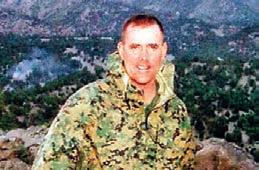
Rice’s proudest military accomplishment was being embedded with 15 Marines in the mountains on the Afghanistan and Pakistan border for 14 months and bringing all his Marines home. Rice was awarded the Bronze Star, Navy, Army, and Marine Commendation Medal and Merritorious Service Medal.
Following his discharge, Rice returned to Fountain County, where he worked in construction. He designed and built his new home.
Rice served as swim coach at Fountain Central High School until his health wouldn’t allow it. He was named Coach of the Year at the Crawfordsville IHSAA Sectional in 2018.
He is survived by his wife Anita; children, Samuel, Jacob, and Mary Rice; and mother.
A Remembrance
I was invited to offer a remembrance of Jay Rice ’86. Initially, I resisted. I was a teammate on the Wabash College swim team in the early 80s. I remember Jay as a spirited individual, a great athlete, and a good man.
The scene: 1982, winter break, a Wabash College van packed with swimmers and divers driving from Crawfordsville to Indian River Community College in Ft. Pierce, FL, for winter training. The sound track: Jay Rice and his boom box and his cassette tape of “Shake It Up,” by The Cars played over, and over, and over. Until the batteries died. Batteries were replaced.
“Shake It Up” was again played over, and over, and over.
There was a dynamic—a tension—between Jay and coaches Bill Rost and Gail Pebworth. Jay was an excellent athlete and a superb swimmer. The coaches wanted more, better, and faster swims from Jay. Most of the time he succeeded.
After Jay left Wabash, he served our country in the U.S. Marine Corps for 20 years. He was discharged as a major. Jay received the Bronze Star for meritorious service. He subsequently worked in construction, was a member of Sterling Christian Church, and served as a swim coach at Fountain Central High School. He died young, a great man.
Remembering Jay was a bittersweet exercise. Some recommendations occurred to me as I pondered the meaning of Jay in my life. Consider writing your own eulogy before you shuffle off this mortal coil. Read John Updike’s “Requiem” and William Shakespeare’s “Sonnett 64.” Consider following the command of Rick Ocasek: “Dance all night. Play all day. Don’t let nothin’ get in your way.”
Kyle A. Carr ’85
Brian Scott Dillman ’95
Brian Scott Dillman, 49, died May 19, 2022, in Indianapolis.
Born October 3, 1972, in Indianapolis, he was the son of Peggy and Scott Dillman.
Dillman graduated from Perry Meridian High School in 1991. While attending Wabash, he was a member of Phi Delta Theta and graduated summa cum laude
He earned his Doctor of Medicine from the Indiana University School of Medicine in 1999 and completed his residency in emergency medicine at Hennepin County Medical Center in Minneapolis, MN, in 2002.
Dillman practiced as an emergency room physician for Emergency Physicians of Indianapolis at Franciscan Health for 20 years. In 2013, he took a full-time position at Eli Lilly where he worked in global patient safety for nine years while continuing to work part time in the emergency room at Franciscan.
He is survived by his wife, Erin; daughter, Eleanor; sister, Lisa; and his parents.
A Remembrance
Brian Dillman ’95 and I met more than 40 years ago on the first day of kindergarten. Over the next four decades, we shared an unbreakable bond forged in the fires of childhood board games, little league baseball, summer camps, aimless walks around the local shopping mall, high school basketball, spring break antics, fraternity pledgeship, and live music concerts. We cheered for our beloved Pacers and Colts in venues that no longer survive. We stood by each other’s side at our weddings and celebrated the birth of our children together. And on one bitterly cold Indianapolis night 30 years ago, we even got matching fraternity tattoos at a shady parlor in a notorious part of town, long before ink became trendy.
It’s no accident we both ended up at Wabash. Brian’s older sister dated Scott Smalstig ’88 in college, and when we were still in high school, she would return to tell us these unbelievable stories about legendary parties at the Phi Delt house.

As high school seniors, we made a campus visit to Crawfordsville together, where we had a most memorable overnight experience, thanks indirectly to a guy nicknamed Bulldog in the Lamba Chi house. But we were destined to be Phi Delts.
Brian knew he wanted to be a doctor from the time he was a kid. But he refused to follow the traditional pre-med path at Wabash. Instead, perhaps inspired by Thoreau, he sucked the marrow out of life as an English major. He consumed the teachings of the English department with vigor. He soaked up the lessons from Professors Warren Rosenberg H’98, Tom Campbell, and Marc Hudson. But he really loved Bert Stern H’62. On many occasions, he would return to the fraternity house for lunch right after one of Stern’s courses and excitedly give me a play-byplay about everything that just happened in class. And like many students from our era, he treasured the novels of Tim O’Brien, which featured prominently in Professor Tobey Herzog’s H’11 curriculum. We both took Esteban Poffald’s calculus class the first semester of our freshman year. Pledgeship and college sports were both consuming the majority of our time and prevented us from devoting our full attention to the class. Despite these nonacademic distractions, I watched with jealousy as Brian glided through effortlessly, as most of the students, myself included, floundered. That was the point when I really recognized he had a special intellectual gift that few others possessed.
74 WABASH MAGAZINE In Memory | continued
Clockwise from bottom left from the Class of 1995: Scott Simpson, Tim Bailkowski, Brian Dillman, David Kogan, and Chad Clisby
During our senior year, Brian and I shared an off-campus house on Russell Avenue with our pledge brothers, David Kogan ’95 and Chad Clisby ’95. That was a special year in our lives, as we collectively savored the last of everything Wabash had to offer and plotted out our future endeavors.
Brian’s death has been hard to accept for so many people who knew him, but his passing has been very tough on his Phi Delt pledge brothers, especially the former residents of 405 Russell Avenue.
Clisby said, “You just don’t meet too many people like Brian Dillman. Very simply, he was the best. I will cherish him for the rest of my life!”
And Kogan said, “I loved him like a brother, and I miss him dearly. I’m grateful for every moment I ever got to spend with him.”
At Wabash, Brian was a member of Phi Beta Kappa, a Bachelor columnist, a defensive back on the 1991 ICAC Championship football team, a member of the baseball team, a three-time IM football All-Star, and a beloved brother in the Phi Delta Theta fraternity. He studied abroad in Scotland in the spring of 1994 and graduated magna cum laude
After graduation, 2,000 miles separated us, but that distance never drove a wedge in our friendship. We texted and spoke regularly, and when we did see each other, we picked up right where we left off without missing a beat. We loved trading life stories. I’ll deeply miss those exchanges; there is a void now in my life that will never be replaced.
When I learned Brian had died, I sat alone in my study and listened to an album he enjoyed while we were in college: Paul McCartney’s 1982 solo record Tug of War
There’s a song on the record called “Here Today.” It’s the song Paul wrote as a tribute to John after he died. The song is written like a fictional dialogue between Paul and John. It closes with Paul saying to John, “I really loved you… and was glad you came along…for you were in my song.”
After listening to the album repeatedly, I realized something for the first time: Brian was my John Lennon, and I was his Paul McCartney. And just like Lennon and McCartney, we made sweet music together in the prime of our lives.
He was a great father and husband. He was an amazing brother and son. He was a talented and caring doctor. He was my best friend. He was my brother. He was Some Little Giant.
Scott Simpson ’95
A Remembrance
Roses blossom in the mind’s eye when remembering Marion H’55 and Vic Powell H’55. Crawfordsville residents remember the beautiful rose garden they cultivated at their home on John Street. Roses seem an appropriate symbol for the gentle sweet-smelling fragrance that wafted from their home and the College during their long residence. Vic requested that a bouquet of sixty-four yellow roses be placed in the Wabash Chapel during his memorial service, one for each year of their long marriage.
FISH programs that provided food, clothing, furniture, linen, and financial aid.
Marion served as vice president of the local NAACP during the tumultuous period of the Civil Rights Movement. People forget how much that witness was needed in support of our local African American neighbors during that time. Those, like Marion, who humbly accepted leadership early on are now often ignored in current accounts of the local story.
Marion Powell H’55, 97, died August 4, 2022, in Libertyville, IL.

Born July 15, 1925, in Plymouth, MA, she was the daughter of Mabel and William Clark. She graduated from Plymouth High School and attended Bridgewater State Teachers College. She graduated from Library School in Springfield, MA. Marion married Victor Powell H’55 in 1947 and moved to Crawfordsville, where she was active in the community. She helped organize and served as the first elementary school librarian in Crawfordsville. She was the director of the first Sheltered Workshop, the first director of the FISH program, and worked 20 years as the children’s librarian at the public library. She taught Sunday school at the United Methodist Church, where she was a member for 70 years. She was a Girl Scout leader and vice-president of the Crawfordsville chapter of the NAACP. She packed and delivered Meals on Wheels and volunteered at the Wesley Thrift Shop.
In September 2021, she was acclaimed as an honorary alumna of Wabash.
Powell was preceded by her husband in 2011.
She is survived by her daughters, Carol Lombardi and Karen McCarthy; four grandchildren and two great-granddaughters.
They expected to stay only a year or two when their honeymoon was a long train and bus trip to Crawfordsville, where Vic interviewed for a position at Wabash. He thought a year or two teaching with W. Norwood Brigance, a giant in the field of speech, would be a firm foundation for his career. It was, indeed, and Marion and Vic remained for the rest of their lives closely tied to Wabash and Crawfordsville— firmly anchored in their family, the College, First United Methodist Church, and the community.
All Marion’s activities exhibited high energy, honesty, diligence, intelligence, good humor, and humility. She and Vic first lived in a quonset hut in Mud Hollow. Thereafter, Marion was regularly on campus throughout Vic’s tenure as professor, head of the Wabash Speakers Bureau, dean, and acting president, always supportive of him, welcoming students, and helping young faculty. She and her family sang “Dear Old Wabash” in word and deed as firmly and beautifully as anyone. It is most appropriate that Wabash honored Marion by making her an honorary alumna. Many welcomed that recognition with a tear in their eyes.
Marion was a stalwart presence in First United Methodist Church, regular in her attendance, and leading in many activities. She was always concerned about people in our community who were in need. She assisted leaders of her church in establishing and supporting many of the programs of the local FISH Organization. She volunteered in the food pantry that fed the poor, the Wesley Thrift Shop, the Christian Nursing Service and Well Baby Clinic, and the expansion of the
Eric Dean said that some dead deserve to disappear because they have no one to remember and honor them for their good works. Marion is remembered for her beauty as a person, her smile and good humor, and for her faithful work in helping others. She is remembered and honored by many Wabash men and women, by friends at First Church, and by those who worked by her side helping those in need in Crawfordsville. Others who benefitted remember her good deeds even if they never knew her name. She worked humbly, mainly behind the scenes.
Marion and Vic took greatest pride in their two daughters and families, who remember Marion as a sturdy anchor of their lives and readily “rise up to call her blessed” (Prov. 31:28).
To live a long, good life dedicated to college, church, community, and family in such a way as to be remember and honored is not a bad life. And, borrowing a phrase from Bill Placher ’70, she and the family “had a lot of fun along the way!”
Raymond Williams H’68
Marion Powell H’55
WABASH.EDU 75
THE TALLGRASS’ LAST FEW SHADOWS
 by Greg Hoch ’94
by Greg Hoch ’94
“If the traveler from the coast of the Atlantic Ocean to this point has grown weary of the endless journey in the forests then he believes himself transferred to another region of the world as soon as he crosses the Wabash and beholds those beautiful prairies…”
Ernst 1903
76 WABASH MAGAZINE Voices | FALL 2022
Royal catchfly is one of the iconic species at Smith Pioneer Cemetery
Wabash may be a uniquely Hoosier word. It is derived from the French Ouabache, which is a translation or transliteration from the Miami language for “water over white stones.” Wabash is first a river, but also a state park, a city, and a college.
Indiana is the crossroads of America. It says so on the billboards. Indiana is also an ecological crossroads. The range of many plants either starts or stops, depending on your perspective or direction of travel, in Indiana. There’s tamarack from the north, beech from the east, sweet gum from the south, and compass plant from the west.
The Wabash River was a crossing, or dividing line, between two major biomes— deciduous forest and the tallgrass prairie. Traveling westward across Pennsylvania, Ohio, and Indiana, pioneers and settlers came to grassy opens or barrens devoid of trees. After a few hours or a couple days, they again met with the familiar shelter of trees. Once settlers crossed the Wabash River it was open prairie, only sky over their heads and grass beneath their feet. They would not meet continuous forests again until the foothills of the Rockies, half a continent farther.
Wabash College was as much a crossing for me as the Wabash River was for the early settlers. As a Hoosier schoolkid, prairie was simply a field trip to Fishers. Since Wabash, the prairie has dominated my life.
My first tallgrass prairie was Smith Pioneer Cemetery in Vermillion County, just west of the Wabash River, in the summer between my freshman and sophomore years. I don’t remember the date, but I remember who I was with.
We make decisions every day in our lives, most inconsequential, some having consequences that reverberate through the rest of our lives. As a high school student I chose Wabash College. The second decision, which seemed far less important, was what freshman tutorial to choose. That class didn’t change my life, but in choosing a tutorial I was choosing an academic advisor. Four years of advice on what classes to take next the semester turned into a friendship and mentorship that continues to this day, three decades after that class. I still seek Emeritus Professor of Biology Dave Krohne’s advice and insight weekly, often daily.
During my sophomore year, a couple classes took a weekend field trip to Green Oaks Prairie where Dave did his undergraduate research. There he introduced me to Pete Schramm, his professor. A couple weeks ago I spent a day at Pete’s house listening to his stories. If having a good friendship with your professor’s professor more than a quarter century after graduation doesn’t speak to the value of the personal connections we develop at Wabash, then what does?
Perhaps my biggest regret from my time at Wabash is that I did not overlap with Robert Petty, biology professor and poet laureate of Indiana’s natural heritage. He described these prairies and prairie cemeteries perfectly when he wrote that the settlers “who turned their lives against a wilderness of grass should sleep in its last few shadows.”
After my years at Wabash, I spent eight years in Kansas studying the prairie. From Kansas it was up to Minnesota to teach, then research, and eventually to help administer, fund, and develop policy for protecting, restoring, and managing prairies. For almost a decade, the word prairie has been in my job title.
As a college student, and even a graduate student, I foolishly assumed I needed to know my birds, mammals, insects, plants, soils, and their interactions to understand and help conserve the prairie. Ha!
Biology is important, but so is a historical context. Should this piece of land be restored to prairie or forest? Why? What role did Native Americans and Euro-American settlers have in the history of this parcel?
Prairie country is farm country. Farm country is dictated by farm economics which is dictated by farm policy and politics. All of that is related to the federal Farm Bill. A drought in the southern states could boost corn prices in northern states. Farmers in other countries flooding global markets with soybeans could drive down prices for American beans. Then there is livestock, grazing, haying, and markets. Add the international politics of trade wars, tariffs, or embargoes. Finally, add in the social, economic, and ecological repercussions of climate change.
All of that will drive interest in conservation policies, programs, and practices across the Midwest. Waterfowl, pheasant, and songbird populations all track grassland acres enrolled in various programs within the Conservation Title of the Farm Bill. Biology, history, economics, international affairs, weather and climate— it clearly takes a liberal arts approach to understand grassland conservation.
The different trajectories my career has taken reminds me daily that what I learned at Wabash, the facts and figures, might not be that important. A lot of that has changed since graduation. The most valuable lesson I learned from all my professors was how to learn.
That first summer of research, I asked Dave what books he could recommend for afternoons after we came back from our fieldwork. He recommended a little book by someone named Aldo about some sand counties in Wisconsin.
In a 1942 essay titled “The Role of Wildlife in a Liberal Education,” Aldo Leopold states, “The objective is to see the land…I say land rather than wildlife, because wildlife cannot be understood without understanding the landscape as a whole.” In the next paragraph he continues, “Perhaps the most important of these purposes is to teach the student how to put the sciences together in order to use them. All the sciences and arts are taught as if they were separate. They are only separate in the classroom. Step out on the campus and they are immediately fused. Land ecology is putting the sciences and arts together for the purpose of understanding our environment.”
Today, the eastern tallgrass prairie is functionally extinct. An acre here, an acre there, often dotted with tombstones or bordered by some of the earliest railroads. Across Iowa, Illinois, and Indiana, less than one tenth of one percent of the prairie remains. Leopold wrote, “One penalty of an ecological education is that one lives alone in a world of wounds.”
There is no more wounded landscape than the tallgrass prairie. My Wabash education introduced me to those wounds and gave me many of the tools and skills I need to do my small part in healing those scars.
WABASH.EDU 77
photo by David Krohne
A Love Affair
by Mike Laudick ’82
It was love at first sight. The affair was totally unexpected. I had gone to Europe on a lark. But, on my first trip to Europe, I fell in love—with Italy.
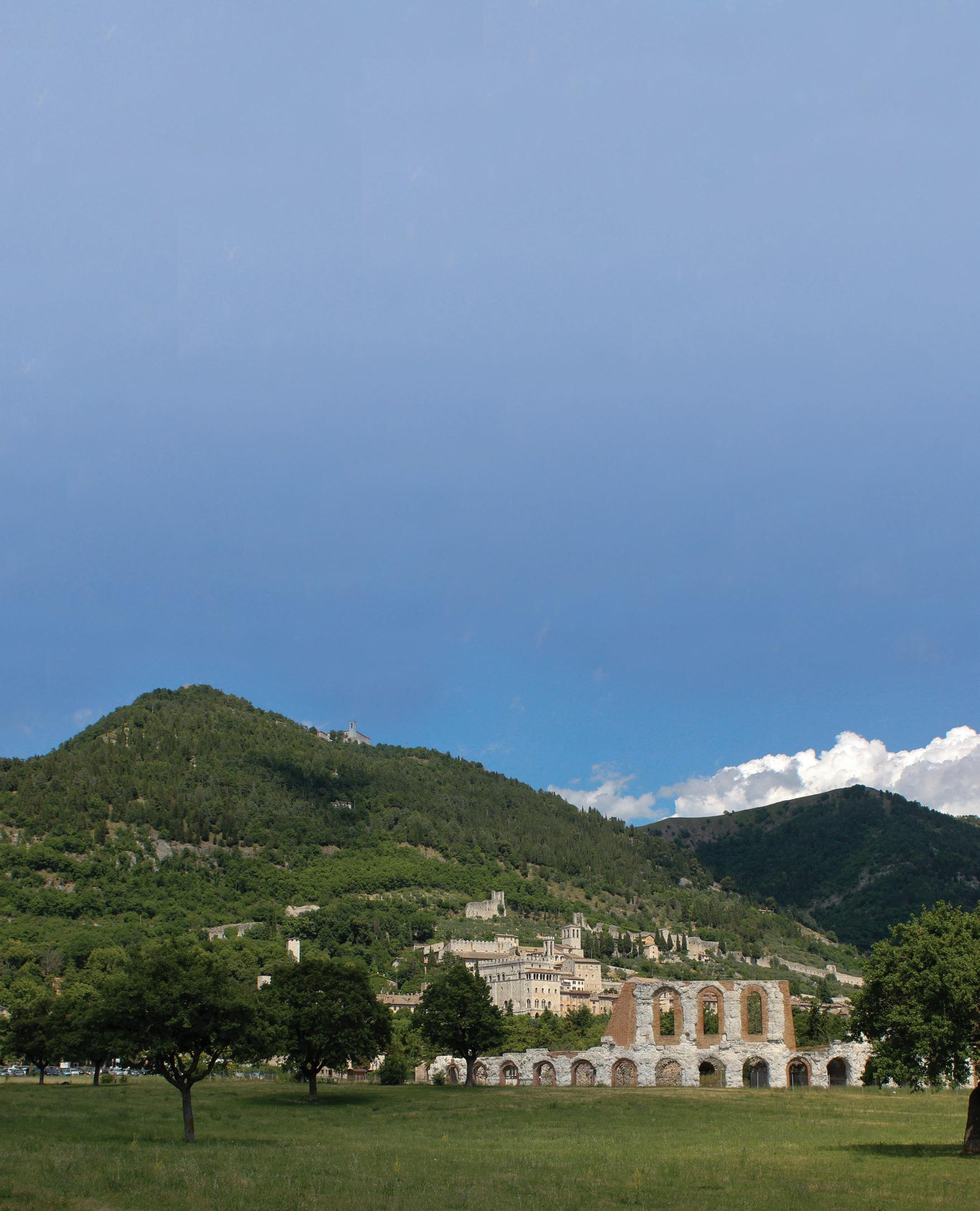
I had just graduated from Wabash and entered the work world in the midst of a deep U.S. recession. Jobs were scarce, but I managed to find two temporary jobs that lasted about a year. Then, I found myself unemployed again.
At that point, a couple of Wabash fraternity brothers came to my rescue with an idea.
They said, “After we finish our Glee Club tour, why don’t you come meet us in Germany. We can travel around Europe for a couple weeks. We’ll stay in cheap places, mostly with friends and relatives. Then you can come back home for some serious job hunting.”
My budget was as bare-bones as you can get—rock-bottom air fares, a cheap backpack, worn-out sneakers, some rundown youth hostels, and basic meals.
But I was intrigued about taking this trip, due in great part to Emeritus Professor of Classics John Fischer H’70, who served as the faculty advisor to my fraternity, Lambda Chi Alpha. He often spoke to me about the Greeks, Romans, and all kinds of things when we met weekly when I was an officer in the fraternity.
In a roundabout way John planted a curiosity in me for Europe, in general, and Italy, in particular, even though I never actually took a class with him.
This impromptu trip became an epic, life-changing experience. I never intended to fall in love with Italy, nor did I think I would ever live there someday.
On that first trip, my fraternity brothers and I traveled together as planned, then went our separate ways. My friends lingered in Spain and I had enough money left over to go on my own to Italy for a few days.
I arrived in Rome on a rainy, humid, languid summer evening, found an inexpensive hotel near the train station, and checked in.
It was quite late and the hotel clerk took pity on me, shepherding me next door to see if the small family-owned restaurant was still open. Fortunately, it was.
For my first Italian meal, the proprietor recommended some pasta that was out of this world. It was served in a simple sauce of garlic and tomatoes that was fabulous. I self-consciously exclaimed in English to the waiter it was the best pasta I had ever eaten. He clearly understood my excitement and shortly returned with a second serving of pasta and an extra glass of a sublime white wine at no extra charge.
This was my first introduction to Italian kindness and generosity. I know now that Italians routinely treat their customers as if they are friends and family.
78 WABASH MAGAZINE Voices | FALL 2022
I spent a few glorious days eating Italian food, exploring museums, churches, and ruins from Roman times. The stunning centuries-old architecture overwhelmed my sensibilities. The hustle and bustle of Rome, along with the pervasive rat-tat-tat sound of two-cycle engine motor scooters, was thrilling.
Ambling along the alleys was like surfing from one great wave of aroma to another. I was constantly hungry because of smells of meals being prepared wafting through windows kept wide open due to the lack of air conditioning.
Gelaterias offered dozens of flavors of homemade gelato prepared in a wild array of colors that rivaled the stunning sunsets of pink, orange, and red.
I felt comfortable there—miles, ages, and worlds away from the Midwestern U.S. town where I grew up. Italy was just as welcoming to a naive young man from mid-America as Professor Fischer told me it would be.
I returned home, built a good career, and co-founded a successful philanthropic consulting business that served hundreds of libraries, youth organizations, museums, colleges and universities, social service organizations, arts groups, and others in 28 states across the country.
I spent my spare time revisiting Italy and learning as much as I could about the country and its people. I realized that the comfort I felt in Italy was not just a passing infatuation. On each return trip, the country became more alluring, more wonderous, and inescapably captivating. I was fortunate to travel elsewhere, but was always drawn back to Italy and especially Central Italy.
At home, I studied Italian at our local university. I bought cookbooks so I could learn Italian cooking. I devoured books about history, geography, architecture, wine, art, and artists. I delved into the lives of Romans and Etruscans. I became fascinated by the histories of Roman and medieval hill towns.
My 35-year career gave me a gratifying sense of fulfillment but I decided it was time to make a permanent change. Thanks to Fischer, who instilled in me an interest in things far beyond my Wabash degree, I retired early to pursue my dream of living in Italy.
After living here full-time for a number of years, I have found Central Italy to be exceptionally accessible and welcoming. It is far less touristed than many other regions.
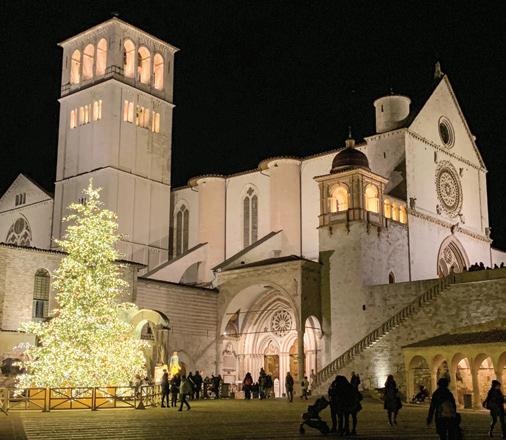
My experience has been that Italians in Central Italy are down-to-earth, generous, kind, open-minded, and refreshingly authentic. With my long-held interest in food and wine, Umbria became my dream place. It is known for having some of the best food in all of Italy.
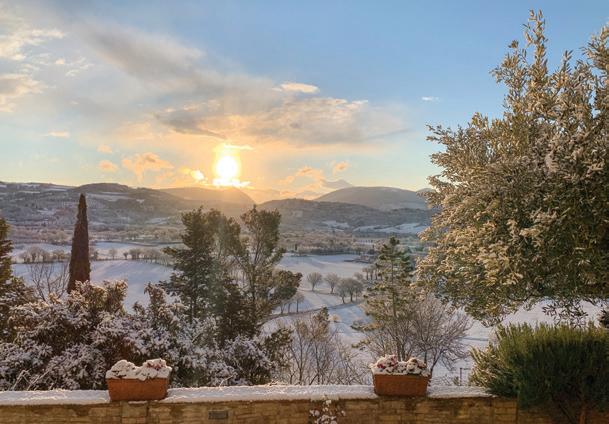
Now I am working on an “encore career.” It is completely different from my previous career and enables me to put my Wabash liberal arts degree to good use.
I am a representative for the U.S. tour company called Italy!Adventures.
At Italy!Adventures, I have an opportunity to introduce guests to my favorite towns and places. They get a chance to enjoy some scrumptious food at familyowned restaurants while sampling many unknown but remarkable wines, including wine from a grape that is found only in this area of the world.
My biggest delight is helping guests explore at their own pace, just like I did on that very first trip. They get to explore up close a number of mind-boggling hill towns that are loaded with incredible art and architecture.

On a tour, I know I have succeeded when guests thank me for an unforgettable trip, for enabling them to see and experience some things they would never be able to in the U.S., and for teaching them how to slow down and smell the pasta!

I felt comfortable there—miles, ages, and worlds away from the Midwestern U.S. town where I grew up. Italy was just as welcoming to a naive young man from mid-America as Professor Fischer told me it would be.
79
Left: the Roman theater in Bubbio, built in 20 B.C.; above left: the Christmas tree in Assisi next to the Basilica of St. Francis; above right: the Infiorata festival held in the summer in Spello; right top: John Fischer and Mike Laudick ’82 in Siciliy; and right: the view from Laudick’s terrace in Spello on a winter day.
On Love, From the Heart of a Little Giant
The first time i arrived in indiana, I was afraid, and relieved. I was afraid of failing. I was relieved because I was no longer home. Samuel, an international student from Pakistan, picked me up from the airport and took me to Trippet Hall to meet Clint Gasaway ’86, my admissions counselor. I had only spent a handful of minutes on the phone with Clint, yet upon my arrival, he greeted me with a level of kindness and care only abuelita had ever shown me. I remember seeing Pioneer Chapel for the first time as I looked out the doors of Trippet Hall. That night, I said to myself, “This place is new now, but it will be home. You will make memories and friends. It will all be fine.” Somehow, those words uplifted 18-yearold me at that moment.
I was dropped off at Lambda Chi Alpha. I talked to my mom briefly on the phone and reassured her all was fine. But really, I was scared, so scared.
I remember seeing Pioneer Chapel for the first time as I looked out the doors of Trippet Hall. That night, I said to myself, “This place is new now, but it will be home. You will make memories and friends. It will all be fine.”
It was late. It was my first time leaving California in a long time, my first time on campus, ever. My understanding of fraternity life back then was tied to tons of misinformation. David Wagner ’05, president of the house, and Kyle Coffey ’06, treasurer, were busy getting the house ready for the incoming freshmen. They seemed shocked by my arrival. As they introduced themselves, I remember mistrusting them because life had taught me to do so for survival. I wondered when the bad would begin. But this is where the definition of love I know today began to take root. They showed me this love without even knowing me. They made sure I had a bed and helped me set it up. That was my move-in day at Wabash, how I began my college career. This love kept coming from everyone around me.
Long before I was loved by Wabash, I did not love myself. I did not know how to do so. I never learned this. So, I assumed no one else could love me, especially not Wabash. And I mistrusted a lot, but people at Wabash still loved and supported me, and the professors and upperclassmen became my mentors.
Wabash is a place where you know you will always have a helping hand, someone will always be willing to go the extra mile to be there for you, even after you graduate. It’s a quality that makes the College special.
Back then, I did not always feel like this was true. I didn’t feel like one of “the guys” because of my immigrant experience, multilingual and cultural background, social class, legal status, and sexuality. I kept them hidden from those around me, even myself sometimes. I thought I had to be everyone but myself. And not being you is hard, especially when you’re growing up still afraid to show your true colors.
Wabash loves all of us, we are thy loyal sons. Wabash will ever love thee. In Spanish it’s known as siempre te amaré. During my time at Wabash, it was hard for me to see this love, it was hard for me to understand. The love I knew growing up was different. It was not love. It was unresolved trauma disguised as love, handed down from one generation to another.
I want to break cycles, not ride them.
My goal in the coming years is to find ways to show my love for my alma mater with a commitment to acknowledge the needs and serve the Latinx and Spanish-speaking students. I often tell my students at Millikin, “You need to lead the change you wish to see in your community.” I trust that if we all listen and find ways to support their vision, we will get to see how great we can be in the years to come.

Until then, I love you, Wabash, siempre te amaré.
Dr. Julio Enríquez-Ornelas ’08 is an associate professor of Spanish, literary critic, editor, and writer. At Wabash he was a double-major in English and Spanish and a member of Lambda Chi Alpha. He earned a master’s in Hispanic studies and a Ph.D. in Latin American literature and culture from the University of California-Riverside. He is an assistant professor of Spanish at Millikin University, where he also coordinates the global studies program and chairs the department of modern languages. “On Love, From the Heart of a Little Giant,” is excerpted from his Chapel Talk in September 2022. To see the entire Chapel Talk, visit www.youtube.com/wabashcollege/videos
80 WABASH MAGAZINE Voices | FALL 2022
Innovative Teaching and Technology Fund Honors
Dr. Z
by Allie Northcutt
at the annual careers in chemistry panel, students are given the opportunity to learn about the different kinds of professions they can pursue as a chemistry major.
But this year’s event in October was extra special as several alumni, Wabash faculty, family, and friends surprised and honored Emeritus Professor of Chemistry John Zimmerman H’67 by announcing a new endowed fund established in his honor.

The Dr. John F. Zimmerman H’67 Fund for Innovative Teaching and Technology will support course design that incorporates new technology, novel teaching practices utilizing technology within existing courses, the replacement and updating of lab instruments, and associated upgrades to Hays Science Hall classroom technology that support teaching innovation.
Fund donors include Russ Bostick ’79, Bryan Daniels ’81, Chris Halkides ’83, Ray Knight ’69, Frank Kolisek ’82, Brad Maxwell ’83, Scott Rathgaber ’84, Tom Roberts ’70, Mark Simmons ’73, and John Van Drie ’74.
“These alumni are among the many hundreds of Wabash students who learned from you, who were motivated by you to dream a bit bigger and expand their horizons, and who are grateful for your
guidance,” President Scott Feller said at the event. “In keeping with your principle ‘theory guides but experiment decides,’ these donors have cemented your legacy at Wabash by establishing an endowed fund that will help ensure the chemistry department will stay on the cutting edge of technology by advancing novel teaching and providing equipment as needed.”
Initial gifts and commitments to the fund from generous benefactors have topped $400,000, says Feller, and that total is expected to grow even more over time.
“It’s hard to put into words how I feel. That recognition from my students and seeing this fund come together is special,” says Zimmerman, who joined Wabash staff in 1963 and taught for 41 years before retiring in 2004.
Zimmerman pushed the boundaries of teaching, and was a pioneer in using handcrafted handouts and the personal computer in his Wabash classroom and laboratory. He also brought technology to the wider chemistry community in the form of instructional videos.

“My philosophy as a teacher was that I was always open to anybody,” says Zimmerman. “My students knew that no one was working harder for them than me.”
department chair and associate professor of Chemistry Dr. Laura Wysocki says the fund will greatly support faculty as they work to advance their own instructions and classrooms.
“There are new instruments out there that are even better for teaching. Our faculty are really innovative in how we want to think about teaching, but sometimes funding can be a limitation,” Wysocki explained.
She says the ability to have new, advanced technology in the classroom will also help students succeed beyond Wabash.
“That’s one of the benefits of being at Wabash—the support for new technology for our students,” she says. “I’ve already seen it in my organic chemistry lab. Students can visit Eli Lilly and Company, for example, and they’ll see some instruments that they used in my lab. That gets them excited.”
Zimmerman, who remains active in the department even in retirement, says he’s excited to see the funds be put to good use.
“I see this as an avenue to support creative methodology and instrumentation for teaching at all classroom and lab levels,” says Zimmerman, “and for our faculty to be innovative in their thinking of new ways to do so.”
Alumni and friends interested in adding to the impact of the Dr. John F. Zimmerman H’67 Fund for Innovative Teaching and Technology with their own philanthropy may contact the Advancement Office for more information at giving@wabash.edu or 877-743-4545.
WABASH.EDU 81 Faculty Notes | FALL 2022
Andrew “Andy” Bieberich ’92, Ray Knight ’69, Mark Simmons ’73, John Zimmerman H’67, Brad Maxwell ’83, Angela Maxwell, Scott Rathgaber ’84, and Mary Rathgaber at the Careers in Chemistry panel.
Quick Notes
John P. Collett Chair in Rhetoric Professor of English Agata Szczeszak-Brewer won the 2022 Gournay Prize in nonfiction for her memoir “The Hunger Book.” It will be published by Ohio State University Press in 2023.
Associate Professor of English Derek Mong’s essay, “Teaching Emily Dickinson to Men,” was published in The Boston Globe


Professor of Religion and Bowen Chair in the Liberal Arts Derek Nelson and SALT Productions shot a mini-documentary video recording his ecological theology and home construction project. The film, “Framing House and Home,” can be viewed at www.attemptedjoinery.com.
Assistant Professor of Philosophy Jeff Gower ’s translation of Martin Heidegger’s “Duns Scotus’ Doctrine of Categories and Meaning” appeared in the Indiana University Press
Assistant Professor of Economics Sujata Saha co-published “Foreign Exchange and Global Monetary Shocks” in International Economic Journal; “Spillover Effects of Quantitative Easing on Exports in Emerging Market Economics” in Global Economy Journal; and “On the Link between the Real Exchange Rate and Domestic Investment in Asia” in Journal of the Asia Pacific Economy

Associate Professor of Philosophy Matt Carlson published two articles this year: “Traditional Epistemology and Epistemology Naturalized” in Logique et Analyse and “Anti-Exceptionalism and the Justification of Basic Logical Principles” in Synthese




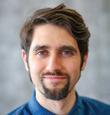


New Tenure-Track Faculty
Three new tenure-track faculty joined Wabash this fall. Joe Scanlon ’03 joined the chemistry department as an associate professor. After serving as visiting assistant professors, Matthew Gorey has been named assistant professor of Classics and Matthew Greenhalgh has been named assistant professor of Spanish.
Department Chair and Associate Professor of Philosophy Adriel Trott published the chapter “Beyond Biopolitics and Juridico-Institutional Politics” in the volume Bios and Polis
Art Professors Annie Strader and Matt Weedman had a solo exhibition of their work at the Kresge Gallery at Lyon College. The exhibition drew upon their research into the histories of early 20th-century technology, modern spiritualism, magic, and feminism.
Professor of Chemistry and Senior Associate Dean of the College Ann Taylor co-authored the chapter, Athletics, in “Acute Crisis Leadership in Higher Education: Lessons from the Pandemic.”
Assistant Professor of Physics Nate Tompkins and Professor of Psychology Karen Gunther published a paper titled “Color Vision Deficiency and Teaching Electromagnetism” in The Physics Teacher




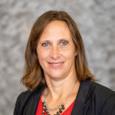

Professor of Biology and Global Health Initiative Director Eric Wetzel co-published a paper in The Journal of Parasitology titled “Review of Dioctophyme renale: etiology, morphology, biology, ecoepidemiology, pathogenesis, symptomatology, diagnosis, treatment and prevention.”
Beth Lindsay Daniel received the Heart of PALNI Award from the Private Academic Library Network of Indiana (PALNI). The award recognizes those who embody PALNI’s deep collaboration and supportive culture in their work in PALNI groups and initiatives.
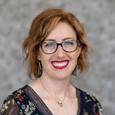


New Chairs
Professor of Classics Jeremy Hartnett began his tenure as the Charles D. and Elizabeth S. LaFollette Distinguished Professor in the Humanities.
Department Chair and Associate Professor of Philosophy Adriel Trott began her tenure as the Andrew T. and Anne Ford Chair in the Liberal Arts.
82 WABASH MAGAZINE Faculty Notes | continued
Department Chair and Associate Professor of History
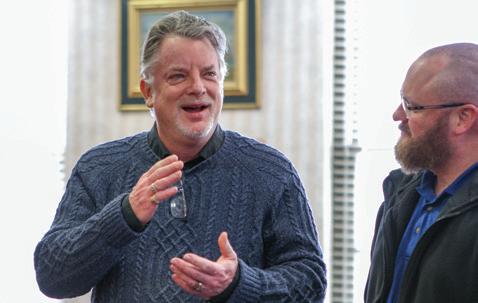

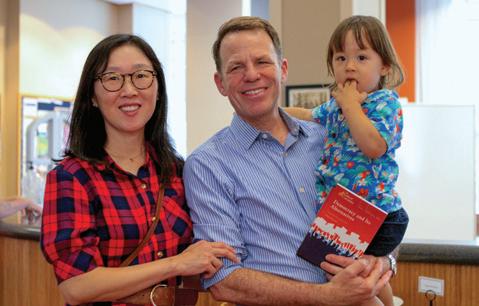
Sabrina Thomas was honored for the publication of her first book, “Scars of War: The Politics of Paternity and Responsibility for the Amerasians of Vietnam.” Thomas’ work examines the decisions of U.S. policymakers denying American citizenship to the biracial sons and daughters of American fathers and Vietnamese mothers born during the Vietnam War. Thomas’ book received the Best First Book Award from Phi Alpha Theta, the honor society for undergraduate and graduate students and professors of history.
The campus community celebrated Beesley Chair and Professor of History Stephen Morillo in November for the publication of his new book, “War and Conflict in the Middle Ages.” The book offers the first global history of armed conflict between 540 and 1500 or as late as 1800 CE, an age shaped by climate change and pandemics at both ends.
“As a classicist, I have long been interested in the embodied experience of the ancient past, particularly in areas of religion and healthcare, and often at points where these two areas intersect, such as at healing sanctuaries where people sought cures from the Gods,” Wickkiser said at the event.

“Let’s face it: Classics is an enigmatic term. Classic what? Classical music? Classic cars? Loosely put, Classics as an academic discipline is the study of Greek and Roman antiquity,” says Wickkiser. “This encompasses study of two of the languages widely spoken in the ancient Mediterranean (Greek and Latin), the literatures that were produced in these languages, the material remains of the Greeks and Romans, what they did and how they lived. That’s a lot under one umbrella.”
The Ides of August—a decades-old tradition that brings faculty together at the end of the summer to discuss their personal scholarship and research—continued in Hays Hall when dozens of professors presented reports on a variety of topics ranging from oral lab reports in organic chemistry to building healthy communities through civic mapping.
Wabash faculty, staff, and friends came together for a launch party in September to celebrate Associate Professor of Political Science Ethan Hollander and his publication a 24-lecture series titled “Democracy and Its Alternatives,” which is available to view at www.wondrium.com and www.thegreatcourses.com.
Listen to Hollander talk about the backstory of this educational effort on the Wabash On My Mind podcast. Visit www.wabashcollege.libsyn.com.

This lecture series was established by the Wabash College Board of Trustees to honor Charles D. LaFollette, their longtime colleague on the Board. A successful businessman, LaFollette was a devoted friend of the humanities and the arts. The annual LaFollette Lecture is given by a Wabash College faculty member who is charged to address the relation of their special discipline to the humanities, broadly conceived.
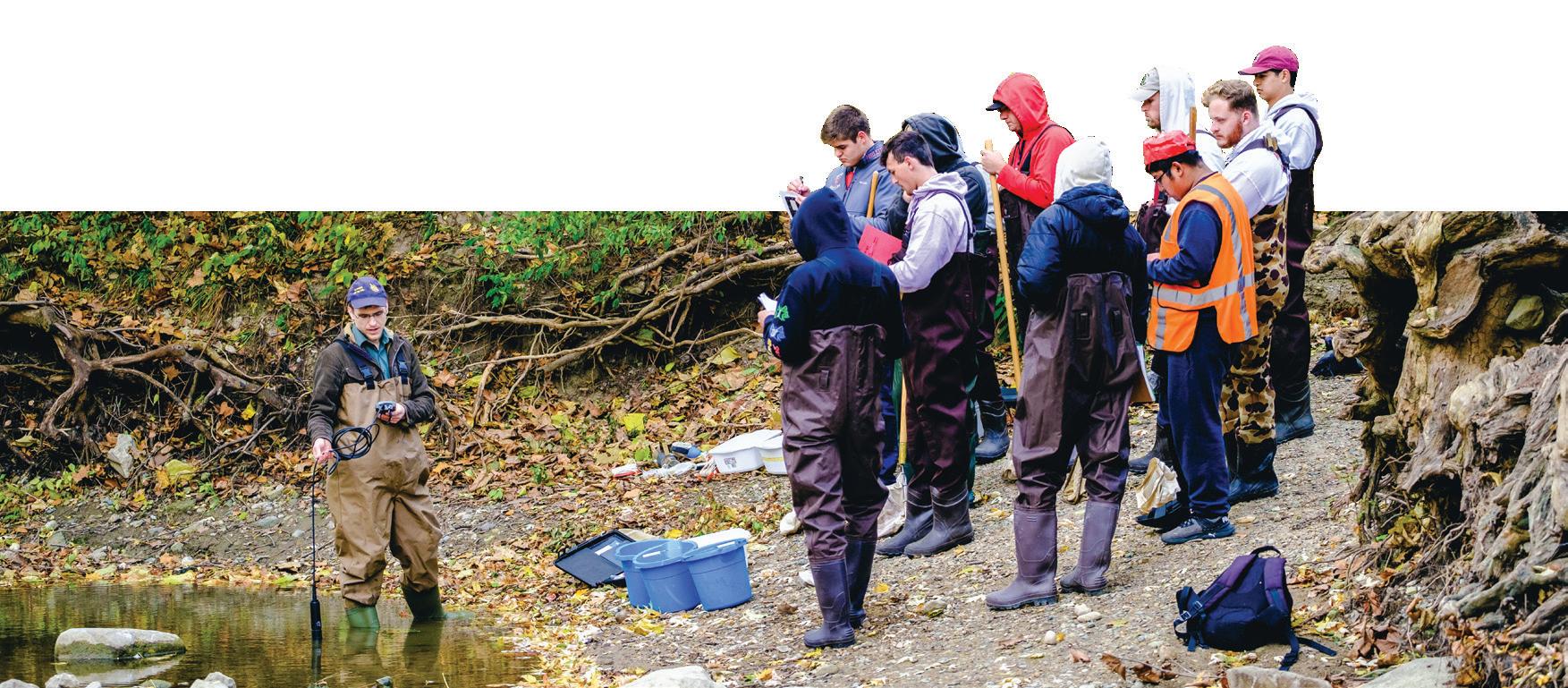 The 42nd LaFollete Lecture was presented in September by Professor of Classics Bronwen Wickkiser with her talk,“Embodied.”
photo by Anna Tiplick
The 42nd LaFollete Lecture was presented in September by Professor of Classics Bronwen Wickkiser with her talk,“Embodied.”
photo by Anna Tiplick
83
Biology Professor Brad Carlson conducting tests with students on the bank of Sugar Creek.
Yao Li
 by Allie Northcutt
by Allie Northcutt
Yao Li, instructor of Chinese and special assistant to the International Center, from Beijing, China, joined the Wabash faculty in 2015. Li welcomed Wabash Magazine into her office to discuss the origins of her educational philosophy, her dynamic approach to teaching, and how she’s blended home, family, and fun into her campus décor.

Most of the knickknacks you’ll find displayed in Li’s office were collected by her mother. “She found the teaching nut when she visited me in 2020. I thought, ‘oh, that’s me!’ I really am a teaching nut, because I love teaching. I enjoy teaching the language, but what I love more is communicating and connecting with my students.”

84 Bookshelves | FALL 2022
photos by Kim Johnson
“One of my close friends gave me this tea set in 2017. A year later, when we were having the Asian Studies Minor Committee meeting and trying to to think of more ways to attract students and get them interested in Asian cultures, we came up with the idea of hosting a tea ceremony. The first ceremony was big success, and we used this tea set to teach students how to make gongfu tea in a Chinese setting.

“This is the fourth year, because of the COVID-19 pandemic, that I haven’t been able to go back to China. I’m an only child, and normally in my culture, if you’re an only child your parents wouldn’t want you to leave the city. But my parents supported my dreams. They encouraged me and said, ‘You only have one life. Go and do what you really love. We will always support you.’ My

“When I came here to Wabash, I didn’t have anything. It was just me. The instructor before me left this, and I thought, ‘How creative!’ This empty box, with sticky notes on each side, shows you all the location and space words written in Chinese, like front, back, up, down, inside, and outside. It’s been seven years since I first found the box, but I still use it in my classes. This little prop is so simple, but it’s always inspired me to think and be more creative in my lessons.”

Li was a fellow with the Alliance for Language Learning and Educational Exchange (ALLEX) Foundation, an education firm that enables American universities to begin or maintain a high-quality Chinese or Japanese language program by providing them with professionally trained, native instructors. During her training, Li studied “Performed Culture: An Approach to East Asian Language Pedagogy” by Matthew Christensen and Paul Warnick.

“When I got this book, I was starting my teaching career at the groundlevel. Learning about how to teach Chinese in America was so much to comprehend, and I took lots of notes. I remember one lesson clearly. I was shocked to learn that it was OK to speak in the language right away. It was actually encouraged to speak in Chinese and not say anything in English on the first day of class. I thought, ‘Wow, how intimidating.’ But over the years I have come to understand that even though it is hard on the students, it is a good practice and the best way to learn a new language.”

WABASH.EDU 85

 A small section of the Peace Wall on Cupar Way in Belfast, Northern Ireland. The miles-long wall is covered in messages of hope and peace from visitors around the world.
photo by Kim Johnson
A small section of the Peace Wall on Cupar Way in Belfast, Northern Ireland. The miles-long wall is covered in messages of hope and peace from visitors around the world.
photo by Kim Johnson
Crawfordsville, Indiana 47933-0352
LAST GLANCE
Max Kercheval ’23 carves details in the hairline of his puppet as part of Theater 303 Study in Czech Puppetry. Students in Costume Designer Andrea
 Bear’s course spent a week alongside master puppet maker Mirek Tregtnar in his workshop in Prague, the capital city of the Czech Republic.
P.O. Box 352
Bear’s course spent a week alongside master puppet maker Mirek Tregtnar in his workshop in Prague, the capital city of the Czech Republic.
P.O. Box 352
SERVICE
NON-PROFIT ORGANIZATION U.S. POSTAGE PAID WABASH COLLEGE
CHANGE
REQUESTED
photo by Jacob Paige ’23




 photo by Becky Wendt
photo by Becky Wendt











 Greg Birk ’77
Greg Birk ’77
 Jim Daniel ’62
Jim Daniel ’62

 Mark Scott ’89
Mark Scott ’89

















 TKE Reunion
Moot Court
Sphinx Club Reunion
Delt Reunion
TKE Reunion
Moot Court
Sphinx Club Reunion
Delt Reunion




 Grawe
Class Agent Forum
Puerto Rico Immersion
Grawe
Class Agent Forum
Puerto Rico Immersion



 Pumpkin Carving
Pumpkin Carving







 Left to right: Will Netting ’25, Ben Netting ’25, Connor Thompson ’25, and Liam Thompson ’24
photo by Anna Tiplick
Left to right: Will Netting ’25, Ben Netting ’25, Connor Thompson ’25, and Liam Thompson ’24
photo by Anna Tiplick






 Bruno Zamora ’25
Soren Russell ’26
No. 8 Emilo Paez ’25 celebrates with No. 33 Hayden Eaton ’25 and No. 2 Quinn Leous ’23
photo by Tom Runge ’71
Caleb Castaño ’26
Bruno Zamora ’25
Soren Russell ’26
No. 8 Emilo Paez ’25 celebrates with No. 33 Hayden Eaton ’25 and No. 2 Quinn Leous ’23
photo by Tom Runge ’71
Caleb Castaño ’26








 . Allen Murphy ’76
. Allen Murphy ’76
 . Will Amberger ’19
. Will Amberger ’19
 . Roger W. Bowen ’69
. Roger W. Bowen ’69
 . Joe McDowell ’01
. Joe McDowell ’01











































 Front row (left to right): Chris Davis ’93, diving; Reece Lefever ’16, wrestling; Conner Lefever ’16, wrestling; Riley Lefever ’17, wrestling.
Back row (left to right): Joe DesJean ’03, basketball; Nate Boulais ’03, football; John Holm ’12, baseball; Mason Zurek ’16, football.
Front row (left to right): Chris Davis ’93, diving; Reece Lefever ’16, wrestling; Conner Lefever ’16, wrestling; Riley Lefever ’17, wrestling.
Back row (left to right): Joe DesJean ’03, basketball; Nate Boulais ’03, football; John Holm ’12, baseball; Mason Zurek ’16, football.
 by Derek Nelson ’99
by Derek Nelson ’99









 We live and sleep in every room, even those on the third floor, although the large parlor usually only sees brisk activity at Christmas and parties.
The house is furnished with antiques and artworks throughout, even in necessary workaday spaces like the kitchen. Visitors often comment that the place looks like a museum. I started collecting while I was still at Wabash, and Lura enthusiastically shares my interest.
photos courtesy of Fred Wampler ’57
We live and sleep in every room, even those on the third floor, although the large parlor usually only sees brisk activity at Christmas and parties.
The house is furnished with antiques and artworks throughout, even in necessary workaday spaces like the kitchen. Visitors often comment that the place looks like a museum. I started collecting while I was still at Wabash, and Lura enthusiastically shares my interest.
photos courtesy of Fred Wampler ’57
 by Kim Johnson
by Kim Johnson















 —KARA BUSSABARGER, WESTFIELD UNITED METHODIST CHURCH
—KARA BUSSABARGER, WESTFIELD UNITED METHODIST CHURCH













































 Steve Hoffman ’85 | Director, Alumni and Parent Relations hoffmans@wabash.edu
No. 74 Scott Lahr ’85, No. 56 Tom Julian ’83, No. 50 Scott Teach ’86, No. 53 David Hayhurst ’83, and No. 66 Kurt Lightcap ’83
Steve Hoffman ’85 | Director, Alumni and Parent Relations hoffmans@wabash.edu
No. 74 Scott Lahr ’85, No. 56 Tom Julian ’83, No. 50 Scott Teach ’86, No. 53 David Hayhurst ’83, and No. 66 Kurt Lightcap ’83













 by Greg Hoch ’94
by Greg Hoch ’94
































 The 42nd LaFollete Lecture was presented in September by Professor of Classics Bronwen Wickkiser with her talk,“Embodied.”
photo by Anna Tiplick
The 42nd LaFollete Lecture was presented in September by Professor of Classics Bronwen Wickkiser with her talk,“Embodied.”
photo by Anna Tiplick
 by Allie Northcutt
by Allie Northcutt








 A small section of the Peace Wall on Cupar Way in Belfast, Northern Ireland. The miles-long wall is covered in messages of hope and peace from visitors around the world.
photo by Kim Johnson
A small section of the Peace Wall on Cupar Way in Belfast, Northern Ireland. The miles-long wall is covered in messages of hope and peace from visitors around the world.
photo by Kim Johnson
 Bear’s course spent a week alongside master puppet maker Mirek Tregtnar in his workshop in Prague, the capital city of the Czech Republic.
P.O. Box 352
Bear’s course spent a week alongside master puppet maker Mirek Tregtnar in his workshop in Prague, the capital city of the Czech Republic.
P.O. Box 352